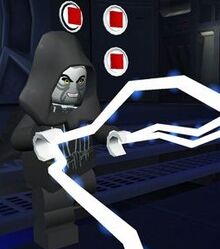| | |
Warning: This infobox has missing parameters: parents, pronouns, children, siblings, type, partners, families, feathers and unrecognized parameters: hidep, hidec, era, imageBG, hideb
- "Everything is proceeding as I have foreseen."
- ―Palpatine
Palpatine, also known as Darth Sidious, was a Force-sensitive Human male who served as the last Supreme Chancellor of the Galactic Republic and the first Emperor of the Galactic Empire. A Dark Lord of the Sith in the Order of the Sith Lords, recorded by history as the most powerful who had ever lived, his entire life was the culmination of a thousand-year plan to overthrow the Republic and the Jedi Order from within.
Born in 82 BBY on the planet Naboo to the aristocratic House Palpatine, Palpatine discovered the Sith at a young age as a collector of dark side artifacts. In 65 BBY, he met Hego Damask, a Muun businessman who was in reality the Sith Lord Darth Plagueis. Under Plagueis's manipulation, Palpatine killed his father and pledged himself to his new Master's dark side teachings as Darth Sidious. Palpatine lived a double life for many years, serving an untarnished career as Naboo's ambassador in the Galactic Senate while learning from his master and training a young Zabrak as the Sith assassin Darth Maul. Plagueis and Sidious, both exceptionally skilled and powerful in the Force, were able to conceal their identities from the Jedi for decades. As Plagueis privately searched for the key to eternal life, Sidious manipulated galactic politics, culminating in the blockade of Naboo by the Trade Federation. In the wake of the political crisis, the Galactic Senate voted to elect him as Supreme Chancellor, and around the same time, in accordance with Bane's Rule of Two, Palpatine murdered Plagueis and usurped the role of Sith Master.
As Chancellor of the Republic and Dark Lord of the Sith, Palpatine orchestrated the outbreak of the devastating Clone Wars ten years after the Naboo Crisis. He himself headed both the Galactic Republic and, secretly, the Confederacy of Independent Systems. The public leader of this splinter faction was former Jedi Master Count Dooku, Sidious' second apprentice as Darth Tyranus in the wake of Maul's presumed death on Naboo. As billions perished in the war, the vast majority of Republic citizens rallied behind Chancellor Palpatine, giving him enough support to amend the Galactic Constitution in the name of security and transfer most of the Senate's executive authority to his own office. In 19 BBY, following Tyranus's demise, Palpatine revealed his identity as Darth Sidious to the Jedi Knight Anakin Skywalker, telling that the dark side teachings that Plagueis had pursued could help Skywalker to save his wife, whom Skywalker had foreseen dying untimely. A failed attempt by the Jedi High Council to arrest Palpatine ensued, and Skywalker pledged himself to Sidious's teachings as Darth Vader. All members of the Jedi Order were accused of treason and betrayed by their clone troopers to the point of virtual extermination. Without the Jedi to oppose him, Palpatine declared himself Emperor of the first Galactic Empire, bringing an end to the Republic that had stood for over 25,000 years.
As Emperor, Palpatine effectively wielded absolute control over the entire galaxy and virtually everyone who lived within it. During his tenure, he built one of the most powerful military forces the galaxy had ever seen and ruled unopposed for nearly two decades. Palpatine progressively abandoned his facade of being an enlightened leader and began to rule through terror symbolized by the Death Star, a superweapon that could annihilate entire planets. However, he later discovered that Vader was training Galen Marek, an exceptionally powerful Force adept as a secret apprentice "Starkiller". When Palpatine discovered Starkiller's existence in 3 BBY, he forced Vader to fake Starkiller's death and then request that Starkiller assemble the most influential traitors in the Empire in a rebellion in order to highlight and destroy them all. Palpatine's plan backfired when Starkiller, healed from his near-fatal injuries and espousing the teachings of the light side, vowed revenge against Palpatine and confronted him on the Death Star, ultimately sacrificing himself in an act that inspired the dissident senators to create the Alliance to Restore the Republic. As the Galactic Civil War broke out, Emperor Palpatine ironically fought against a rebellion that he started in secret. After the Empire suffered a devastating defeat in 0 BBY, in which the Alliance destroyed the Death Star, the Emperor steadily began to lose his absolute control over the galaxy.
In 4 ABY, Palpatine gambled his chances in order to annihilate the Rebel Alliance once and for all, allowing Rebel spies to learn of the existence of a second Death Star and its secret location near Endor. As expected, the Alliance fell for the bait and dispatched its fleet to destroy the Emperor, Vader, and the incomplete Death Star. With the Alliance soon falling for his trap, Palpatine brought Luke Skywalker, the son of Darth Vader, before him in order to turn him over to the dark side and replace Vader with an apprentice who was younger and more powerful. After goading Skywalker to give into his frustrations with thoughts of the Alliance's defeat and the death of his friends, Palpatine eagerly watched as father and son fought one another. However, Skywalker refused to submit to the dark side and spared his father, prompting Palpatine to unleash all of his rage and hatred on Skywalker. Unwilling to stand by and watch his son die from the agonizing effects of Palpatine's Force lightning, Vader finally redeemed himself, throwing his astonished Master down the Death Star's shaft, a sacrifice that fulfilled the prophecy of the Chosen One and brought about the end of the Order of the Sith Lords.
Throughout the rest of the Galactic Civil War, the remnants of the Empire experienced a sharp decline while the Alliance reformed itself into the New Republic. However, Palpatine did not stay dead, and eventually used a rare and ancient Force technique to transfer his spirit into one of many clone bodies stored on the Deep Core world of Byss. In 10 ABY, Emperor Palpatine resurfaced in the galaxy in a bid to rebuild his Empire, temporarily converting Luke Skywalker to the dark side and installing him as his apprentice. Palpatine's efforts to live forever, however, were undermined by subversives within his own inner circle, including his Royal Guard Carnor Jax. With the last supplies of healthy clone bodies sabotaged and their genetic source material contaminated by his allies, Palpatine desperately tried to take over the body of Darth Vader's youngest grandchild, the infant Anakin Solo, in 11 ABY. Palpatine's spirit, however, was intercepted by the dying Jedi Knight Empatojayos Brand, who dragged the Sith Lord down into the depths of the Force forever.
Biography
Early life
- "I haven't rejected the dynasty I was born into. I've rejected the name I was given."
- ―Palpatine to Hego Damask
Palpatine was born on Naboo, the eldest son of the House Palpatine's patriarch Cosinga and his wife. He was raised in his family's ancestral home, Convergence, situated in Naboo's Lake Country, and had at least two brothers and two sisters.[1]
From an early age, Palpatine identified himself as different from his peers and siblings, recognizing a great power within himself, and believing that he was born to lead, which led to an uneasy relationship with his family. His father also perceived his eldest son as different, and would later claim to have divined his murderous nature from the time the latter was an infant. At some point early in Palpatine's life, Cosinga had his son tested to make certain that they were related. Until the end of his life, however, Palpatine's true nature would remain a mystery to his father.[1]
Intelligent and highly ambitious, Palpatine desired his family to take on a more active role in Naboo's politics, both to increase their own wealth and power, and also to help their homeworld make the transition into the modern galaxy. He was soon disappointed to learn that he was alone in this ambition, and that his father not only lacked the ability to improve his family's standing, but also arrogantly believed he had all the power there was to be gained. Cosinga's political ambitions never exceeded provincial Naboo—father and son attended two coronations in the capital city of Theed, and for years to come Palpatine would remember Cosinga's envy for the power the monarch wielded. Although Palpatine longed to kill his father, he grudgingly concealed his patricidal desires for years, hiding his true feelings under a mask of simple reactionary rebelliousness. Disgusted by his father's incompetence, and infuriated by his mother's willingness to tolerate the situation of their family, it was not long before Palpatine discontinued the use of his given name as an act of spite. From then on, he demanded to be referred to exclusively by the name of his aristocratic family.[1]
Palpatine was raised in Naboo's Lake Country.
Palpatine recorded, in his preface to the Book of Sith (c 19 BBY), that he took a vested interest in forbidden Sith lore as a child. Employing his family's vast wealth, the youth took to the black market, resolving to collect as many inscrutable runes and ancient texts as possible. Enraptured by the secrets revealed with each tome, Palpatine at once recognized the key to realizing his true ambition: the acquisition of absolute power. All that remained was opportunity.[14]
Education
- "The Naboo might expect more of the eldest son of House Palpatine."
"I ignore the expectations of others." - ―Hego Damask and Palpatine
Throughout his education Palpatine attended some of the most prestigious and exclusive academies in the galaxy, but would never remain for long, and would soon be expelled for some petty misdemeanor. Palpatine's list of offenses, while usually minor, was extensive enough that—were he anyone other than a nobleman's heir—he would have been imprisoned in a correctional facility. Sure enough, whatever his son's crime, Cosinga would be there, ready and willing to use his influence and credits to make it "disappear." Having been raised to believe that money could solve anything, Palpatine would quickly dispense with traditional notions of morality, instead forging a unique code of ethics for himself; a pedestal on which he placed himself, to be raised above all others.[1]
Although he despised his father, more so than any other member of his family, the two were not without their similarities. Aside from an inherited violent streak, both father and son shared an insatiable passion for speeder racing. Palpatine once fondly recounted an occasion from his youth when his father had bought him a state-of-the-art, prototype speeder, more as a bribe than a gift, but one he accepted, nonetheless. Indeed, the only time Palpatine thought well of the man who raised him was when they shared a cockpit together. This was not to last, however, as Palpatine would soon crash the machine, tragically killing two pedestrians in the process. As always, Cosinga bought his son a reprieve, and Palpatine himself never showed the slightest bit of remorse for the incident. Quite the opposite, in fact, if anything, the lack of punishment from the law only served to reinforce the boy's belief in his own invulnerability, and Palpatine insensitively chose this moment to announce his desire to become a professional racer. Cosinga initially banned his son from riding again, but even this feeble attempt at punishment did not last long. After many tantrums Palpatine wore his father down, who eventually relented, and Palpatine went on to race competitively, and successfully.[1]
Darth Plagueis and Darth Sidious
- "Tell me what you regard as your greatest strength, so I will know how best to undermine you; tell me of your greatest fear, so I will know which I must force you to face; tell me what you cherish most, so I will know what to take from you; and tell me what you crave, so that I might deny you…"
- ―Darth Plagueis
In 67 BBY, the Sith Lord Darth Plagueis murdered his Master, Darth Tenebrous, on Bal'demnic. Tenebrous's disembodied consciousness accessed his apprentice's body and Force senses through the maxi-chlorian retrovirus and saw a vision of the future, in which Plagueis's apprentice killed him before he had the chance to complete his life's work, which Tenebrous believed was the creation of the Chosen One. The Dark Lord panicked and abandoned Tenebrous's body. The mysterious apprentice in Tenebrous's vision was invisible to his Force sense, and he only perceived him as the shadow.[21] On Naboo, the young Palpatine was waiting for a chance to join the Sith,[14] and this turn of events was the first step towards bringing Plagueis to Naboo,[1] and, 35 years later, realizing Tenebrous's vision.[21]
First encounter
- "Palpatine."
"How do you know my name?"
"I know more about you than just your name." - ―Hego Damask and Palpatine
As an adolescent, Palpatine studied at Theed University, and also enrolled in the Legislative Youth Program in accordance with Naboo's mandatory public service curricula. His family's social status provided him with high profile contacts, such as other aristocrats and even government officials. One such acquaintance was Vidar Kim, who was at the time an aide to the Republic Senator of Naboo. Although Palpatine regarded Kim as a political mentor, he secretly harbored certain views that conflicted with Kim's opinions. Palpatine's own father shared Kim's conservative beliefs and lobbied for Naboo's government to maintain an isolationist policy in order to protect their homeworld from interplanetary corporations that wanted to take advantage of Naboo. Bon Tapalo, a candidate for the Naboo throne in the 65 BBY monarchical elections eager to open Naboo to outside influences, was their main opponent in the political arena.[1]
Palpatine, motivated by pride and a desire to see his homeworld become a part of the greater galaxy, sought to quietly undermine his father's political agenda during the 65 BBY election season. More importantly, however, it was the rift with his father that indirectly led to his future as a Sith. Palpatine released confidential information pertaining to the shady role certain royal houses (including, presumably, his own) in the Tapalo opposition had allegedly played during the mercenary conflict, despite the fact that he was well aware he could be disinherited for it. In aiding Tapalo's campaign, Palpatine brought himself to the attention of Darth Plagueis, Dark Lord of the Sith.[1] The young man had craved for the power of the Sith since becoming a collector of Sith artifacts, and soon he would have his chance to join their order.[14] Plagueis was publicly known as Hego Damask, the Muun Magister of Damask Holdings, one of the galaxy's most powerful and influential financiers and political lobbyists. Having survived an assassination attempt by an unknown party on Bal'demnic and having killed his Master during that same incident, he was also the reigning Dark Lord of the Sith in Darth Bane's line.[1]
Plagueis learned from certain Gossam members of the Subtext Mining Group—the company that supplied the mining probe that was supposed to kill himself and Tenebrous on Bal'demnic—of a plasma reserve they had recently discovered under Theed. After ordering the Gossams' deaths, Plagueis instructed Larsh Hill of Damask Holdings to look into the situation. Hill contacted Tapalo, offering to support his bid for the throne in exchange for exclusive rights to transport the plasma from the Theed reservoir. Palpatine, by joining the covert war fought in the Naboo media for the public eye, had turned Damask's eyes on him—members of Damask Holdings traced the release of the information to the heir of House Palpatine, and Plagueis decided to meet this young noble who had helped him from afar. The Dark Lord arrived on Naboo in his public guise as Hego Damask and sought out Palpatine in Theed University. After asking after him, Plagueis eventually found Palpatine outside the Youth Program's headquarters in the university campus.[1]
Though he was aware of Damask's reputation, the haughty Palpatine initially had little interest in conversing with the Muun. Through a small effort of persuasion on Plagueis' part, however, Palpatine reluctantly agreed to give him a tour of Theed. Plagueis was able to learn much about the young aristocrat in their first encounter; Palpatine had an interest in politics, but was shy to admit it; he enjoyed art, yet his modest tastes made him disinterested in Naboo's grandiose architecture style; the estrangement with his father was augmented by their different political opinions. Aside from art and politics, Plagueis also learned that Palpatine had a passion for expensive landspeeders and competitive racing. But he was unable to peer into the young man with the Force, which intrigued him. At the end of the day, Plagueis offered to recruit Palpatine as a spy in order to advance the interests of Damask Holdings by ensuring the election of Tapalo as king of Naboo. Palpatine accepted the offer, but only on the condition that he would report directly to Plagueis alone.[1]
Initiation
- "It is my will to join my destiny forever with the Order of the Sith Lords."
"Then it is done. From this day forward, the truth of you, now and forever more, will be Sidious." - ―Darth Sidious and Darth Plagueis
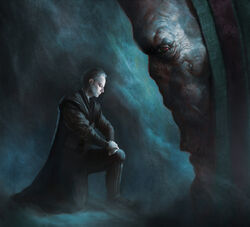
A young Darth Sidious kneels before his Master, Darth Plagueis.
Cosinga Palpatine eventually learned of his eldest son's friendship with Hego Damask. Due to his estrangement with the younger Palpatine, as well as Damask's support for Tapalo's bid for the throne, Cosinga immediately attempted to thwart any further contact between his son and the head of Damask Holdings. After Cosinga failed to coerce Damask with veiled threats, the Muun contacted Palpatine, who had been away on Chandrila with his class at the time. Palpatine, enraged by the revelation of his father's attempt to interfere in his affairs, desperately implored Damask for advice. Recognizing the potential that emanated within his young protégé, Damask took advantage of Palpatine's fear and hatred for his family, and thus insinuated that he had to do whatever it took to become emancipated from his father's control.[1]
Palpatine's defining moment came when his father personally journeyed to Chandrila with the entire family in tow to retrieve his heir. Once the family yacht had left Hanna City Spaceport, Cosinga and his son clashed. In order to keep him away from Naboo during the elections and out of Damask's reach, Cosinga planned to send his son to Chommell Minor, where he would stay with the Greejatus family and complete the Legislative Youth Program locally with Janus Greejatus. Palpatine did not accept the arrangement, and verbally attacked Cosinga. The altercation brought out their long-standing yet barely concealed hatred for each other, until Cosinga revealed to his son that he had wanted to kill him from the start. Overcome by years of repressed anger and frustration, Palpatine instinctively drew upon the power of the dark side and slaughtered his entire family and their security guards. When the deed was done, he contacted Damask and was assured by his mentor that none would ever learn of his role in the slaughter of House Palpatine. Damask arranged for all evidence of the crime to be purged, and for Palpatine to return to Chandrila. In addition, Palpatine later sold Convergence and moved to a modest apartment in Theed. One standard week later, they met in a luxury cabin aboard the Quantum Collosus.[1]
Having judged the young Palpatine worthy of joining the Sith after he murdered his family, Darth Plagueis formally initiated him into the cult.[1] From the time of Darth Bane onward, it was common for Sith names to begin with the forename Darth, a moniker that was as much a title as it was a name.[22] Many factors went into deciding on the second name. At least one, based on observed ceremonies, is that Sith masters would enter a kind of communion with the dark side of the Force, question it, and within it find inspiration, an answer.[23] In Palpatine, Plagueis saw a being completely lacking in empathy, ambitious, arrogant, and insidious. Palpatine genuflected before his master, pledged his undying allegiance to the Sith Order, and the Dark Lord of the Sith proclaimed him his new apprentice under the name Darth Sidious.[1]
Apprenticeship
- "My mentor taught me everything about the Force, even the nature of the dark side."
- ―Palpatine to Anakin Skywalker
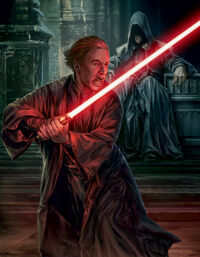
Darth Plagueis oversees the training of his young apprentice.
The training of Darth Sidious was focused on the honing of his Force abilities and combat skills, as well as his natural talents as a politician. In the first decade of his role as an apprentice, Sidious accompanied his Master to Mygeeto, where he was subjected to intense cold and nearly froze to death. Darth Plagueis, unaffected by the planet's freezing temperature, forced Palpatine to relate the slaughter of his family in exacting detail, as he did many times, with the goal of extinguishing any lingering feeling of personal connection. The Sith Lord's overall goal was to use his disciple's hate, anger and desperation for survival as a tool to destroy any vestiges of Palpatine the young noble from Naboo, and in his place create Darth Sidious, a true Sith. Were Palpatine to give up, he would prove himself unworthy of the mantle; the young Human endured, asking only when the trials would be over. Plagueis also demonstrated a use of the mind-clouding technique by having his apprentice struggle to reach him, only to discover he had been a dopplegänger, and also subjected Palpatine to deprivation of food, water and sleep.[1]
In regard to the history of the Sith, Plagueis was more than aware of the fact that Sidious' desire to kill him would grow in time; only a true Sith Lord wanted to seize the mantle of Master by slaying his own mentor. But like many of his Sith predecessors, Plagueis was appalled by Darth Bane's Rule of Two, more specifically its tenet that commanded each Master to train his or her own eventual killer. Plagueis had no intention of dying by his apprentice's hand, or anyone else's for that matter. Instead, he intended to break the cycle started by Bane and Zannah a millennium ago. In order to do so, Plagueis wished for no secrets or feelings of jealousy and mistrust to exist between Sidious and himself. In the long run of the Sith Grand Plan, Plagueis envisioned himself as the "power behind the throne" while Sidious—in his public guise as Palpatine—carried out the Sith's interests in the political domain.[1]
Sidious, ever the academic with a desire for knowledge, yearned to learn more of the Sith lore. However, his Master carefully concealed much information from his apprentice, and only intended to share his full knowledge at a gradual pace, depending on how much Sidious progressed as a Sith Lord. Among Plagueis' artifacts were holocrons that contained much of what Sidious desired to know.[1] The Jedi mistakenly believed that these holocrons sat in the Archives room in their Temple, but those were actually clever forgeries, a form of Sith disinformation.[24]
The beginning of Palpatine's political career
Palpatine began his political career at a young age, carefully hiding his true persona of Darth Sidious. On Naboo, public service was mandatory from the ages of twelve to twenty, and he began his political career in this fashion (presumably 70–62 BBY). Unlike most of the Naboo, however, he elected to stay in public service beyond the normally accepted age and entered local Naboo politics (62–52 BBY), working his way upward.[18] After a five-year stint in the Apprentice Legislator program, he was appointed Ambassador in the reelected Senator Vidar Kim's retinue.[1] Palpatine lost more elections than he won in his early political career, missing out on a string of political appointments.[25] He elected to keep a low profile so as to not undermine his Sith master, and to allow him to discreetly disappear from the radar in order to focus on his Sith training on such worlds as Mygeeto, Hypori, Buoyant and Kursid, and rendezvous with Plagueis on remote planets where they did not have to risk being seen together by beings from the political sphere.[1]
The training of Darth Maul
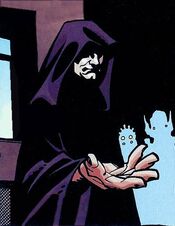
Darth Sidious at the time he met Darth Maul.
- "Do you feel the hate? … It is the source of your strength. You still hate me. No matter. Today you have delivered yourself into my hands. I have the power of life and death over you, Maul. Someday, you will hold that power over another. It is the honour of the Sith. You will devote yourself to the idea of domination."
- ―Darth Sidious
During his apprenticeship under Plagueis, Sidious was given an infant Zabrak[26] by the child's Nightsister mother on Dathomir[1] and trained him as a Sith assassin. It was not without precedent that Sidious should have chosen a Zabrak for his apprentice. In ancient times, the Sith, taking notice of the martial prowess of the Zabrak, made lucrative contacts on Iridonia, and spent exorbitant sums to hire Iridonian Zabrak as mercenaries. Long after the Sith culture died out, the influence of the Sith remained a part of Zabrak culture.[27] Zabraks were known to endure extreme amounts of pain, but nothing could have prepared young Maul for the brutality of Sidious' training. Despite Sidious' harshness, Maul held the utmost respect for the man, and was fanatically loyal.
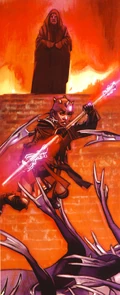
Darth Sidious oversees the training of his young apprentice.
When Darth Maul was very young—so young that he would remember few memories prior to this—Darth Sidious took him to the Jedi Temple, both of them disguised as tourists. Sidious' command of the dark side was sufficient to keep both himself and Maul from being sensed by the Jedi, as long as they did not enter the Temple itself. As the building was not open to tourists, there was very little risk of discovery. For the better part of a day, they stood there, and Sidious pointed out to Maul the various faces of individual Jedi as they entered and left the Temple, whispering into his apprentice's ear of the Jedi Order's ultimate destruction. Maul would long remember the thrill of seeing his foes, standing in their presence, hearing about their downfall, as they walked past, not one of them aware of the fate that ultimately awaited them.[28]
Eventually, the time came for Maul's final test. Palpatine sent him out to a remote and isolated world, where he was hunted by assassin droids for a month. At the end of the month, Maul found Palpatine waiting at the mouth of a cave. Maul had not eaten for days, and was exhausted. Regardless, Palpatine challenged Maul to a duel, in which Maul was easily defeated. Palpatine stood over the broken man, and told him that he had been preparing another apprentice, should Maul fail as he had. Enraged, Maul flew at Palpatine with murderous intent. Palpatine was caught off guard, but was able to disarm Maul. Even without a weapon, Maul continued to attack, even going so far as to bite Sidious's hand before being ultimately defeated. Pleased, Sidious announced that Maul's training was complete, and that he was now a Sith Lord.[29]
The rise of Senator Palpatine (52–32 BBY)
- "This Palpatine was a Rodian in Ewok's clothing!"
- ―Mon Mothma
Around the year 52 BBY, as a critical vote on seating several "client worlds" of the Trade Federation approached, Darth Plagueis and Palpatine decided during a Gathering on Sojourn that the galaxy was ripe for more direct forms of manipulation. The stage of decadence required by the Grand Plan had been reached—disaffected with political corruption, both the citizens of the Republic and the beings of the lawless Rim yearned for strong central leadership; for tyranny. So, in order to place Palpatine in the Galactic Senate, Plagueis ordered his apprentice to arrange the assassination of Senator Vidar Kim. To this end, Palpatine availed himself to the services of a professional assassin named Sate Pestage, a man who would later become one of his most trusted agents. Palpatine's only stipulation regarding Kim's assassination was that it be an obvious and publicly witnessed murder.[1]
When Senator Vidar Kim was assassinated by a never-identified Maladian gunman on a passing airspeeder in 52 BBY, the thirty-year-old Palpatine stood for election to succeed him. However, the assassination had nearly been a disaster thanks to the presence of Vidar Kim's son, Jedi Knight Ronhar Kim. The Maladian had attempted, for reasons unknown, to kill both Kims, and while she had succeeded in killing Vidar, Ronhar had escaped her attack and captured her. Fortunately for Palpatine, the assassin committed suicide before she could be interrogated by the Jedi Knight, and Palpatine's role in the affair was never revealed. The people of Naboo elected him as their sectorial Senator, to represent Naboo and the thirty-five other affiliated worlds of the Chommell sector.[1][30][30]
When Palpatine first came to Coruscant to begin his service in the Senate, a number of his personal effects came with him from Naboo, accompanied by a manifest. The manifest was submitted to Republic officials as part of a standard security scan. This procedure was mandatory for all equipment and furniture to enter the Senate building.[23] One of these items was an abstract sculpture of Sistros, one of the Four Sages of Dwartii (these were controversial philosopher-lawgivers who lived during the early days of the Republic—the others were Faya, Yanjon, and Braata).[31]
Palpatine's manifest clearly stated that this sculpture was a single piece of solid-forged neuranium with a bronzium finish. But the sculpture was not solid; it contained a small cylindrical cavity, in which rested one of his Sith lightsabers, sealed within the sculpture at the time of its forging. The security scan did not detect this cavity; neuranium was so dense that any piece more than a millimeter in thickness was impervious to sensors, and since nothing unusual was found in the scan, no one questioned it further. An advanced gravimetric detector would have revealed that one small section of the sculpture massed slightly less than it should have, but no one thought to use one at the time. The sculpture was admitted and placed in Palpatine's Senate offices (the floor had to be specially reinforced to bear its weight), and when Palpatine was elected Chancellor it was moved into the anteroom of his Suite in the Executive Office Building. Only after thirty-three years would Palpatine extract the blade within.[23] In addition, he also gave his interior decorating the color crimson. He also used his family status as a convenient excuse for utilizing that as the color of choice (as his family prominently used crimson for their seal).[1]
The senator's first "friendship"
- "Through me, you might have a voice in the shaping of the Republic. Through you, I better understand the Jedi and their ways."
- ―Palpatine to Ronhar Kim

Palpatine at age thirty, at the time of his election as Senator of Naboo
The new representative of Chommell sector wasted no time in forming relationships that could help him in the future. The first was the son of the man whose death ensured his own election. Ronhar Kim, who had been with his father at the time of the assassination, had attended the funeral despite both having hardly known Vidar and having had little interest in forming a relationship with him. Palpatine approached the younger Kim even as he stood before his father's body, and under his mask of sorrow and condolence, he studied Kim carefully.[30] But he said little; instead, he demonstrated an art that would serve him well, and give him access to the powerful: his ability to listen, to serve as a confidant for others.[32]
During their conversation, it quickly became clear that, rather than finding whoever struck down the father he had barely known, Kim was more concerned about himself and his own choices in life. In fact, Ronhar appeared to be more preoccupied by his personal failure to detect and thwart the assassin than he was with the fact that his father was now dead. Vidar Kim, lacking any other living family, had wanted his son to honor his bloodline by following him into politics. With Ronhar apparently giving the matter some serious thought, Palpatine quickly suggested that for a Jedi to become a politician would be a waste. Instead, perhaps the best course would be an alliance between a Jedi and a politician.[1][30]
Kim agreed, and struck up a "friendship" that would last some three decades.[1][30] Ronhar Kim would be the first of Palpatine's "alliances" with individual Jedi, but this particular alliance would be of great use. Kim would eventually be used as a pawn in a scheme that resulted in the creation of the feared Red Guards (32 BBY), and his eventual death in battle on Merson (21 BBY) would be used as propaganda fuel to further Palpatine's war aims.[30]
Palpatine in the Senate
By the time Palpatine stepped onto the Senate floor for the first time, he already knew that the prominent power-brokers in the Senate looked down their noses at the more provincial delegates, expecting little to nothing of importance from them. He knew that he, too, was lumped in with the other hopefuls from Rimward worlds, those who, having never ventured far from their homeworlds before, would in short order be overwhelmed by Coruscanti politics.[18]
Rather than do anything to prove the elites wrong, Palpatine encouraged them to keep thinking this way. Again, he failed to take advantage of opportunities that could have landed him on important advisory boards and powerful committees, and unless pressed, he never shared his observations with his colleagues.[33] Instead, he purposely sought to keep his advancement slow, knowing that the more he did so, the more harmless he seemed to potential rivals. The performance evidently worked; the powerful Senators, wrapped up in their own petty power struggles, initially laughed at the small and quiet provincial, and otherwise paid him no mind.[34]
Palpatine surprised everyone as he became increasingly popular. He wrote extensively, his notes on power became popular texts among political and military science students. Soon, his theories became well known enough for them to be taught at leading universities throughout the galaxy. Despite this growing influence, Palpatine remained unassuming, and would spend many hours alone reflecting in his modest, yet well-appointed quarters. People remarked on how he remained a private man, rarely attending social functions, devoting all his time to his work. In fact, he spent much of his time in the training of Darth Maul and the furthering of his private Sith agendas;[18] it was left to his senatorial aides and to droids, such as TC-4[35] to do much of the day-to-day work and maintain his guise as the mild-mannered representative of Naboo.[18]
Friends and allies
Senator Palpatine wasted no time in establishing relationships with respected public figures in key positions of government. As it grew, the list of friends included Senators both weak and powerful, military officers, members of the great organs of commerce, and even members of the Jedi Order. Many of those with whom he formed friendships would eventually have prominent positions in the Empire, the most loyal of whom were rewarded with power, prestige and gifts such as worldcrafts, personal artificial planetoids.[36] Others would meet radically different fates.
Palpatine served as part of a Republic task force sent to monitor the demilitarization of Ando, where the two native species had resumed a long-standing feud over mining rights. It was here that he met Jorus C'baoth, a Jedi who was also a member of the expedition. Palpatine took advantage of the encounter to establish what would become a long-standing "friendship" with C'baoth. Upon returning to Coruscant, they often met to discuss politics, philosophy, and the state of the Republic. Eventually, at Palpatine's request, the Jedi Reassignment Council sent C'baoth to act as his personal advisor, and C'baoth became part of his staff. One thing they discussed during their time together held promise for the future: they spoke of the ExGal Society, a small, dedicated group of scientists studying the possibilities of life outside the galaxy, and the idea of an excursion beyond the Galactic Rim. It would be conversations like this that would result in the ill-fated Outbound Flight project.[37]
Janus Greejatus, then a politician on Chommell Minor, had established himself as an isolationist—in fact his political language concealed a virulent anti-alien prejudice that stemmed from his earliest formative years—with a significant popular following on his homeworld. The Greejatus family had had friendly relations with House Palpatine of Naboo, and Cosinga Palpatine, based on the rapport he perceived between his son and Janus Greejatus, had decided to send Palpatine to stay with the Greejatuses in 65 BBY. Years later, Palpatine became senator, and Greejatus came to his attention as a result of his political achievements on Chommell Minor. Palpatine did not echo Greejatus's more divisive statements, understanding that they would only do harm to his own long-term plans, but he did see a use for Greejatus and took him under his wing.[1] Palpatine's own feelings are a mystery, but Greejatus labored under the impression that theirs was a firm friendship. That friendship, if such it was, would endure for more than three decades.[38]
Commander Terrinald Screed, then a young officer in the Republic Judicial Department, was contacted by Palpatine, and found that his own ideas easily meshed with those of the Senator.[18] With the coming of the New Order, Screed, now an Admiral, would become one of the highest-placed officers in the new Imperial Navy.[39]
Lieutenant Governor Wilhuff Tarkin, a government official on Eriadu who was descended from a ruthless and ambitious family, was contacted by Darth Sidious, who convinced Tarkin that they actually shared many of the same sentiments on government. It is not known for certain if Tarkin ever was aware that Palpatine and Sidious were the same person, but he served both faithfully and long.[18] Even as the New Order was inaugurated, Tarkin was placed in charge of the construction of Palpatine's most secret weapons projects.
Lord Crueya Vandron, the head of a noble house in the Senex sector, also secretly joined Palpatine's camp.[32] After the Empire was inaugurated, Vandron would become an advisor and the head of COMPNOR.[33]
In addition, Senator Palpatine brought his own loyal aides with him from Naboo and elsewhere. They served him in legitimate political and legal roles, but they also worked his will in darker and more secretive ways. It would be these functionaries who earned the greatest rewards (with the exception of Palpatine's Sith accomplices) that could be bestowed in the New Order.
Sate Pestage was one of Palpatine's most useful assets, and perhaps his longest-serving ally. Initially, he was contracted by Sidious as an assassin, a profession that he apparently excelled at. After Pestage arranged the murder of Senator Vidar Kim on Palpatine's orders, Palpatine took him on as an aide, and Pestage would retain this dual function throughout Palpatine's rise to power. He typically performed the day-to-day duties of a senatorial aide, but he also was fully aware of Palpatine's secret identity of Darth Sidious and willingly served Sidious as a covert operative. Palpatine treated Pestage's colleague, Kinman Doriana, in a similar fashion. Doriana had something of an unspoken wish to be a spy, and Sidious indulged this by assigning him to perform covert work, but unlike Pestage, Doriana was not informed of the secret connection between Sidious and Palpatine.[1] As far as Doriana was aware, they were separate people, and he performed tasks for both without realizing the truth. Ars Dangor was also an aide to Senator Palpatine at this time.
Destabilization
In 33 BBY, Sidious's shadow ally, Lieutenant Governor Wilhuff Tarkin, helped Sidious to engineer the murder of the Trade Federation Directorate, which were on Tarkin's homeworld of Eriadu for a trade summit. The pirate raids on the Trade Federation that had led to the summit had also been orchestrated by Palpatine, as was Nute Gunray's rise to power as Viceroy.[32]
Shortly afterward, Palpatine secretly arranged to have several million credits, believed to have been stolen by the criminal orginization Nebula Front, funneled through the Bank of Aargau and into the accounts of House Valorum. Sate Pestage ensured that the exchange was uncovered by Valorum's political enemy, Senator Orn Free Taa, who revealed it to the Internal Activities Committee. This action served to critically weaken Chancellor Finis Valorum's already tenuous hold on power.[32]
During this time, Sidious also made his first attempt on his master's life. Sidious, as Palpatine, contacted Veruna and manipulated him into allying with Black Sun, which ultimately culminated with Black Sun annihilating Damask's personal residence on Sojurn with a nuclear weapon. However, Sidious had not anticipated that Plagueis had an ally in the form of the Hutt gangster Jabba Desilijic Tiure, who warned him of Black Sun's plans and enabled him to escape. He managed to cover up his involvement to Plagueis, only revealing his role in the assassination plot a year later when he made a second, successful attempt.[1]
Around the same time as the doomed trade summit, Palpatine and Plagueis arranged for former Naboo king Ars Veruna to abdicate the throne, as a means to ensure the already irate Neimoidians would become even more enraged at the circumstances, and as revenge for his role in Plagueis' near death. Palpatine initially intended to send Maul to kill him, but Plagueis decided instead to personally ensure his death. Due to this turn of events, Palpatine also was responsible for the coronation of Padme Naberrie/Amidala.[1]
In 32 BBY, Sidious convinced the Neimoidian leaders of the Trade Federation to blockade the planet Naboo, in protest of Senate resolution BR-0371,[40] a measure that levied a tax on the major Rim trade routes. Sidious kept his identity of Palpatine unknown to the Neimoidians, although he revealed that he was a Sith Lord and made it quite clear that he held some power in the Senate.[32]
Final preparations
Before the first overt moves of the Grand plan could be initiated, Palpatine and Plagueis first had to deal with a variety of rogue dark side practitioners and organizations. The Sun Guard[41] and the Dark Force practitioners were all brought into line, and under Palpatine's direct control. The Dark Force adherents, who were led by former Jedi Master Kadann, would later be reorganized by Palpatine as the Prophets of the Dark Side.[41]
The Naboo crisis (32 BBY)
- "At last we will reveal ourselves to the Jedi. At last we will have revenge."
- ―Darth Maul speaking to his master
With the lose ends that were the Sun Guard and Dark Force practitioners now tied off, the Sith moved to initiate Palpatine's rise to the Chancellorship. The Trade Federation was now angered, threatened, and led by weak individuals who were under Sith control. Chancellor Valorum had virtually no political power left at his disposal and, just as importantly, he counted Palpatine as a close friend and ally, allowing for Palpatine to easily manipulate him. And, finally, the monarch of Naboo had been replaced by an inexperienced and impressionable child. Palpatine now had control of every side of the proverbial game board; it was time for the next round to begin. Palpatine's opening move would be the instigation of the Naboo crisis; the point where all the other plots intersected, and the beginning of the end for the Republic.
The blockade of Naboo

Senator Palpatine of Naboo during the Naboo conflict
The Trade Federation rapidly built up its forces in the Naboo system, assembling enough battleships to ensure a tight blockade. At Sidious's command, they closed the planet off and strangled its formerly thriving trade business. No supply ships were permitted to land or take off. The Federation then secured the outer gate to the system by stationing a battleship at Station TFP-9, its own outpost at the outer edge of the system, to ward off the curious and advertise the act to all who would listen. The last free entrance was closed off, and all incoming ships were informed that the Federation was acting in protest of the illegal taxes that the Republic had levied against them.[42] The blockade of Naboo was an accomplished fact.
For the next month,[43] the Senate debated fiercely, but did nothing to help the Naboo. The Federation's representative, Lott Dod, successfully argued that they had not yet violated any Republic laws; they had attacked no ships, nor had they moved against Naboo itself. As no outright crime had been committed, the Judicial Department was powerless to intervene.[42] The stalling further weakened the Valorum government; their defiance of his measures was in itself damaging, but the longer it went on, the more impotent Valorum appeared. Partly to allow this perception to widen, Palpatine kept his monarch, Queen Amidala, from disrupting his plans, urging her to be patient and wait until the Senate reached a decision.[43]
Amidala proved harder to rein in than expected: her patience spent, she contacted Valorum and told him that she held him personally responsible for her world's suffering.[43] Shocked, pushed into a corner by his own conscience, and desperate to shore up his crumbling support, Valorum decided to act. He would call for a special session of the Senate to discuss the blockade, but to give him a strong bargaining position, he needed the battleships sent away from Naboo. He decided to send the Jedi to Naboo as ambassadors, hoping they would shake the Neimoidians' confidence and show them he meant business.[42]
The invasion of Naboo
The blockade of Naboo did not have the effect that the Sith Lords wished it to have on the Senate. They had been hoping to use the blockade to increase Palpatine's chances at securing the Chancellorship by creating an up-swelling of sympathy for the already popular Senator. However, as the Federation's actions still toed the line of legality, the Federation's move was seen by most in the Senate as little more than harmless saber rattling. As such, Palpatine and Plagueis decided that an invasion of the planet by the Federation was nessecary to give the Senate the final push it needed to elect Palpatine.
In the midst of this planning, Palpatine learned that the Chancellor had arranged for two Jedi ambassadors to meet with the Federation leadership with the intent of forcing a settlement. As the recent corruption scandal had seen Valorum stripped of the authority to send judicials or Jedi anywhere, Palpatine was surprised to discover that Valorum had apparently gone behind the Senate's back to send Jedi Master Qui-Gon Jinn and his Padawan Obi-Wan Kenobi to the Naboo system. When the panicked Neimoidians told him, he fought hard both to manage his own anger and to get the Neimoidians under control, to focus them on the next task. The Jedi had been brought into the picture sooner than he would have liked, and Sidious ordered the Neimoidians to begin landing their troops. When Gunray questioned the legality of such an action, Palpatine angrily told him that he would simply make it legal, and he ordered the Jedi to be killed. The Neimoidians acted accordingly, destroying the cruiser that had delivered the Jedi and immediately jamming all communications to and from Naboo. Then, the conference room the Jedi were in was flooded with dioxis, a lethal poison. However, the Jedi survived the assassination attempt and escaped the Federation ship. Gunray, for fear of Palpatine's wrath, neglected to tell him this, though evidently Palpatine discovered it soon afterwards. Immediately after Palpatine terminated his communication with Gunray, Amidala contacted him concerning the Federation's denial that the Chancellor had sent ambassadors to speak with them as promised. Palpatine feigned concern at this supposed revelation, but was cut off in mid sentence by the Trade Federation's communication blackout; a prelude to their invasion.
The Federation's assault proceeded splendidly. Within a day, most of the major cities, including the capital, were in Federation hands. Additionally, Amidala was captured along with her entire retinue, and the Neimoidians presented her with a treaty that would bring an air of legitimacy to their invasion. But she never signed it; instead, the Jedi, far from being dead, had snuck down to Naboo, rescued Amidala and her retinue, commandeered a ship bound for Coruscant, and successfully evaded dozens of heavily-armed battleships to escape. When Gunray informed Sidious of this shortly thereafter, the apparently livid Sith Lord introduced them to Darth Maul. But despite the displeasure Sidious showed to his Neimoidian agents, Amidala's escape did not inconvenience him. The invasion of Naboo was nothing more than a means to an end, and the success of the Federation's actual occupation was immaterial to him. Regardless, as Naboo's Senator and Amidala's close advisor, he knew that Amidala would most likely contact him as soon as she was able to.
The search for Queen Amidala
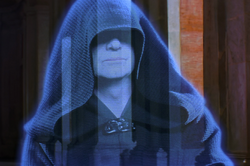
A hologram of Darth Sidious during the Naboo conflict.
Due to Amidala's ship sustaining damaged in the escape, Jinn and Kenobi recommended that they land on Tatooine, an obscure desert world in the Arkanis sector, to repair the ship before going on. Amidala agreed, and she signaled Palpatine upon landing. She informed him that the ship had been damaged, was waylaid (she did not say where, in case the Federation was monitoring her communications) and that they would arrive after making repairs.[44] Palpatine could now have the signal traced to find out exactly where she landed. He handed the signal data over to Maul, and in a very short time they had narrowed the search to Tatooine.
The Neimoidians too tried to track Amidala, crafting a desperate-sounding message from Sio Bibble to be sent to her ship. They failed to get anything of use, but, desperate to stay in Sidious's good graces, they reported their scant findings. Maul knew the arid world had a small population, and predicted that his search would be a short one. Sidious told him to move against the Jedi first, and then take the queen once they were dead.
Maul left for Tatooine, but he failed to kill the Jedi or retrieve Amidala. Soon after, Palpatine was surprised to find the queen arriving on Coruscant, which appeared to have disrupted Palpatine's original plans. One of Sidious's more trusted non-Sith agents, Kinman Doriana, who was present for these events, indicated—or at least believed—that the original plan had been to use the occupation of Naboo, which they expected to last for months or even years, to create turmoil and paralysis in the Senate, which Sidious and his agents could have used to devastating effect.[22] The eventual goal, to lever Palpatine into the position of Chancellor, would likely have been achieved nonetheless, but more gradually. With Amidala's unexpected appearance, that plan was no longer an option. Palpatine knew that Amidala would do everything in her power to bring the Naboo Crisis to a swift end, and in doing so would give a powerful and convincing voice to the elements of the Senate that wished for the same thing. However, Amidala's arrival had provided Palpatine with another, more effective avenue of attack.
For some time, he and Plagueis had been contemplating ousting Valorum from office before his term had come to completion, whittling away at the Chancellor's power and political prestige through actions such as the Yinchorri Uprising and a recent corruption scandal involving his family's company. The Sith's machinations had left the hapless Chancellor appearing corrupt and ineffectual, with virtually no friends or allies left in the Senate. As the situation stood, Palpatine knew that the Senate would embrace any opportunity to do away with Valorum, and Amidala's arrival had provided him with the means to give them exactly what they wanted.[1]
The Senator commands the monarch
Shortly after Amidala's arrival, Palpatine requested an audience with her in his apartments at 500 Republica to go over strategy. He had spent the last six months cultivating the queen's trust, knowing she would heed him better than Ars Veruna would have. It was all for this moment, when, in a crisis, she had no other choice than to rely on him. She had come believing the Senate would help her, but Palpatine slammed the door in her face by announcing, with mock disgust, that the Senate was long past caring about the common good. Worse, he informed her that the corruption scandal had politically weakened Chancellor Finis Valorum to the point that he was essentially powerless. With both the Senate and Valorum closed off to her as options, she was left with nothing but the choices Palpatine offered.
He gave her two: she could move for a Vote of No Confidence in Chancellor Valorum, and push for the election of a more effective leader, or she could take the matter to the courts. In offering her this choice, Palpatine risked nothing. Amidala had pinned her hopes on a quick resolution of the crisis. The longer Naboo starved under Federation occupation, the more her people would suffer. As the courts took even longer to make decisions than the Senate, Palpatine had given her an option he knew she would never choose, could never choose.
Amidala now had to decide between working in the courts, while the death toll on Naboo rose to horrific numbers, or heeding her trusted Senator's advice. More specifically, she had to choose between Valorum or her homeworld. As expected, she chose Naboo. Only fourteen and still new to the throne, she had all the qualities of the great leader she would eventually become, but little experience. If Palpatine, who knew how the Senate functioned in ways she did not, said that Valorum had become an obstacle, that was enough for her.
The fall of Chancellor Valorum

Palpatine and Queen Amidala just before the latter called for the Vote of No Confidence on Chancellor Finis Valorum.
- "Enter the bureaucrats, the true rulers of the Republic, and on the payroll of the Trade Federation, I might add. This is where Chancellor Valorum's strength will disappear."
- ―Palpatine to Queen Amidala
The long-anticipated special session of the Senate—the last under the Valorum government—had only two items on its agenda: a hearing of the Naboo delegation's case, and a debate on the Trade Federation's continued opposition to BR-0371. Few expected it to be anything other than routine; Palpatine alone knew what was coming. He knew that the Federation's representative, Lott Dod, would stall the proceedings with every procedural tool at his command. He also knew that the vice chair, Mas Amedda, would keep Valorum shackled by procedure no matter what. And he knew that, in the face of an attempt to stall, Amidala would have no choice but to act as he had suggested.
During the session, Dod and his allies threw up objection after objection; Amidala, unable to even finish her plea, grew more and more frustrated. Finally, Dod moved that a Senate committee be created to determine if her "accusations" were valid - a proposition that was further supported by Senator Aks Moe of Malastare. Amedda then pulled Valorum aside, subtly forcing him to concede that Dod was within his rights. When Valorum then asked Amidala to defer her motion to allow the committee to do its work, it was the last straw. She saw with her own eyes that Palpatine was right—Valorum was ineffective—and she had nowhere left to go. Palpatine hid his satisfaction as, next to him, Amidala delivered the words that sealed Finis Valorum's fate.
- "I will not defer! I have come before you to resolve this attack on our sovereignty now! I was not elected to watch my people suffer and die while you discuss this invasion in a committee! If this body is not capable of action, I suggest new leadership is needed. I move for a Vote of No Confidence in Chancellor Valorum's leadership."
- ―Queen Amidala before the Galactic Senate in 32 BBY
Valorum was thunderstruck, but by the time he could recover, events had moved past him. Senator Edcel Bar Gane of Roona immediately seconded Amidala's motion, and the vote was on the floor - within moments, hundreds of Senators were demanding the vote take place. The Senate had waited for this for months, perhaps years, and so unpopular was Valorum that they descended upon him without mercy, demanding a vote. It was all the Chancellor could do to postpone the vote until the following day. Palpatine already knew it would be a vote the Valorum government would not survive. It now remained only for him to ensure that he would be the one filling Valorum's shoes.
The scramble for the chancellorship

A portrait of the Chancellor
- "I feel confident that our situation will create a strong sympathy vote for us. I will be Chancellor."
- ―Palpatine
The sudden power vacuum left a choice for the two major factions in the Senate. The loyal Senators saw the danger of an unstable government and sought to elect a strong leader to truly clean up the corruption in the Senate. The corrupt Senators wanted stability too, if only so they could continue plundering the system, and sought a figurehead who would provide the appearance of stability and just look the other way while they fattened themselves. Bail Antilles, representative of Alderaan, was the choice of the loyal Senators, while Ainlee Teem, representative of Malastare, was the choice of the corrupt Senators. These two nominations came as no surprise; both had been campaigning for months, even before the corruption scandal.
Much of the back-room politicking that led to Palpatine's nomination has been lost to history. What is known is that he had been working for months to catch the attention of an influential clique in the Senate, led by Senator Orn Free Taa of Ryloth. Taa was not satisfied with Teem or Antilles. As early as the breaking of the corruption scandal, Palpatine had caught Taa's eye as a potential compromise candidate.[32] From Taa's point of view, it made sense: Palpatine had few enemies in the Senate, and many friends, ensuring that all factions could work well with him. In addition, Plagueis, in his disguise as Hego Demask, began calling in all the favors owed to him by various galactic power brokers to help ensure Palpatine's election.
Palpatine returned to 500 Republica certain that the tide was with him. He declared to Amidala that he would become the next Chancellor, and meant it. In fact, he had already made certain of it. Even in the midst of all his preparations for the Naboo crisis, Sidious had availed himself of his connection to the Thyrsian Sun Guard. Before Valorum's recall ever came to a vote, Sidious and Plagueis had made use of these Sith mercenaries to assassinate a discreet, though pivotal, number of Senators whose votes could have endangered his scheme. Exactly which Senators were killed is not known, but they would have been the ones most likely to tip the balance of votes decisively in favor of his competition.[41]
The election of Palpatine
When the Senate convened the following day to vote on the no confidence motion, the outcome was a foregone conclusion. Valorum had few friends left, and the Senate so wanted him gone that they did not hesitate. Finis Valorum was swiftly voted out in a humiliating defeat. His political career in ruins, he spent years in seclusion, waiting for the public's distaste for him to wear off. When he finally realized just what role his removal had played in Palpatine's grander scheme, Valorum made one last small but brave attempt to hold back the avalanche, but by then it would be too little, too late. Future generations, however, would look more kindly on him.
In his absence, the Senate voted for a successor. As Palpatine had hoped, Senator Taa nominated him as a third candidate alongside Antilles and Teem. Probably, neither Antilles nor Teem could garner enough votes to achieve an effective majority, especially when the recent murder of certain delegates had removed some decisive votes from the equation.[41] Rather than face a voting deadlock, the Senate eagerly embraced the third option. Antilles's supporters could take heart that Palpatine had seemingly kept his distance from the corrupt Senators during his tenure. Teem's supporters were encouraged by his apparent docility. Almost every faction in the Senate had become convinced that while he was incorruptible, he would work nonetheless to further their specific interests.
But the ultimate deciding factor, as Palpatine intended, was the groundswell of sympathy for the representative of besieged Naboo. Palpatine could rightfully claim that Valorum had promised to do all he could for Naboo in a time of crisis, and failed. Perhaps it was proper, many believed, that Palpatine himself should be given the chance to make things right. With such political weight behind him, Palpatine received the most votes by far,[45] becoming Chancellor—the last being ever to hold the title—by an overwhelming margin. He promised to reunite the disaffected among the people and restore the remembered glories of the Republic.[46]
The discovery of Anakin Skywalker
Shortly thereafter, Palpatine took Jedi Master Dooku to a diner in The Works to discuss personal business over a meal. The two of them had been introduced by Ronhar Kim shortly after Palpatine had become a Senator, and had formed a friendship based on Dooku's admiration of Palpatine's policies. To Dooku, it appeared as though Palpatine championed the underrepresented and underprivileged peoples of the Outer Rim, and in fact believed that Palpatine was largely responsible for the Outer Rim worlds receiving any representation in the Senate at all. Having previously agreed with Palpatine that the Republic had to be torn down before the galaxy could be saved, and immediately recognizing the political capital that the Naboo Crisis had provided Palpatine, Dooku voiced his suspicion that Palpatine had been complicit in the invasion of his own homeworld. Rather than being repulsed however, Dooku expressed his approval of Palpatine taking full political advantage of the situation, regardless of how it had come to be. When the topic of Dooku's impending resignation from the Jedi Order was broached by Palpatine, Dooku told his friend that he was now more resolved to leave than ever, but not for the reasons that Palpatine suspected. For, though he had taken little issue with the Jedi Council's decision to interfere in the Naboo Crisis, he informed Palpatine that a young boy, Anakin Skywalker, had been brought by Qui-Gon from Tatooine and was suspected of being the prophesied Jedi Chosen One. Palpatine was completely shocked at this revelation; he had personally encountered the boy in Amidala's retinue, and had even given him a spare bedroom to sleep in during Amidala's stay at his senatorial suite. Yet despite Anakin's one-of-a-kind potential in the Force, Palpatine had sensed nothing.[1]
While Palpatine's interest in Anakin was fairly academic for the time being, Plagueis nearly panicked when Palpatine informed him of Anakin's existence. Years before, Plagueis had attempted to coerce the Force via midichlorians to spontaneously create life, and he had ultimately failed to do so. More than that however, Plagueis believed that not only had he failed, but that his actions had caused the Force to react in such a way as to counter the Sith's tampering with it. If the boy, who had been born at around the same time as Plaguies's failed experiment, was indeed the Chosen One, he could be the embodiment of the Force's opposition to the Sith. As such, while Palpatine did not particularly care that Anakin had come to the attention of the Jedi, Plagueis was adamantly opposed to the Jedi training him. He immediately ordered Palpatine to instruct Maul that killing Qui-Gon Jinn was now of paramount importance, as Jinn was essentially acting as Anakin's sponsor within the Jedi Order. Without Jinn backing the boy, Plaguies hoped the Jedi Council would simply send him back to Tatooine.[1]
The liberation of Naboo
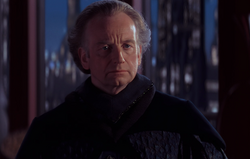
Palpatine watches as Queen Amidala leaves for Naboo.
Even before Palpatine's election, Amidala had declared her intention to reclaim Naboo from the Trade Federation by whatever means she could. When she informed Palpatine of her plans, he made a show of concern and tried halfheartedly to convince her to stay on Coruscant. She left anyway, taking both Jinn and Kenobi with her for protection. Thus she had taken all his enemies along with her into what could only be a considered a death trap. He and Darth Maul contacted the Neimoidians on Naboo, instructing them to kill Amidala, and notified them that Maul would be joining them to deal with the Jedi personally. Then he sent his apprentice off, with orders to make certain the Neimoidians killed the Queen, and that the Jedi fell by his own hand.
While Sidious managed the election on Coruscant, he made time to go over the progress reports from Naboo that Maul was frequently sending to him. As they came in, he became more and more baffled by Amidala's behavior: not only did she manage to escape Gunray's reach, but she had forged an alliance with the Gungans and assembled an army in the Lianorm Swamp, possibly in preparation for a strike against the Federation occupation force. If true, she was acting far more aggressively than her tactical position suggested; he doubted she would last even five minutes in such a contest. He gave his approval to Gunray's plan to meet the Gungans head-on.
In truth, the outcome of what would be called the Battle of the Great Grass Plains mattered little to Sidious. He had only sent Maul to Naboo, and ordered Gunray to destroy the Gungan army, to keep up the facade that he had an interest in Naboo so that the Neimoidians would not see his true motives. Regardless of who won the battle, he would benefit: if Amidala and her defenders fell, she would become a martyr he could use to justify further and more decisive action against the Trade Federation, and if they succeeded, he could use her victory as a symbol of the new take-charge attitude the Republic would be showing under his guidance. Either way, he would be seen as a decisive leader, and validate his election.
The murder of Darth Plagueis
- "It's ironic. He could save others from death...but not himself."
- ―Palpatine reflecting on his killing of Plagueis.
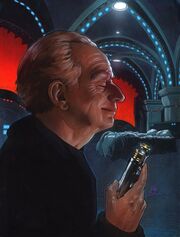
Darth Sidious, after slaying his master while he slept.
With Palpatine's election to the office of Supreme Chancellor now secured, there remained just one unfinished piece of business for Palpatine to resolve. For, once Palpatine had been elected Chancellor, Darth Plagueis had intended to act as a de-facto co-Chancellor, ensuring Palpatine only passed laws that he approved of. In truth, Palpatine had been subtly manipulating Plagueis for years, fooling him into thinking the ideas for the implementation of the Grand Plan were his own while Palpatine laid the groundwork for his ascension to Chancellor and Sith Master. Palpatine had never intended to share power with anyone, and he knew that installing a co-Chancellor would both raise suspicion and be politically damaging to him. With Plagueis's usefulness now exhausted, Sidious moved to eliminate him.[1]
The night before the election, Damask made his first public appearance in years, and a rare appearance with Senator Palpatine: they attended the premiere of an experimental Mon Calamari piece at the Galaxies Opera House together. After the performance, the two Sith Lords retired to Damask's penthouse in the Kaldani Spires building to celebrate Palpatine's upcoming success. There, Palpatine plied Plagueis with wine while rehearsing the acceptance speech he would soon deliver before the Senate. Plagueis soon fell into an alcohol-induded sleep, and Palpatine saw his chance. With his master's guard completely down, Palpatine blasted Plagueis's transpirator mask with Force lightning, shorting it out. This woke Plagueis but, being inebriated and half-asleep, the Muun could do nothing to stop his apprentice. Palpatine took the opportunity to mock Plagueis, informing him as to just how thoroughly he had manipulated him, all the while sending additional blasts of lightning, causing immense pain to his master as he slowly suffocated. In addition, Sidious lambasted Plagueis for his role in Palpatine's own conversion, hatefully accusing him of manipulating a "confused boy" into murdering his family. Despite this however, Palpatine then expressed to Plagueis his genuine and eternal gratitude for the teachings Plagueis had passed onto him. After his master finally succumbed to death, Sidious felt a monumental shift in the Force, which he interpreted as the dark side anointing him as the tool it would use to take over the universe. However, he then felt another shift in the Force, and feared for a few moments that this second shift was a forewarning that Plagueis had overcome his death in some fashion and was about to take his revenge. However, Palpatine quickly reasoned that this was not the case, though he would not discover the reason behind this second shift for some time.[1]
Although Palpatine, like Plagueis, was by no means an adherent of Banite ideology,[14] he would nonetheless incorporate elements of it into the doctrine he developed to replace it, the Rule of One. This new dogma recognized the need for apprentices only as useful tools, as Sidious planned to achieve immortality and have an eternal rule over the galaxy. In accordance with the Rule of One, he would keep a close eye on his own apprentices in the future, revealing only the barest minimum of information about Plagueis to them, in order to avoid having his master's end.[47] For much of his life, he would be on his guard, vowing to himself never to make the mistake of sleeping as Plagueis had, even in a rare moment of weakness.[24]
The aftermath of the Naboo Crisis
- "Congratulations on your election, Chancellor."
"Your boldness has saved our people, Your Majesty, It's you who should be congratulated. Together, we shall bring peace and prosperity to the Republic." - ―Palpatine and Queen Amidala talking about his election as Chancellor.

Palpatine in his Sith guise
Shortly after Plagueis's murder, Palpatine was informed that Amidala had triumphed over the Trade Federation's forces. Against all odds, she had retaken her throne, and had captured Gunray and Haako. Of all the outcomes the battle could have had, Palpatine had not expected this one to come to pass, but in the end it did not matter. The occupation had already served its purpose, and his state visit to Naboo after the battle tied himself firmly with that victory. However, this would seem to be a loss for his secret goals.[1]
Whether this truly was is unknown. Palpatine himself had presented two conflicting points of view on the matter. The first, written as an addendum to Maul's journal very soon thereafter, indicated that he was displeased with the outcome. "Defeated by a young boy, a naive girl and a Jedi Apprentice. It was not a good day." He also indicated that Anakin Skywalker had not come to his notice before then.[29] The second, recorded many years later in the Telos Holocron, was quite different.
Though he lost an apprentice, in the Telos Holocron he claimed that he had seen that Skywalker, whom had come to the attention of the Jedi Council just days prior, would ultimately become his apprentice and sacrificed Maul to this end. Maul was but a tool whose goal was to rattle the Jedi's long-complacent attitude regarding the Sith and to act as the catalyst for the relatively inexperienced Obi-Wan Kenobi to train Anakin.[20]
All of this, he would claim in the Telos Holocron, was carefully planned and executed by Palpatine, although he had considered using Maul to pick off individual Jedi and act as a major distraction to the Order.[22] He did express some regret at the loss of a valuable tool, but that was all; for all the childlike loyalty Maul had shown him, it was never returned.
However, these views can be reconciled somewhat by Palpatine's musings after the battle. While he privately considered the fight to have been "lost", he was not particularly concerned by Maul's fate. He had, in fact, been at something of a loss regarding what he was going to do with Maul after Plagueis was dead; the Zabrak had never been trained with the intent of making a true Sith Lord out of him, and Palpatine had realized that trying to ease him into a less covert role would have been very difficult. Though he had been somewhat surprised by Maul's defeat, he had long known his apprentice to be overconfident, and had little difficulty in imagining how Maul's pride could have lead to his downfall. Ultimately however, the outcome of the Naboo Crisis and the presumed death of Maul did nothing to hinder his long-term goals.[1]
Whichever account is true, in the end he had gained far more than he had lost. He had also learned the role that Anakin Skywalker had played in the liberation. Though barely large enough to reach the controls, he had piloted a fighter straight into the Federation control ship and destroyed it. After much debate, Jedi Council chose to train him as a Jedi, and decided that he would be apprenticed to Kenobi. Palpatine made a promise to Anakin during the celebration on Naboo, telling him his career would be watched with "great interest." He would keep this promise.
Palpatine also attended the funeral of Qui-Gon Jinn, who had been slain by Maul during the battle.[11] In addition, he came to the conclusion that the disturbing shift in the Force that he had felt after Plagueis's death had been Maul's defeat and presumed death.[1]
By that time, he already had half an eye on the charismatic Count Dooku,[20] as a potential candidate for apprenticeship, at least until Skywalker could be turned. The Jedi were now afraid, and that gladdened him. The greatest prize had been won; the Republic that the Jedi sought to defend was already in the Sith's hands.[1] In addition, he arranged to have a meeting with Anakin and Kenobi in his office on Coruscant under the pretense of meeting the boy who had aided so much in the liberation of his homeworld. He mused to himself that, as he believed that Anakin was too young to train as a Sith, he had no issue with the Jedi teaching him until he was ready for conversion. The meeting, though brief, was enlightening for Palpatine, who saw much of his younger self in Anakin. He resolved after the meeting to become a sympathetic father-figure for Anakin while the galaxy fell apart around him, and to ultimately groom the boy to be his final apprentice.[1]
An end to loose ends

Darth Sidious
As the galaxy moved on from the spectacle of the Naboo Crisis, Palpatine quickly moved to destroy any incriminating materials left over from the affair. The first order of business was retrieving Maul's gear and vessel. Republic investigators had seized both Maul's ship, Scimitar, and his droid C-3PX on Naboo. Both contained knowledge best not revealed. Fortunately for Palpatine, the Scimitar refused to yield its treasures; the first Republic Intelligence technicians that attempted to inspect the ship were gunned down by security probe droids. Their bungled inspection also caused the flight, weapons and communications systems to self-destruct, leaving little more than a burned-out carcass.[47] When they called in Jedi Master Saesee Tiin to secure the ship, Tiin also found the onboard computers completely erased. There would be no clues about the "second Sith" from that quarter. Sidious had sacrificed the ship and all its equipment—Maul's surveillance gear, his explosives, his poisons and torture devices, and his speeder, Bloodfin. But it was worth it, just for the fear that ate at Tiin as he left the Infiltrator:
- "That ship is alive with the dark side, Master Yoda. I can feel it clinging to my robes. And worse, it still tempts me, calling me back with promises of fantastic journeys to the far reaches of the galaxy."
- ―Saesee Tiin
Tiin recommended that the ship's carcass be placed in the care of the Jedi Council, but the Senate representative from Kuat lobbied successfully to give Kuat Drive Yards an opportunity to study it. Before it reached a KDY facility however, it disappeared, at least officially. Few were aware that it had actually been diverted back to Naboo and stored in a clandestine hangar in Theed,[47] an easy feat in a Republic so bloated that its left hand did not know what its right was doing—especially when Palpatine was guiding both hands. As for the droid, Palpatine saw to it that C-3PX's possibly incriminating memory was erased, then remanded it to the custody of Raith Sienar. Under Sienar and subsequent masters, the droid was re-tasked for other uses, and throughout the rest of its operational life, whether as a corporate espionage droid, a bounty hunter, even as an assassin, it had no inkling of its link to Sidious's former apprentice.[48]
The Republic under Palpatine (32–24 BBY)
- "The Chancellor loves power. If he has any other passion, I have not seen it."
- ―Mace Windu to Obi-Wan Kenobi
Despite the outpouring of sympathy that had led to his election, Palpatine faced violent reactions to his appointment as Supreme Chancellor almost immediately after taking office. Shortly after his election, a strike force of revolutionaries broke into the Grand Convocation Chamber, ready to murder the new Chancellor. However, the Senate Guard managed to thwart the attack before Palpatine came to harm.[49] During the eight years of his legitimate tenure, the new Chancellor kept himself busy. Much of this work was an intrigue that would eventually cause catastrophic bloodshed, the Clone Wars. Besides that, he had other, small scale projects that further undermined the Jedi and the Republic they served. Many—such as the Outbound Flight Project. These plots were designed to whittle away the Jedi ranks, a few at a time, to make his task easier when the time came to purge them entirely.
Palpatine and Mas Amedda
One of Palpatine's first decisions as Chancellor was to maintain Mas Amedda as his vice chair and Speaker of the Senate. Amedda had gone to great lengths to persuade Senator Taa's clique to nominate Palpatine in the first place,[32] and the Chagrian had performed exactly as expected. Amedda had been Valorum's friend, but he was loyal to his ideal of the Republic first, and to the Republic's laws and regulations. That strict adherence to the law had hamstrung Valorum as Palpatine had expected, and Palpatine saw that Amedda had the potential to remain useful in the long run. Amedda, like so many others, mistook Palpatine's mild temperament for malleability, and saw a unique opportunity to manipulate Palpatine into bringing the Republic back to what he had envisioned it had been, and Palpatine encouraged this naïveté: in his first years in office the new Chancellor made himself appear open to suggestion, enacting some legislation that Amedda brought to his desk.
But while he kept his mask on in Amedda's presence, Palpatine was also gathering information on the Chagrian to use as leverage. Shortly after the destruction of Outbound Flight in 27 BBY, a project for which Amedda had passionately lobbied, Palpatine revealed to Amedda that he had ordered the mission's destruction and, furthermore, that he was actually a Sith Lord, Darth Sidious, sworn enemy of the Republic and the Jedi Order. At this point it was far too late for Amedda to tell anyone; Palpatine had enough incriminating material on him to keep him muzzled for life. Palpatine explained that he had known all along that Amedda and others had tried to manipulate him, but in truth, he had manipulated them, pitting them against each other. With little choice, Amedda became a willing member of the conspiracy.[50] With the coming of the New Order, he would continue to serve Palpatine and keep his secrets, not paying too much heed to the thought that, eventually, his knowledge would make him more a liability than an asset.[27]
Palpatine and Janus Greejatus
Palpatine's ascension to the position of Chancellor left a small problem; someone had to assume the now-vacant position of representative for Chommell sector in the Senate. He used his influence to promote the election of Janus Greejatus from Chommell Minor, one of his political allies. Greejatus had long since demonstrated that he had a keen political mind, and though Palpatine could not be seen embracing them openly, Greejatus's anti-alien isolationism can be presumed to have served Palpatine's purposes. Still, the election did not long stand; his isolationism was at odds with Naboo's newfound multicultural stance, and prominent political voices on Naboo cleared their proverbial throats almost immediately. Eventually, Greejatus was replaced about 30 BBY by Horace Vancil of Naboo, but Palpatine continued to keep him close, making Greejatus one of his advisors.[38]
The offices of the new chancellor
Chancellor Palpatine and his art of choice, used as hiding places for his dark artifacts.
Palpatine maintained his private senatorial apartment at 500 Republica as his main residence, but according to custom he also moved into the Chancellor's Suite in the Republic Executive Building. Exercising the traditional prerogative to decorate the office as he saw fit, he purged all traces of Finis Valorum from it and made it practically a mirror image of his apartment. Within weeks, no one who had spent any time in the Suite during the Valorum government would have recognized it. Yet again he hid his Sith nature in plain sight; the color red now dominated the decor, and priceless objets d'art—many of them Sith heirlooms too obscure to be recognized as such—were moved in.[31]
Two of these additions to the decor were of particular importance. The first was a new Chair of Office, black, throne-like, armored with ultra-dense lanthanide alloy. This chair, with certain modifications, would be his seat of power for more than four decades, and copies of it would be installed in every ship, outpost, and facility Palpatine was likely to visit. The second, and even more important piece, was a neuranium sculpture of Sistros, concealing one of his Sith lightsabers, sealed within the sculpture at the time of its forging. This he placed in the anteroom. Other reserve blades, and his black cloak and hood, he concealed in other art objects or in shielded compartments throughout the Suite, until the time when he would at last put them to use.
The coming of the Red Guard
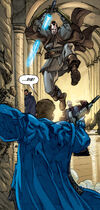
Ronhar Kim foils a false assassination attempt on Chancellor Palpatine.
It was around this time the controversial and crimson-robed Chancellor's Guard, or simply Red Guard, first appeared. The impetus for the Guard originated with a Captain Prid Shan of the Senate Guard. As potential threats to the Chancellor's person increased, Shan began demanding that the Senate provide additional funding to upgrade the equipment and training of the Guards, and assign a Guard detachment strictly to the protection of the Chancellor.[51] Publicly, Palpatine feigned embarrassment at the notion of trained soldiers specifically protecting his person. In truth, however, he wanted just such a bodyguard unit, but could not afford to be seen as directly advocating one. A personal guard for a chief of state was seen as a violation of the Republic's principles, and some in the Senate objected. The solution was to create a situation where one could be forced on him, so he devised a means to validate Shan's claims.
Palpatine decided to use his "friend," the Jedi Ronhar Kim—son of his late predecessor as Naboo's representative, as the catalyst for his plan. He arranged for Kim to be present during a terrified warning from Senator Viento that Palpatine's proposed reforms had angered some enough to want him dead. At that moment, the Senate Guards flanking him raised their rifles. As Palpatine expected, Kim quickly neutralized them, but they killed themselves with a fast-acting poison before they could be properly questioned. The Senate Guard was seen to have failed at a crucial moment, and Captain Shan's words, backed by the voices of Viento and other Senators, now had enough weight to carry the argument forward.
The Red Guards—later to be known as the feared Emperor's Royal Guards—were quickly formed and placed under Palpatine's personal authority. Throughout the years both leading up to and during the New Order, he was rarely seen outside their company. As he would do many times, he saw to it that their design inspired fear in any who saw them. Their distinctive crimson robes and armor were based not only on those of the Senate Guard, but on two other, far more ferocious units: the Death Watch of the Mandalore system and the Thyrsus Sun Guards he had long ago consolidated under his own authority. In fact, by the time Palpatine was inaugurated as Emperor, more than a few of the fanatical Sun Guards—those that he had not by then eliminated—had found their way into the ranks of the Red Guards.[41] As expected, there was some criticism, but the gradual passage of new security laws and the rise of the Separatist threat kept that criticism to a minimum.
The reelection of Chancellor Palpatine
As Palpatine finished his elected term in office in 28 BBY, the election for the Chancellorship was held as scheduled. Despite the fact that Palpatine's best efforts at reform had been stymied, a result that he himself had made certain of, his own scheming together with the lack of any genuinely viable opposing candidates ensured his reelection. It would be the last election for Chancellor to be held in the remaining history of the Republic; shortly before the next scheduled election in 24 BBY, his maneuvers would result in an amendment to the Constitution allowing him to serve indefinitely. And once that election had passed unobserved, there would never be another in Palpatine's lifetime.
The Outbound Flight Project
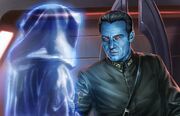
Palpatine meets Thrawn for the first time during the Outbound Flight incident.
Among the more well-known of Palpatine's lesser intrigues was the funding, and then destruction of, the Outbound Flight Project, the brainchild of Master Jorus C'baoth. Palpatine had worked with C'baoth before, and for years the two of them had discussed the possibility of life outside the galaxy. That possibility never left C'baoth's imagination and, eventually, in 27 BBY it blossomed into a workable proposal. Given the title of the Outbound Flight Project, C'baoth presented it to Palpatine for approval. Six Dreadnaught-class heavy cruisers would be linked to a central storage core, becoming a single vessel, and then launched on a course through the fringes of the Republic, then the Unknown Regions, then off into the void, eventually to reach a nearby galaxy, and back again.
Extra-galactic travel had long been dismissed as impossible because of intersecting ripples formed in hyperspace by galactic masses. Palpatine may have suspected otherwise, if the reports from Zonama Sekot of possible extragalactic invaders were true. In any case, C'baoth believed the Jedi could use the Force to calm this turbulence, and tests in the briar patch border of the Unknown Regions seemed to bear him out, so C'baoth recommended that he and as many other Jedi as possible join the expedition. Though other reasons surely factored into his supporting the project—the possibility of learning more about the so-called "Far Outsiders," for instance—its greatest value for Palpatine was to provide a single target, far from prying eyes, where a number of prominent Jedi could be disposed of easily, without being traced to him. So, while outwardly appearing cool toward the concept, he allowed C'baoth to move forward and worked behind the scenes to see the project through to completion.
But the Senate still hesitated to fund such an expensive expedition, so Sidious sent his spy, Kinman Doriana, to make sure C'baoth would gain enough credibility to sway the Senate to his cause. C'baoth had been dispatched to negotiate an agreement between the Corporate Alliance and a regional government on Barlok over mining rights. Doriana beat C'baoth there, inflaming militant Brolfi miners into making an assassination attempt, one that was meant to fail. As expected, C'baoth himself foiled the assassination and hammered out a deal both sides had little choice but to accept. With such a triumph under his belt, it was simple for C'baoth to convince the Senate to pass Measure 4213.0410, which provided full funding for Outbound Flight. Even the Jedi Council caved in to pressure and agreed—grudgingly—to assign six Jedi Masters, including C'baoth, and eleven Knights agreed to go as well. This was more than even Sidious could have hoped for, and, eventually, would be a loss the Jedi Order would be hard-pressed to recover from.[22]
The destruction of Outbound Flight
Outbound Flight was launched in 27 BBY; now its Jedi passengers had to die. To that end, Sidious sent Doriana to oversee handpicked units from the private armies of his commercial allies. Against that, even six new Dreadnaughts should have been overwhelmed without fuss. But Sidious had not anticipated that his task force would be discovered by a young Chiss officer named Mitth'raw'nuruodo—though better often known by his core name, Thrawn. Doriana sought peaceful contact—there was always the possibility that the Chiss could become allies—but the Neimoidian commander, Siv Kav, foolishly launched an attack without any discussion. Within minutes, all but one of Doriana's ships was destroyed, and that only because Thrawn wanted someone left alive to interrogate.
Doriana feared the punishment he would receive when Sidious learned of this debacle. But he found a way to turn a short-term defeat into a long-term victory. Skillfully using the scant intelligence from Tarkin and Sienar's expedition to Zonama Sekot, he evoked the threat of an invasion by the Far Outsiders, already establishing footholds at the edge of the galaxy, already sending scouting parties to plan the route of conquest. If Outbound Flight met their bridgehead, Doriana insisted, the galaxy would face a massive onslaught long before it was ready. Thrawn—who, as it turned out, already knew of incursions on the far edge of Chiss space—was convinced, especially after Doriana opened a holochannel to Sidious so Thrawn could discuss the matter with him personally.
Sidious, too, was occupied. He had learned that C'baoth had added Anakin Skywalker to the crew roster without anyone's knowledge; nothing could be allowed to happen to his prized apprentice-to-be. Palpatine traveled all the way out to Roxuli, the last stop of Outbound Flight before it left Republic space. Officially, he was there to secure C'baoth's services as a negotiator between the Roxuli government and its asteroid mining colonies, but he was really there to save Skywalker from the coming trap. That meant he would have to save Kenobi as well, since he could not yet separate Master and Padawan, so he secured Kenobi's services as a replacement negotiator, and Kenobi brought Skywalker with him. In their absence, Outbound Flight continued toward the Unknown Regions, and its fate.
Soon after, Doriana reported that Thrawn had destroyed Outbound Flight, partly by maneuvering a second power of the region, the nomadic Vagaari, into the engagement, to the destruction of both parties. And though Thrawn knew of Sidious's existence and Doriana's true identity and position, Doriana chose not to kill him, correctly guessing that the Chiss strategist could be of continued use to the Sith cause. Thus Palpatine gained a new tool as he lost an old one: the unstable C'baoth was dead, but he still had a way to make use of him in the future, if needed. C'baoth's blood had been drawn before the start of the doomed mission. If ever Palpatine had another special need for C'baoth, the cloning tanks would be waiting.[22]
The search for a new apprentice
After the untimely defeat of Darth Maul, Sidious was faced with an urgent task. Before he could continue in his plans to divide and conquer the Republic, he needed an apprentice who could be counted on to make the necessary preparations, to sow dissension among the Republic's member worlds. The ideal method would have been to locate another Force-sensitive youth to mold according to his desires, but that was impossible now. As a Senator from a less-than-prominent world, he could afford the time to train Darth Maul from infancy, but now the daily schedule of a sitting Chancellor precluded any attempt to do the same for Maul's successor. He could not risk his political career for his Sith duties, nor could he neglect his Sith duties for his political career.
At some point in this time, Palpatine trained the Fosh Jedi Vergere as a potential apprentice. However, after discovering the extent of Palpatine's plots and megalomania, she attempted to kill him. She failed and was forced to flee, managing to escape the galaxy. As such, Palpatine turned his full attention to his old friend, the former Jedi Master Dooku.
The seduction of Count Dooku
The Dark Lord contacts his new apprentice.
Shortly after the death of Qui-Gon Jinn, Dooku had resolved to leave the Jedi Order, as he viewed the Jedi Council as complacent, shortsighted, and ineffectual with regard to addressing the roots of the social decay afflicting the Republic. Though he had briefly entertained the idea of exacting revenge against the "second Sith" for the death of Jinn, Dooku's thoughts had quickly turned from that objective. By the time of his resignation, he had instead begun considering allying himself with the Sith, believing that the Jedi's passive and archaic philosophy prevented them from affecting the change necessary to save the Republic. He had even begun to seriously consider the idea that the dark side was a more useful tool than the light side, and that it's power should be embraced rather than feared. Dooku had revealed all this to Palpatine shortly after the latter's elevation to Supreme Chancellor, but Palpatine, not entirely certain of the powerful ex-Jedi's intentions, had not revealed himself as a Sith Lord on that occasion. However, Palpatine vowed to himself that he would keep a very close eye on Dooku in the future.[1]
Shortly thereafter, Dooku had set about regaining his family title of Count of Serenno, along with the power and virtually limitless wealth the position entailed. It is not known precisely when Palatine revealed himself to Dooku, but, already seeking an alliance with the Sith and already a friend of Palpatine's, Dooku's conversion to the dark side likely took little convincing. Palpatine knew that Dooku's oratory skills, political acumen, charisma, and intelligence would serve the Sith cause well, not to mention his extraordinary wealth and resources. Additionally, Dooku was one of the most talented and powerful Force adepts in the galaxy, and, of his Jedi peers, only Grandmaster Yoda was considered his superior as a swordsman. Together, the two of them began to set the stage for the Clone Wars, the masterstroke of the Sith Grand Plan.[1]
Dooku chose to believe what he had with Sidious was a partnership. It is clear, however, that from the very beginning of their relationship, Sidious was leading him on. Dooku was a necessary tool, as Maul had been. Sidious neither needed nor wanted a "partner," someone on an equal footing with himself. It was not the Sith way, and it was certainly not his way. Dooku would be a useful placeholder, until Skywalker was ready for conversion.[47]
The clone army
Many years before Palpatine ascended to the Chancellorship, he and Darth Plagueis had conceived of starting a civil war to bring down the Jedi and the Republic. Initially, Plagueis's plan was to use a cloned army of Yinchorri to fight against the Jedi in this manufactured war, as the Yinchorri had a natural resistance to Force-based telepathy and their natural behavior tended towards extreme savagery. However, the Kaminoans who were to create the army informed Plagueis that a Yinchorri subject would not make for a suitable template; their brains were not evolutionarily sophisticated enough to accommodate the behavioral modifications that Plagueis desired for his soldiers. Taking one of Palpatine's suggestions in mind, Plagueis scrapped the idea to use a Yinchorri template and instead implemented a plan to clone a human army to fight alongside the Jedi, rather than against them. However, Plagueis knew that he could not be the one to commission such an army. If the Jedi or the Republic were to discover that a corporate power-broker like his alter ego, Hego Damask, had commissioned an army, it could lead to questions that might expose the Sith. He would have to find a proxy to act through, preferably a Jedi in order to give the project an additional smokescreen. That proxy would ultimately present itself in the form of Jedi Master Sifo-Dyas.
Sifo-Dyas and Plagueis had met seemingly by chance at a negotiation on Serreno. Plagueis had learned that Jedi Master Dooku would be acting as arbiter between the two opposing parties, and had gone to Serreno to evaluate Dooku's potential usefulness to the Sith. While analyzing Dooku, he took note of the fact that Sifo-Dyas, who had accompanied Dooku, was extremely concerned about the political climate of the galaxy at large. Citing the dangerous levels of civil unrest of the Outer Rim systems, Plagueis initiated a conversation with Sifo-Dyas about the fact that the Republic was completely unprepared to go to war if it became necessary. He saw that Sifo-Dyas was just as aware of the Senate's corruption as Dooku, but was far more afraid for the Republic's future than Dooku was. Plagueis realized that he could use Sifo-Dyas's fear to manipulate the Jedi Master into helping create the army the Sith required. However, before he could snare Sifo-Dyas, he was interrupted by the arrival of Jedi Master Jocasta Nu, and let the matter drop.[1]
Years later, in 32 BBY, a gathering was hosted by Supreme Chancellor Finis Valorum on Coruscant in which Sifo-Dyas happened to be in attendance alongside fellow Jedi Yoda, Mace Windu, Adi Gallia, and Jorus C'baoth. With the galaxy seemingly on the brink of civil war, Sifo-Dyas's concerns had become all the more urgent, and the Jedi Council was apparently no more willing to take action than it had been when last he met Plagueis. Once again, Plagueis approached Sifo-Dyas, and began a discussion with him concerning the fact that many of the disenfranchised Outer Rim systems were a hair's breadth away from declaring independence. To make matters worse, Plagueis "revealed" that many of his wealthy clients were pushing to further militarize their corporate enterprises in order to capitalize on the situation. Plagueis argued that, in light of this increasing instability and corruption, a military capable of defending the Republic needed to be created now, while there was still a chance. Sifo-Dyas agreed with Plagueis's analysis, but believed that there existed no practically available course of action by which to either create or secure a military. However, Plagueis informed him that there existed a group of cloners on Kamino who would be able to grow an army and hold it in reserve until it was needed. He proposed that, if Sifo-Dyas was willing to place the order for the army in his name, Plagueis, as Hego Damask, would provide the funds necessary for the creation and training of said army. He also made it clear to Sifo-Dyas that, due to the continued existence of the Russan Reformations, neither the Senate nor the Jedi Council could be informed of the order lest the project be terminated. The Jedi Master was at first skeptical, but promised to give the proposal serious consideration.[1]
At some point shortly after Dooku's resignation from the Jedi Order, Sifo-Dyas approached the Kaminoans and requested that they create a clone army for the Republic. With the funds provided by Damask Holdings despite the fact that Plagueis had recently died, Sifo-Dyas paid the Kaminoans. However, to make absolutely sure that the existence of the clone army never came to the attention of the Jedi or the Republic, Sifo-Dyas had to die; a task that would fall to Dooku. Dooku carried out the murder, killing his old friend and cementing his allegiance to the dark side. By killing Sifo-Dyas, he had also fulfilled the ancient covenant that prescribed the murder of one who was close as a measure of commitment to the Sith cause. In the wake of Sifo-Dyas's death, Dooku gained full control of the cloning project for the Sith, using Sifo-Dyas's name as a cover.[20]
Seeing that Dooku had embraced the dark side, Sidious awarded him the Sith name and title of Darth Tyranus.[47] But the cloning project still stood, so Tyranus carried on where Sifo-Dyas left off. Until he had been silenced, Sifo-Dyas had kept the project a secret. To ensure that it stayed one, Dooku erased all records of the planet Kamino from the Jedi Archives, along with thirty-seven additional systems, including Dagobah and Dromund, that Sidious had judged to be of potential value to the Sith. Interestingly, he accomplished this task after his official resignation from the Jedi Order.[52]
Tyranus's second task was to find a source of DNA for this clone army. To ensure that the clones could challenge the Sith's enemies when the time was right, their template had to have exceptional combat instincts, supplemented by superb training and experience. Sidious ordered his new apprentice to find someone who fit this criteria. After much consideration and a brutal trial, Tyranus determined that Jango Fett, the last survivor of the old Mandalorian shock troopers, would be the perfect candidate. Tyranus offered Fett a generous payment for serving as the Kaminoans' prime clone. Fett accepted, on the condition that, in addition to the credits, he received an unaltered clone of himself, whom he would make his own son and apprentice. Tyranus agreed, and the foundation was laid for Palpatine's legions of stormtroopers, the force that would help Palpatine build an Empire out of a tattered Republic.
The Separatist Crisis (24–22 BBY)
- "I will not let this Republic that has stood for a thousand years be split in two. My negotiations will not fail."
"If they do, you must realize there aren't enough Jedi to protect the Republic. We are keepers of the peace, not soldiers." - ―Palpatine and Mace Windu

Palpatine's reassuring smile gave hope to the citizens of the Republic during the Clone Wars.
Palpatine had now completed his two four-year terms as Chancellor, and his clone army was nearly at the ready. The time was ripe for the commencement of the penultimate stroke of the Grand Plan. Throughout Palpatine's career as a Sith Lord, he, Plagueis, and Dooku had thrown the galaxy into chaos. Through careful manipulation of the Senate, various intragalactic criminal organizations, and the Republic's commercial and financial institutions, many systems of the Outer and Mid Rims were festering with hatred and resentment of the decadent Core Worlds and the corrupt Senate. Disenfranchised, poor, exploited and lawless, many of these worlds began to sound the rallying cry that they should break from the Republic. With a civil war virtually inevitable, Palpatine rushed to make sure he was in complete control of the impending conflict. Ultimately, he intended to use it to cement his hold on power and eliminate the Jedi Order.
The rise of the Separatist movement
- "Master Yoda, do you think it will really come to war?"
"The dark side clouds everything. Impossible to see, the future is." - ―Palpatine and Yoda
Under Palpatine's direction, Count Dooku united several commercial organizations—foremost among them the Trade Federation that had been Sidious's tool for seizing the Chancellorship—into the Confederacy of Independent Systems, forging the Separatist movement in 24 BBY. These organizations pledged the massive armies they had used to protect their profits to Dooku, thus making the Confederacy capable of overthrowing the Republic, and a threat in the eyes of the Senate.
Palpatine arranged for Dooku to construct the revolutionary government at the end of his term limit as Chancellor. Due to this, the oblivious Senate granted him an indefinite extra term in office—canceling the 24 BBY Galactic Republic Chancery election—to settle the Separatist Crisis. But the movement continued to strengthen, despite Palpatine's "attempts" at peaceful negotiations, including the formation of the Loyalist Committee, an organization of Senators that wanted to keep the Republic together and preserve its principles.
The false "peace initiative"
- "There are many on both sides of this grand debate eager to turn this dispute into war. It needn't degenerate into so wasteful an outcome. Together, we have the intelligence and the reason to find an alternative solution."
- ―Palpatine on the HoloNet, addressing the Separatists
Chancellor Palpatine appears on the HoloNet to offer an open invitation to Count Dooku to parley.
As the crisis expanded, Palpatine staged yet another "public relations" drama in which he could perform his favored role of the hurt innocent, offering from a position of strength the hand of peace. In 13:3:21, trillions upon trillions of HoloNet viewers across the galaxy found their regular programming interrupted by a signal that overrode all government channels and 90% of the private feeds. In a brief twelve-minute address, Palpatine offered an open invitation to Dooku to parley:
As he spoke, he did everything he could to keep up the appearance of the wronged party, assuming the moral high ground by forgiving his enemy. Even at this late hour, he said, he was willing to discuss a diplomatic solution. Little plays like this would be useful later; when the time for war came, he could say that he had done his best to prevent it, putting his own credibility as Chancellor at risk for it.
At the end of the address, he proposed Bothawui, a neutral world, as a potential site for a conference. For "security reasons," he named no date, but announced that all avenues of communication to his office were open to Dooku. It did not matter; Sidious and Tyranus had planned in advance that there should be no response, and that, as a result, the Separatists would be seen as implacable, unreasonable. And the next time any violence was blamed on the Separatists, the militarists in the Senate could rightly claim that negotiation with such radicals was impossible, and the call for an army would become louder still.[53]
Putting the Senate on the defensive
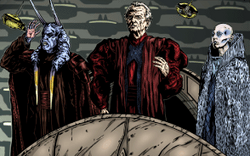
The Chancellor announces the date of 13:5:16 for the full Senate vote on the Military Creation Act.
The false proposal had its desired effect; the demand for a military to defend the Republic intensified. But it was still not enough to tip the majority of Senators in favor of the Military Creation Act. When it came to a vote, they needed to approve both the Act and the surrendering of their own lawmaking powers to Palpatine, and do so willingly. There was only one thing for it: a round of assassinations that could be blamed on the Separatists, and cause the rest to circle their wagons.
Soon, various Senators, including Aks Moe of Malastare, were murdered (22 BBY). No terrorist organization claimed responsibility in any of these incidents, but with the Separatist threat on the rise, fingers were naturally pointed in their direction first, just as Palpatine had anticipated. And, also as foreseen, the inability of the Jedi to keep up with the wave of violence added to the overall effect. Ainlee Teem rose up in the Senate to criticize the Jedi. The conclusion was obvious: if the Jedi and the Judicials themselves were not enough to maintain order, an army was needed to fill the breach. Publicly undecided on the issue, Palpatine privately observed the debate with pleasure.
The night before the scheduled vote on the Military Creation Act, Palpatine made an address to the member worlds of the Republic. Again, he spun a complete fiction, expressing confidence in a peaceful solution and commitment to negotiations, though even the non-attentive press noticed that he was already "grudgingly" anticipating a Senate yes-vote. The intent was to settle their fears. Whatever would happen, he maintained, the Republic would still be the Republic; that was not going to change. The tragedy was that their fears were well-founded, and that it would be this same man who would make them come true.
Assassination attempts on Amidala
While the Senate debated as to whether or not to create a Republic military, Palpatine's successor as Senator of Naboo and the world's former Queen, Padmé Amidala, arrived on Coruscant to cast her vote on the matter. As she landed, her vessel was destroyed by the Clawdite bounty hunter Zam Wesell, but she narrowly escaped death through use of a body double. In light of the assassination attempt, Palpatine had the vote delayed and had Amidala put under the protection of Obi-Wan Kenobi and Anakin Skywalker, her old Jedi allies from the Battle of Naboo a decade ago. After a second assassination attempt was made by using poisonous kouhun worms, Anakin was assigned by the Jedi Council to protect Amidala back on her homeworld of Naboo. The two both secretly started to fall in love with the romantic ambiance of Varykino. Anakin was clearly breaking the Jedi Code, and this guilt and secrecy would only bring him closer to the dark side.[13]
Meanwhile, Kenobi—who had been sent by the Council to solve the mystery of the assassination attempts on Amidala—found out about Kamino from an old friend in CoCo Town, Dexter Jettster, located the bounty hunter Jango Fett, who was the army's prime clone, and infiltrated the Separatist stronghold at Geonosis to discover that the financial leaders supporting the Confederacy had an army of battle droids in wait and that to insure the Federation's backing was to have Senator Amidala killed. Kenobi contacted the Chancellor and the Jedi Council back on Coruscant, but was taken captive by the local Geonosians.[13]
As for Anakin and Padmé, the duo had secretly voyaged back to the desert planet Tatooine after Anakin had visions of his mother, Shmi, in agony. Anakin met the Lars family, who had freed Shmi from Watto years ago and learned that his mother had married Cliegg Lars. His mother's husband told him that she had been taken captive by a Tusken tribe. Anakin tracked her down to the Tusken camp, where he witnessed her death in captivity. The young Jedi slaughtered the entire tribe, creating a terrible disturbance in the Force that was felt by Yoda and Palpatine on Coruscant. The Chancellor was gladdened when sensing Anakin had committed another dark act, and Yoda even heard the spirit of the late Qui-Gon Jinn cry to him from the netherworld. Anakin returned to the Lars homestead to bury Shmi and, after taking his old protocol droid C-3PO back, he journeyed with Padmé to rescue Obi-Wan.[13]
Emergency powers
- "It is with...great reluctance...that I have agreed to this calling. I love democracy. I love the Republic. The power you give me I will lay down when this crisis has abated. And as my first act with this new authority, I will create a Grand Army of the Republic to counter the increasing threats of the Separatists."
- ―Palpatine, accepting his emergency powers
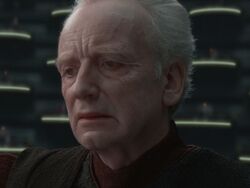
Chancellor Palpatine "reluctantly" agrees to accept emergency powers.
Though Kenobi had been captured on Geonosis, he had been able—or was permitted—to send out one transmission to the Jedi Council reporting his findings. Though he was cut off by droidekas arriving to take him into Geonosian custody, Kenobi's report on the status of the Separatist's military buildup came through loud and clear.
Palpatine now had in his hands the "proof" he needed to force the Senate's hand: the testimony of a respected Jedi regarding a massive military buildup by what technically amounted to a terrorist organization. He no longer needed to convince anyone of the Separatists' intentions; here was proof that, regardless of the Senate's hand-wringing about whether to risk a war with the Separatists, Dooku was already preparing to launch a war against them.
During a tense night-time conference in the Senate Office Building, Palpatine and Mas Amedda met with members of the Jedi Council and the Loyalist Committee to discuss how best to counter the threat of an imminent Separatist attack. It became clear that even with an immediate threat hanging over their heads, the Senate would still not be able to approve the use of the clone army before the Separatists launched their offensive. Following an interminable session of debate, Amedda (no doubt prompted by Palpatine before the meeting) suggested that if the Senate were to grant Palpatine emergency war powers, he could then approve the use of the army immediately. Jar Jar Binks, representing Naboo in Amidala's absence, volunteered to make the motion in the Senate.[13]
When Binks made the motion in his broken Gunganese variant of Basic, the Senate was shocked. They simply could not believe that Binks, the being they had all derided as a clown, was now possessed of a strength and eloquence they had never seen in him before, and as radical as his proposal was, it seemed the most sensible option, given the circumstances. Binks was advocating a complete about-face on militarization, and this reconciled a great many doubters. As Amidala's chosen proxy, Binks's position was seen as her position. If Binks said it, then by senatorial rules, she had intended for it to be said.
The cheering and the chants of his name from the body of the hall went on, uninterrupted, for minutes, drowning out the few jeers of protest. By the time Palpatine held up his hands, calling for silence, he had, with the help of the unwitting Gungan, won the Senate almost completely. The rest of it—the humble speech with which he would soothe their belated fears about the future of the democratic system, and the actual vote on Binks's motion—was merely a formality.[13]
At the conclusion of his "acceptance speech," Palpatine asked only that once the crisis was over, he could retire to Naboo and live out his remaining years in peace—another heinous lie. Only one thing he said could be taken at face value: the clones were a fact, and he quickly legalized them as the Republic's armed forces. He had dealt the Republic a fait accompli, and they had not even imagined that he was involved.
Clone Wars (22–19 BBY)
Darth Sidious and Darth Tyranus meet on Coruscant just after the outbreak of the Clone Wars.
In the aftermath of the Republic victory against the Separatists on Geonosis, Darth Tyranus escaped from the planet and eluded the Republic forces until reaching the last place anyone would think to look for him—Coruscant, the very heart of the Republic itself. Upon reaching the secret lair of Darth Sidious, Tyranus assured his Sith master that their long-awaited plot was finally in motion with the beginning of the war. Sidious expressed satisfaction and congratulated his apprentice, noting that all was proceeding according to his plan for the future. To that end, Tyranus also left the secret schematics for the ultimate weapon in the hands of his master to better ensure that they would not be discovered by the Jedi Order.[13]
The great project that took more than ten years in the making—the first full-scale conflict in a thousand years, and one of the most destructive in history—began on the right foot for Darth Sidious, the mastermind behind all of it. In his guise as Chancellor Palpatine, Sidious had at his command a force of well-trained, well-equipped soldiers answerable ultimately to him, and sweeping discretionary powers to use as he saw fit, which undermined the Constitution to an unprecedented degree. With an army of unquestioningly loyal soldiers in one hand, and extraordinary political powers in the other, Sidious put both of his greatest assets to work in the long and bloody conflict that history remembered as the Clone Wars. On the surface, it was seen as the Republic's effort to suppress the militant Separatist movement. In actuality, it was a war waged against the Republic itself by its own head of state.[13]
Chancellor Palpatine watches with several senators as his new army marches before him.
The Separatist threat to the Galactic Republic, a danger that no one had ever truly had to fear for over a thousand years, caused the vast majority of the Republic citizenry to rally around their leader, Chancellor Palpatine, in support of protecting and preserving the Republic as the single and most dominant force in the galaxy. The Chancellor's public support increased to high levels as the war escalated with the Separatists. SAGroup, a Republic youth organization and a sub-branch of the Commission for the Protection of the Republic, was composed of adolescent loyalists who strongly supported and admired Palpatine, which they often displayed by holding public rallies to express pride in the Republic.[54]
From diplomat to despot
- "There are times when we must all endure adjustment to the Constitution in the name of security."
- ―Palpatine
Throughout the Clone Wars, Palpatine continued to consolidate his power, stripping the Senate of an ever-increasing amount of it's authority. More and more amendments were made to the Constitution in the name of security, all of them transferring more and more power to Palpatine, including Statute 312b, which gave more weight to votes cast by Senators from Core and Inner Rim worlds, those whose support of Palpatine was more dependable, than those from Rim worlds.
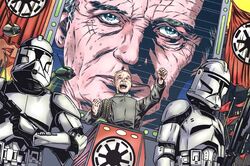
Public support for Chancellor Palpatine stands at an all time high because of his leadership during the Clone Wars.
At the onset of the Clone Wars, Chancellor Palpatine gradually secured his dictatorial hold over the Republic while simultaneously maintaining his façade as a defender of democracy and an ally of the Jedi Order. At the same time, he continued to control the Confederacy from behind the scenes as Darth Sidious, mainly through his apprentice, Darth Tyranus, who also hid behind his own public disguise as Count Dooku.
Together, the two Sith Lords plotted an assault on Kamino. Although the Separatists hoped to gain an early advantage in the war by destroying the Republic's main supply of clone soldiers, the true purpose of the battle was to hinder the advantages of both the Republic and the Confederacy. While relatively intact, the cloning facilities suffered damage during the battle. As for the Confederacy, their advance strike team was lost along with many of their top commanders. Ultimately, both sides were weakened by the losses sustained in the Battle of Kamino, thus ensuring the galaxy would be locked in conflict for years. As a countermeasure to the Republic's Jedi Order, Dooku also started training a cadre of Dark Acolytes to help with the war effort and the Sith reemergence.
Palpatine used his considerable skills at manipulation and subterfuge to play the Jedi and the Confederacy against one another. On one notable occasion, he issued secret orders to both Ki-Adi-Mundi and Aayla Secura, and as Sidious, to Dooku, for each to complete a mission on the planet Hitaka. Each mission's success depended on that of the other, with the end result being that Secura and Ki-Adi-Mundi were kept distracted by their mission long enough for Dooku to complete his own assignment.[55]
The "Reflex Amendment"
One notable wartime constitutional amendment that gave particular teeth to Palpatine's emergency powers was Emergency Amendment 121b, dubbed the "Reflex Amendment" by both supporters and critics because it was claimed by those in favor that the amendment would decrease the Republic's response time when dealing with Separatist attacks. The public justification was that 121b was necessary to compensate for the problem of overlapping jurisdictions in engagements where the battle spread across more than one system and thereby involved more than one local defense force. As usual, his supporter, Ask Aak, did the oratorical legwork by thundering in the Senate about the amendment's virtues:
- "The Separatists have taken advantage of our lethargic reaction time long enough. We will no longer be yoked by bureaucracies that have been fattened by the larder of the Trade Federation and other traitors."
- ―Ask Aak
In truth, 121b was simply a ploy to begin the process of giving Palpatine and his handpicked officials control over sector- and system-based defense forces. With its passage, officials appointed by Palpatine's military council were moved in to replace the commanding officers of several key loyalist forces. The opposition had hoped in vain for a solution that would have allowed for equal cooperation between local forces and the Army of the Republic; what they failed to realize was that cooperation had nothing to do with it. Amendment 121b was a crucial step toward the eventual absorption of all local defense forces into the GAR (20 BBY), without which the awesome Imperial armed forces could not have been possible.[56]
The disappearance of Seti Ashgad
- "Senator Seti Ashgad has disappeared, days after he protested the installation of the Senate's new cam droids. Palpatine's office says the timing is merely a coincidence."
- ―Republic HoloNet News
As Palpatine called for even more extensive security measures, more and more Senators began to balk. One of these was Seti Ashgad, a former hyperdrive engineer who had designed the first Z-95 Headhunter starfighter and then used his fame to get elected to the Senate. Ashgad, often called the "Golden Tempter," was charismatic, charming, easygoing, and skilled in marshaling support. Had Palpatine not made his own move to oust Valorum and become Chancellor, Ashgad might have done so himself.[57] For this reason alone, Palpatine had him closely watched; the playboy courtier Sarcev Quest, actually Palpatine's spy and close confidant, kept a close eye on Ashgad.[58] And when Ashgad argued (21 BBY) against the installation of new surveillance cam droids in the Senate building, Palpatine acted. Ashgad was abducted by Sidious's agents and secretly exiled to Nam Chorios, the site of a former penal colony.
Thus the public was told of the Golden Tempter's unexpected departure. By all rights, a dispute over holocams was hardly cause to make him disappear. After all, others like Bail Organa had opposed the measure also. But Ashgad was a cut above. More than Organa, Fang Zar, or Mon Mothma, Ashgad's case demanded a stronger answer than the strictly political measures Palpatine was employing against the others. The Golden Tempter could easily persuade others to support him. Perhaps, given time and room to maneuver, Ashgad might have even gained enough support to propose a Vote of No Confidence against Palpatine. Evidently, Sidious, with his uncanny gift to see potential futures, decided to pinch off this particular future at the very beginning. Thus, Ashgad was left to rot on a desolate planet, under a sky in perpetual twilight.[57]
The assassination attempt on Bail Organa
Palpatine had plans for Bail Organa as well. Organa was less dangerous—for the present—than Ashgad had been, but he too was a prominent Senator who had been stymying Palpatine's attempts to consolidate his power. As with Ashgad, Palpatine judged that it was better to weed out such potential threats early rather than late. The opposition had recently managed to table discussion (21 BBY) on the Enhanced Security and Enforcement Act, a bill which, if passed, would centralize even greater power in his hands. An "incident" that claimed the life of a public figure such as Organa might serve to rouse the Senate and get the bill passed (not to mention removing another obstacle from Palpatine's path).
Organa and his entourage were traveling back to the capital following an emergency personal visit to his homeworld of Alderaan. Sidious made arrangements for pirates to attack Organa's cruiser while en route. The marauders actually succeeded in boarding the vessel and were but a corridor away from reaching Organa himself, but the unexpected intervention of a pair of Jedi fighter squadrons forced the pirates to withdraw. Many of them were conveniently destroyed before they could escape, or be captured and forced to talk. It was enough to pave the way for Palpatine to reintroduce the Security and Enforcement Act. Indeed, the Senate was so offended by the attack that they "insisted" it be reintroduced.
The re-emergence of Finis Valorum
Palpatine during the later years of the Chancellorship.
It was at this point that Palpatine's predecessor, Finis Valorum, suddenly reappeared. Valorum had observed Palpatine's activities, both public and private, from a distance, and had taken particular note of how the Chancellor's opponents, like Ashgad, had a habit of disappearing. Possibly the Enforcement Act had been the last straw, and forced Valorum to action. But Palpatine had ears everywhere, even in the simple custodial droids working in Bail Organa's residence at Cantham House. As such, when Valorum came to visit Organa there, it was not long before tirades like this reached the Chancellor's desk:
|
Valorum: The Senate barters away fundamental rights upon which the Republic was built! You trust that the tyrant you are creating will give them back to you when the crisis is over? Palpatine will give back nothing! No one who seeks power the way that he does ever surrenders it willingly! … Palpatine will make sure that any individual or group that opposes him or is in his way is removed! Look what happened to King Veruna! Look what happened to me! I know it was Palpatine who had me framed. I was forced to resign as Chancellor so he could ascend to it! Just as I am certain he arranged for those pirates to attack your transport! … I have no more proof of that than I do that he masterminded my fall. If I did have it, Palpatine would be in chains this moment. |
The next morning Organa appeared at the Chancellor's Suite to insist that under no circumstances would he support the Enforcement Act, and that in fact he would oppose Palpatine on it. The Chancellor said nothing about it, but he did see fit to tip just enough of his hand concerning Valorum to put Organa on edge.
Lord Sidious decided on Valorum's death; his reputation was tarnished, but much had changed in the eleven years since Valorum's downfall. Having seen what Palpatine's election had ultimately led to, some Senators would be far more sympathetic to Valorum, more willing to listen. The simple solution was to silence him now, while he was still seen as an embittered political has-been who no one would truly care about. His disposal, of course, could be put to useful ends…
The Star of Iskin terrorist incident
The events behind the explosion (21 BBY) that destroyed the freighter Star of Iskin and killed everyone aboard, including Finis Valorum, were not known until a Jedi investigation uncovered the details. The actual bombing was carried out by Saljé Tasha, an Anzati assassin based on Coruscant who frequently performed high-end political murders. Either by himself or through his apprentice Darth Tyranus, Sidious instructed Sora Bulq, one of Tyranus's acolytes, to work with the corrupt Senator Viento to hire Tasha.
Once Valorum boarded the ship, Tasha drew him off to a place of privacy. As an Anzati, it was not enough to kill him; she had to drink his "soup" as well. But the wounds left by Anzati proboscises were distinctive, and it wouldn't do for his body to be discovered with such marks in his sinus cavities. Such a clue could lead to Tasha, and ultimately to Sidious. Placing a powerful explosive in a sensitive area of the ship solved the matter. In fact, considering how Palpatine exploited the incident, it is likely that Tasha was ordered to destroy the ship; he needed an incident to justify passage of the Enforcement Act. Since the pirate attack on Organa's cruiser had failed, a terrorist incident in the capital city itself would do a better job.
As Star of Iskin climbed away from the docks and into the Coruscanti sky, Tasha's bomb detonated, and the freighter faltered and dropped. It finally came to rest with such violence that it buried itself into the pavement of Jrade Plaza. And with it, in addition to the thousands of dead, was buried a specific corpse that was so charred that no traces of Anzati proboscises would be found on it, if the body could be picked out of the wreckage at all.
The Enhanced Security and Enforcement Act
Chancellor Palpatine during the Clone Wars.
The effects of the tragedy were everything Palpatine could have wished; the day after the incident, Senator Ask Aak took the floor and harangued the assembly in support of the resolution. Aak insisted that the role of any government is to protect its citizens, and a government incapable of doing so should be provided with the necessary tools. Aak yielded the floor to thunderous applause. It remained only for Palpatine to call for silence and, as ever, modestly accept what they were more than willing to give him.
Bail Organa chose this moment to have his voice heard. Palpatine had expected that Organa would try to block him, and decided in advance to just let the man have his say. To muzzle him now would only lend his cause credibility. So when Mas Amedda attempted to put the matter to rest by claiming that Organa was not officially registered to speak, Palpatine held him back, then stood there, composed, as Organa shouted down the many accusations of treason and tried valiantly to stop him.
Thus Organa had declared himself as an open enemy. The Senate voted overwhelmingly in favor of the resolution, and the Enhanced Security and Enforcement Act became the law of the Republic. But Palpatine still maintained the appearance of the mild-mannered politician who was magnanimous to his opponents, in victory or defeat. After the Senate had adjourned, he approached Organa and Mon Mothma and offered his good-natured congratulations. He could not be faulted if the Red Guards flanking him, their masked faces fixed on Organa, gave his kind words the flavor of a threat.
Palpatine left them behind, his guards in tow. Behind him, he knew, they would be discussing their next move against him, but he was unconcerned. After the conspicuous losses of Ashgad and Valorum, one upon the other, it would be too obvious if he arranged for Organa and Mothma to disappear as well, but he had well-tried political weapons at his disposal. And he would need them; Organa had committed himself to blocking Palpatine at every juncture. It was not yet a fight requiring arms and soldiers; Organa too used his natural weapons, his political and oratorical skills. Though he had lost his respect for Palpatine, it would be a long time before he could be made to consider armed insurrection.
The trap on Vjun
At around this time, Sidious and Tyranus arranged a trap for Master Yoda. Dooku sent a message to Yoda, stating that he had gone too far and that Yoda should come to meet him on Vjun to discuss peace. In reality, Dooku simply intended to kill Yoda. To reinforce the plan, Palpatine sent Skywalker and Kenobi to Vjun, as well.[59]
In Dooku's headquarters at Château Malreaux, Yoda attempted to convince Dooku to renounce Sidious. Just as Dooku appeared to consider the offer, he was informed that Skywalker and Kenobi had arrived: Palpatine's backup plan should Dooku appear to be swayed. Accusing Yoda of betrayal, Dooku escaped, remaining staunchly on Sidious' side.[59]
Sith plottings
Palpatine worked his double roles as Supreme Chancellor of the Republic and Darth Sidious, Dark Lord of the Sith, throughout the war. He organized at least one large-scale terrorist attack against Coruscant, which ended up severely injuring Obi-Wan Kenobi, and used the ensuing mayhem and destruction to take Bail Organa and Padmé Amidala on a personal tour of the wreckage. In his endless endeavors to drive would-be apprentice Anakin Skywalker to the dark side, Palpatine had hoped to either kill Kenobi earlier in the day, or perhaps drive Organa and Amidala close enough to one another to induce extra-marital affairs. Although neither option proved feasible, Palpatine was able to use scare tactics and the horrific images of the day to send the Senators into support of a proposed law to grant himself the ability to spy on members of the Republic for security reasons, bringing him one step closer to his ideal goal of Emperor. Not totally satiated by this new grasp of power, Palpatine organized the leak of information about the Sith to reach Organa, sending him and Kenobi on a mission to the dark side planet Zigoola in hopes of getting them killed. Despite all of the Supreme Chancellor's forethought and planning, both men were able to escape the mission alive with the destruction of the Zigoola Sith temple as a solid Jedi victory. Palpatine was thrown not only by the loss but by his inability to foresee the outcome of the mission and prevent its success. Nonetheless, he continued on with his outward politician's face and continued his inward struggle of plotting the downfall of the Republic.[60]
Hutt negotiations
- "Soon, the Jedi will not only be at war with you, Count, but with the Hutt clan as well."
- ―Darth Sidious, to Darth Tyranus and Asajj Ventress
A few months after Anakin Skywalker's knighthood, Palpatine helped engineer a Separatist plot to turn Jabba the Hutt against the Republic by kidnapping his son Rotta and framing the Jedi for it. Padmé came to him and learned that Anakin was being framed by the Hutts and though Palpatine advised against it, she left to contact Ziro, Jabba's uncle. Padmé learned that Ziro conspired with Dooku and explained the situation to Jabba. The plan failed as a result, but the outcome also suited Sidious' ends, since Jabba placed Hutt hyperspace routes at the Republic's disposal.[61]
After the Battle of the Kaliida Nebula in 21 BBY,[62] Palpatine became familiar with the resourceful clone trooper Breakout Squad, which was led by the alien Padawan Nuru Kungurama. He asked them to go to the Chiss Ascendancy to meet with Aristocra Sev'eere'nuruodo to discuss an alliance between the Chiss and the Republic. After the mission went awry, Breakout Squad was able to escape.[63] the Chancellor then called upon their services again to escort Kynachi's Commissioner, Langu Sommilor, and suggested the meet on Vaced.[64] When they finally arrived on Coruscant, Palpatine was on hand to meet them at the Senate Building. The Chancellor later had a secret meeting with the Aristocra, which ended with the Aristocra leaving, having declined to secure an alliance and sharing her concerns that there was a conspiracy to overthrow the Republic.[64] Palpatine later asked Grand Master Yoda to assign Breakout Squad the mission to escort Noggox the Hutt's freighter, which was carrying vital cargo. Palpatine later congratulated the mission's participants for their service but at the time, Kungurama was unavailable.[65]
Gunray's capture
- "Ventress? You are putting a great deal of faith in an operative who has failed us in the past."
"She is a gifted assassin. You have my word she will complete her mission to the letter."
"Very well. You may proceed." - ―Darth Sidious and Count Dooku
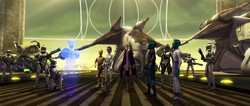
Chancellor Palpatine praises Senator Amidala for capturing Viceroy Gunray.
In a stunning turn of events, Viceroy Nute Gunray was captured by Senator Amidala and Representative Binks during the duo's mission to Rodia. When Commander Gree and his clone troopers arrived to take custody over the valuable prisoner, Chancellor Palpatine conferred with Senator Amidala via holographic transmission. Outwardly, he was very pleased to see that not only was Rodia secured once more in the Republic's fold, but also that the Republic finally had a member of the Separatist Council under arrest. Inwardly, Palpatine was furious with the setback and immediately plotted to counter the unexpected development before it could pose a threat to him or his plans.[66]
While Gunray was in the process of being transported back to Coruscant, Darth Sidious discussed the potentially dangerous situation with Count Dooku via hologram. The Dark Lord was well aware that the weak-willed Neimoidian would be no challenge for the Jedi to break under interrogation. Thus, he felt threatened by Gunray's status as the Jedi's prisoner due to all of the secrets that they could learn from the Viceroy. Dooku informed his master that he was already prepared with a counter plan; the Dark Jedi Asajj Ventress would infiltrate the Tranquility where Gunray was held. Her objective would be to retrieve the Neimoidian alive if possible, or to silence him if necessary. Sidious was initially less than enthusiastic about his apprentice's strategy. He found it odd that Dooku placed so much faith in an assassin who had a record of failing the Sith Lords on numerous occasions.[67]
The count assured his master with his very word that Ventress would be sufficient in completing the crucial objective. Despite his lack of confidence in Ventress's abilities, the Dark Lord ultimately authorized the count to proceed with the plan. After Sidious disconnected his holographic transmission, Ventress entered the bridge of the count's ship. Unwilling to risk incurring Darth Sidious' anger, Dooku strongly emphasized to Ventress the importance of breaking her track record of failures by succeeding in her latest assignment. The young assassin eagerly anticipated the success of her mission and saw it as the perfect opportunity to redeem herself in the eyes of both Sith Lords.[67]
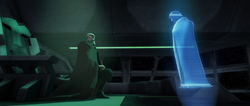
Darth Sidious confers with Count Dooku on Viceroy Gunray's capture.
Meanwhile on the Tranquility, Gunray was in the process of being interrogated by Jedi Master Luminara Unduli and Ahsoka Tano, the young Padawan of Anakin Skywalker. While under the pressure of Unduli's mind probing and Tano's threats, the viceroy hinted at his connection to Darth Sidious, referring to himself as an innocent pawn in a much larger scheme. Yet his fear of the Dark Lord far outweighed his fear of the Jedi, thus causing Gunray to withhold any further information from his interrogators.[67]
In spite of all her previous failures in the past, Ventress ironically executed Count Dooku's plan to perfection. Her infiltration of the Republic Star Destroyer with a small force of Separatist battle droids caught the Jedi and clones completely by surprise. After an intense, fiery battle with the two Jedi and their clone troopers, Ventress succeeded in retrieving Viceroy Gunray with the aid of Captain Faro Argyus, an officer of an elite force within the Senate Guard and a traitor to the Republic. By releasing Gunray from captivity, Ventress deprived the Jedi of their greatest asset at uncovering more facts regarding the otherwise mysterious Darth Sidious, thus maintaining the Dark Lord's advantage over the Jedi Order.[67]
Force children
- "I foresee an army of Force talented spies in my service. Trained in the Dark Side to peer into every corner of the galaxy from afar. And my enemies will be helpless against such vision."
- ―Darth Sidious
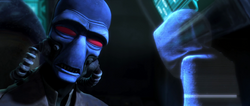
Darth Sidious and Cad Bane discuss the details of the Dark Lord's plan to abduct Force-sensitive children.
Darth Sidious' next plot involved the valuable Kyber memory crystal, held by the Jedi Bolla Ropal. The crystal held the names of every Force-sensitive child in the galaxy—the future younglings of the Jedi Order. Sidious intended to rob the Jedi Order of its future by kidnapping the children and molding them into his personal spies, trained in the dark side, to watch over his enemies from afar. To accomplish this scheme, Sidious needed a holocron from the vaults of the Jedi Temple in order to access the crystal's information. He hired the galaxy's deadliest bounty hunter, Cad Bane, to infiltrate the Temple and steal a holocron, contacting him via hologram at his Coruscant hideout. Bane was at first reluctant, as even he knew that the Temple was almost impossible to break in to undetected. Sidious suggested that Bane's legendary reputation may have been exaggerated to goad the hunter.[68]
His attack on Bane's pride had the desired effect, though Bane demanded an elite starfighter and three times his usual price. Not concerned with the hunter's heightened request, Sidious also provided Bane with detailed schematics of the Temple's security infrastructure With assistance from Cato Parasitti and Todo 360, Bane successfully stole a holocron and slipped away before the Jedi could apprehend him.[68]
The next part of his assignment required the bounty hunter to seek out Master Ropal on planet Devaron. Sidious gave Bane command of the droid ground forces, allowing him to overwhelm the Rodian Jedi's clone forces before taking him prisoner. Acting upon a direct order from the Dark Lord, Viceroy Gunray dispatched a Separatist fleet to assist Bane in his departure from the planet. Just as they were about to leave Devaron, Republic assault ships commanded by Anakin Skywalker and Ahsoka Tano came to block their escape. The Jedi pair's arrival worked to Bane's advantage, however, since only a Jedi could activate a holocron; Master Ropal was accidentally killed when Bane tried to coerce his compliance through torture. Due to Tano's recklessness, Bane was able to use her to convince Skywalker to access the holocron. After Tano's master complied, Bane inserted the crystal into the holocron, and thus received the list of all known Force-sensitive infants and their locations throughout the galaxy.[69]
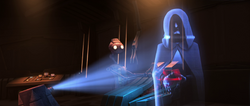
Darth Sidious overseeing his Mustafar facility via hologram.
After fleeing from the doomed Separatist ship, Bane retreated to his hideout, Black Stall Station. Contacting the Darth Sidious through a holographic transmission, Bane reported his success and inquired about the details of his next assignment. Sidious revealed that the purpose of stealing the crystal and holocron was that he needed test subjects for an experiment.[70]
Thus, he instructed Bane to use the list and acquire four children who were strong in the Force. Due to the level of secrecy surrounding the project, Sidious told Bane to bring the children to the Dark Lord's secret facility on Mustafar. Disguising himself as a Jedi, Bane successfully kidnapped two out of the four required children, Zinn Toa of Glee Anselm, and Wee Dunn of Rodia.[70]
In possession of two of his four test subjects, Sidious waited while Bane hunted down two more infants. At the same time, he used his alter ego as Chancellor Palpatine to keep an eye on the Jedi's efforts to stop Bane. As Palpatine, he learned from the Jedi that Bane was captured on Naboo. Skywalker and Tano returned to Coruscant to provide an update on their activities to Chancellor, who insisted on speaking with Skywalker alone while Tano waited outside of the Chancellor's office. The young Jedi confided in Palpatine about how he suspected that a far more powerful individual than either Cad Bane or Count Dooku was orchestrating the abduction of Force-sensitive infants. When Palpatine asked if the Jedi had any suspects to vindicate such suspicions, Skywalker explained that the true culprit's identity remained a complete mystery. Satisfied that the Jedi were no closer to discovering his Sith persona, Palpatine merely encouraged Skywalker to have patience.[70]
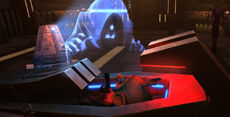
Darth Sidious foresees a future where an army of Darksiders serve as his spies and assassins.
Afterward, Darth Sidious observed the two captured children on Mustafar via hologram with great enthusiasm. Believing that their the Jedi would simply waste the infants' talents, Sidious took it upon himself to mold them into agents of the dark side—a vanguard of the Dark Lord's cadre of Force-sensitive spies and assassins. In his vision of the future, Sidious foresaw an army of Darksiders who would act as his eyes and ears throughout the galaxy, utilizing the dark side to enforce his will. Hence, he commanded RO-Z67 and another nanny droid to surgically operate on the children in order to make them better suited to his purposes for them. The droid informed him that such young subjects rarely survived the procedure. Sidious cared nothing for the lives of the infants, however, and merely saw the matter as a trial run to see how successful the procedure would be at an early stage. Even if they died, Sidious knew that he could simply start over by kidnapping more Force-sensitive children that he could experiment on until the procedure was perfected. Overall, he stood with nothing to lose and everything to gain.[70]
As the Dark Lord watched over the surgery about to be performed, RO-Z67 informed him that a starship was approaching, and that it did not belong to Cad Bane. Skywalker and Tano discovered that Bane had visited Mustafar by examining his ship's records, and had thus taken it upon themselves to rescue the children. Sidious was genuinely surprised by the turn of events as he neither anticipated nor foresaw their discovery of the children's location on Mustafar. To protect his project and secret identity, Sidious ordered the droids to remove the children to an alternate site and to destroy the facility, thus erasing any evidence of his activities on Mustafar. Despite the droids' efforts, Skywalker and Tano managed to rescue the children while the facility was in the process of falling into the planet's molten lava surface.[70]
The Zillo Beast incident
- "Doctor, a word if you please. Your new orders."
"What is this? You want me to clone the beast?" - ―Chancellor Palpatine and Dr. Sionver Boll, shortly after the death of the Zillo Beast
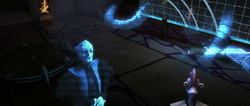
Palpatine and Doctor Sionver Boll overlook a hologram of the Zillo Beast.
Chancellor Palpatine played an integral part during the events of the Battle of Malastare, closely advising Jedi Master Mace Windu, Anakin Skywalker, and Doctor Sionver Boll in aiding the Dugs against a Separatist attack. Although the Republic was committed to preventing the Dugs' homeworld from falling to the Separatists, their true motive was to secure a treaty that would grant the Republic use of Malastare's fuel to support the war effort. The battle on Malastare was also a convenient test site for the Chancellor's new weapon, an electro-proton bomb, developed by Dr. Boll. The primary advantage of the bomb was its ability to completely decimate an entire droid army; everything electronic would be shut down if caught within the blast radius. Thus, its effects would be devastating to the Separatists' droid armies, but harmless to the Republic's Jedi and clone forces.[71]
After activating the bomb, the weapon proved to be as effective as the Chancellor anticipated. All Separatist droids were deactivated, and although the Republic's military arsenals and vehicles were shut down as well, their clone operatives were unharmed as expected. Due to the effects of the bomb, however, Palpatine's holographic communication with Malastare was cut off, and thus he did not witness the side-effect of the blast—a massive crater was opened at the site where the bomb was activated.[71]
Chancellor Palpatine's next communication with the group was an urgent message from Windu, Skywalker and Boll, stating that the blast had woken the Zillo Beast, an ancient creature from Dug history that was long thought to be extinct. The revelation of the Zillo Beast, possibly the last of its kind, presented a diplomatic dilemma for the Republic and the Jedi. The Dugs adamantly refused to sign the treaty unless the beast was dead, the Jedi way would not allow Windu to condone the killing of an innocent life form, and Chancellor Palpatine wanted the treaty signed while simultaneously securing the Zillo Beast alive. With Dr. Boll's assurance that the study of the Zillo Beast could greatly aid the Republic war effort, the Chancellor sanctioned Skywalker's plan to incapacitate the creature, which would also fool the Dugs into believing that it was dead. The next phase of the plan would be to transport the beast to a safe location where it could continue to live under the supervision of Dr. Boll.[71]
Through painstaking efforts and the stun rays of the Republic's RX-200 Falchion-class assault tanks, the Jedi succeeded in sending the Zillo Beast into a deep coma. Convinced that the creature was truly dead, the Dugs honored their promise to sign the treaty, thus bringing Malastare onto the side of the Republic in the Clone Wars. Before the beast was transported off of the planet, however, Palpatine altered his orders and instructed the Jedi to return to Coruscant with the Zillo Beast for study. Mace Windu was especially shocked by the order, but was forced to grudgingly comply despite his reservations of transporting the creature to the Galactic Capital.[71]
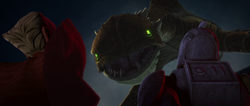
The Zillo Beast, loose on Coruscant, spots Palpatine and his escape shuttle's pilot.
The Supreme Chancellor oversaw the Zillo Beast's transportation to Coruscant, and personally greeted the Dr. Boll and the Jedi as they returned with the sedated creature in tow. Although Windu once again voiced his concern and objection to the Chancellor's course of action, Palpatine half-heartedly assured the Jedi Master that it was a difficult decision that would be well worth the risk if the creature's secrets increased the Republic's chances of defeating the Separatists.[72]
Shortly afterward, Dr. Boll reported to Chancellor Palpatine that the preliminary testing was slow and lacked results due to the severe pain that the Zillo Beast would endure under experimentation. Unconcerned with its well-being, the Chancellor merely ordered the doctor to kill the creature to continue her study without further complications. The Zillo Beast glared hatefully at the Chancellor, especially when he referred to it as a "simple animal." He also inadvertently exposed his Sith nature to the Zillo Beast. Although Dr. Boll was appalled at the thought of killing the last of a possibly sentient race, she professed her loyalty to the Chancellor and complied with his order to use the Malastarian fuel as a poison to kill the beast.[72]
Later, in his office, Palpatine was confronted by Senator Padmé Amidala and Anakin Skywalker. Though initially annoyed at the lack of secrecy over the Zillo Beast project, he indulged the senator's concerns by debating the merit and pitfalls of destroying the beast. While entertaining Amidala's arguments, however, he ordered Dr. Boll to commence with the creature's termination as soon as possible. He justified his actions to Senator Amidala, who believed that it was immoral to kill the creature, by pointing out that it was also immoral to not take every advantage that was needed to bring an end to a war that saw a rising casualty rate amongst the citizens that the Chancellor was charged to protect. He argued that the life of one animal was a small price to pay if the rewards saved countless lives in the long run. The Chancellor was also clearly pleased to see that Skywalker shared his opinion on the matter, much to the surprise and annoyance of Amidala.[72]
When Dr. Boll attempted to complete her orders, she soon discovered that the amount of toxins she utilized was not sufficient to kill the creature. Nevertheless, the Zillo Beast endured a great deal of pain. To the scientist's surprise, however, the beast used channeled its pain into a source of strength and rage, thus allowing it to break free of its restraints. The clone security forces proved to be utterly inadequate at containing the creature, which then went on a rampage through Coruscant in a hunt for the man who ordered its liquidation. It soon found its target at the Republic Executive Building. Unable to rely on his own powers without revealing his true self to Skywalker and Amidala, Palpatine decided on fleeing from the beast before it could put a premature end to his plans for the future.[72]
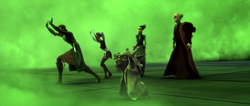
The Jedi save Chancellor Palpatine's life during the Zillo Beast Incident on Coruscant.
Palpatine then led Skywalker and Amidala, as well as their droids R2-D2 and C-3PO, to his personal executive shuttle piloted by a commando of the Senate Guard. Just as they took off, however, the shuttle was caught in the beast's grip. Skywalker then used his lightsaber to cut the shuttle in half in order to escape. Although he, Amidala and the droids succeeded in exiting the shuttle without injury, Palpatine and his pilot were still trapped by the beast until Grand Master Yoda and Aayla Secura provided a sufficient distraction to allow the Chancellor to escape from his damaged shuttle. At the Senate Commando's insistence, the Chancellor used R2-D2 to flee from the Zillo Beast just before the commando was killed in its path. As it pursued its target, Palpatine ordered the gunships to use the gas bombs. Dr. Boll's massive increase in the amount of toxins proved effective and the Zillo Beast was rendered utterly helpless as the clones mercilessly unleashed one volley of gas bombs after another upon the creature. As the gas cloud began to spread, Skywalker, Yoda and Secura used the Force to protect themselves, Palpatine and Amidala from the harmful effects of the Malastarian gas. As the Jedi looked on in regret, the Zillo Beast, confused, in pain and dying, succumbed to the toxin and fell from the Executive Building to its death below.[72]
The next day, the Zillo Beast's lifeless body was in the process of being carted away. Even Skywalker, who was initially in favor of terminating the beast, came to lament its tragic death because of the Republic's mistakes. The Chancellor, escorted by a group of Senate Guards, assured the Jedi and Senator Amidala that the beast's death would not be in vain. As he departed ways with them, however, he presented Dr. Boll with a new order to clone the Zillo Beast for further scientific purposes.[72]
The Death Watch
- "Sadly, Deputy Minister Jerec perished this morning in a Death Watch bombing on Kalevala. Let us ensure that his death was not in vain. Let us commit our military might to defending the Mandalorian people."
- ―Chancellor Palpatine, addressing the Galactic Senate
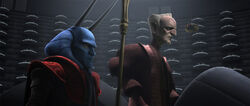
Palpatine and Mas Amedda push for Republic intervention on Mandalore in the Galactic Senate.
When Duchess Satine Kryze of Mandalore made a voyage to Coruscant to plead that the Death Watch remain a matter of internal Mandalorian affair, Chancellor Palpatine spearheaded the movement in the Senate that called for military intervention against the radical organization. Their platform was based on the increasing acts of violence conducted by the Death Watch, as well as Mandalore's unreliability at resolving a crisis on their own. While the Senate was in session, Duchess Kryze implored the senators to allow the Mandalorians to maintain their policy of neutrality in the Clone Wars and to handle the Death Watch situation without Republic assistance. The Chancellor defended his position by pointing out Kryze's inability to curb the escalating threat of Death Watch.[73]
Palpatine then revealed a holographic recording of Deputy Minister Jerec, who accused Kryze of acting out of pride by rejecting Republic aid and that Death Watch was far too out of control for the Mandalorians to handle alone. The hologram effectively discredited Kryze's entire argument, thus securing an early victory for Palpatine's position of Republic occupation on Mandalore. The Senate concluded its session after the Chancellor announced that the vote would be conducted in the next session.[73]
Shortly after the Senate concluded its session, Dutchess Kryze met with Chancellor Palpatine and Vice Chair Mas Amedda at the Republic Executive Building where she informed them of an attempt on her life. Despite asserting that someone was trying to assassinate her, the Chancellor refused to conduct an investigation due to the lack of evidence to support her claim. In truth, Palpatine merely distracted her in his office while the occupation vote was passed in the Grand Convocation Chamber. Due to the attempt on Duchess Kryze's life, many in the Senate believed that the Death Watch was responsible, thus motivating them to vote on the matter ahead of schedule. Much to the Duchess's dismay, the vote was passed with an overwhelming majority support for Republic military assistance.[73]
But when Duchess Satine Kryze, with the aid of the Jedi Obi-Wan Kenobi, discovered that the recording of Jerec was an altered version of his last speech before the Bombing on Kalevala, Senator Padmé Amidala agreed to present the true recording to the Senate before the Grand Army could be dispatched to Mandalore. While addressing the Senate on their Mandalorian agenda, Chancellor Palpatine was interrupted by Senator Amidala, who then displayed the full recording of Deputy Minister Jerec. The Senate was shocked to learn that it had been fooled by a tampered version of Jerec's speech, whose true position was the same as Duchess Kryze. Palpatine was visibly caught off guard for moment, but then smiled as though he approved of the unexpected revelation. As a result, the Grand Army's mission to Mandalore was called off when the Senate repealed its vote in an emergency session.[73]
Back in the Chancellor's office, Palpatine thanked Amidala for the new information that eliminated the need for Mandalore's occupation. The senator deferred credit to Duchess Satine Kryze, whose actions ultimately allowed the Mandalorians to continue their neutral policy. Palpatine apologized to the duchess for the recent series of events and praised her for her loyalty to the Galactic Republic. Shortly afterward, the Chancellor oversaw the execution of the Senate's decision with Vice Chair Amedda and Senator Amidala.[73]
Senate hostage crisis
- "You were foolish to think you could get away with this, bounty hunter! Now, lay down your arms and come quietly."
"No, Chancellor. I'm afraid it is you who has been foolish…with your senators' lives. One false move, and the East Wing of the Senate Building goes up in smoke." - ―Chancellor Palpatine and Cad Bane
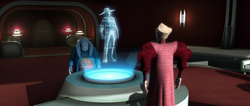
Chancellor Palpatine and Senator Orn Free Taa speak to Cad Bane during the hostage crisis.
During the Senate hostage crisis, Chancellor Palpatine was in his office when a group of bounty hunters infiltrated the Republic Executive Building. Led by a notorious mercenary known as Cad Bane, the group killed a squad of Senate Commandos under the command of Captain Jayfon and took a group of senators hostage, including Padmé Amidala and Bail Organa. When Senator Orn Free Taa informed the Chancellor of the mercenaries' intrusion, Cad Bane contacted Palpatine via hologram and threatened to execute the senators unless the prisoner Ziro Desilijic Tiure was released from the Central Detention Center. When Palpatine refused to be strong-armed into freeing the Hutt criminal, Bane had the Executive Building's power shut down. Due to the resulting emergency lockdown, Palpatine and Taa were trapped in the office with their external communications disabled.[74]
While trapped inside of his office, the Chancellor received a secret transmission from the Jedi Knight Anakin Skywalker, who had been in the building at the same time when the crisis broke out. Palpatine informed Skywalker of the situation, and the young Jedi attempted to resolve the situation before Palpatine was forced to release Ziro. But due to Skywalker's failure and capture, Palpatine agreed to provide a pardon disc, which he then gave to a reluctant Senator Taa along with the task of overseeing the end of Ziro's incarceration. On Taa's orders, however, a unit of Coruscant Guard troopers broke through the transparisteel window of Palpatine's office and secured the Chancellor. Outside on a landing platform, a pair of LAAT/i gunships arrived at the prison compound, and Coruscant Guard troopers led by Commander Fox piled out and cornered the bounty hunters.[74]
Palpatine contacted Bane and ordered him to surrender, but the bounty hunter revealed the still-trapped senators, and in order to keep them safe, Palpatine reluctantly relinquished his attempts to apprehend Bane. Commander Fox ordered his clone forces to stand down, allowing Bane and his team to leave with Ziro. Back in the East Wing of the Executive Building, Skywalker succeeded in saving the senators before Bane's thermal detonator could kill them. By then, however, it was too late for Palpatine to prevent the bounty hunters' escape from Coruscant.[74]
Eliminating Ventress
- "I would hate to think that you are training your own Sith apprentice to destroy me."
"Never! I am loyal to you and you alone!"
"Then you must prove it… Eliminate her." - ―Darth Sidious orders Darth Tyranus to kill Asajj Ventress
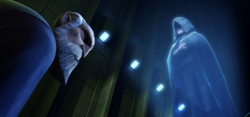
Sidious orders Tyranus to eliminate Ventress.
As the Clone Wars progressed according to Darth Sidious's design, Asajj Ventress steadily grew in strength through her increasing connection to the dark side of the Force. Despite her constant failures, Darth Tyranus considered her as one of his most dependable assassins. But through the Force, Sidious had learned of Ventress's improved skills and began to suspect his apprentice of violating the Rule of Two. Through a holographic transmission, Sidious accused Tyranus of harboring ambitions to overthrow the reigning Dark Lord of the Sith by secretly training Ventress as a Sith apprentice. Tyranus appeared shocked and vehemently denied the accusation, swearing that his loyalty was unquestionably to his Master and their cause. Unmoved by his apprentice's apparent display of subservience, the Dark Lord commanded Tyranus to prove his allegiance by severing all connections to her, mainly by ensuring her death. When Tyranus tried to vouch for his assassin by stressing her importance to the Sith, Sidious became enraged and simply reiterated his command. With his Master's mind clearly made up, Tyranus could do nothing other than obey Sidious's command.[75]
Shortly after receiving his new orders, Tyranus was contacted by Ventress, who sought assistance in her fight against Obi-Wan Kenobi and Anakin Skywalker. By then, however, Tyranus had already recalled Ventress's reinforcements. He declared that her latest failure would be the last one as she was no longer his apprentice. After the destruction of the Providence-class destroyer that Ventress was trapped on, Tyranus assumed that his former disciple was dead. Believing her to be dead, Tyranus contacted Darth Sidious to inform him of his apparent success. With a tone of amused satisfaction in his voice, Sidious commended his apprentice for once again proving his loyalty to the Dark Lord.[75]
A brief revelation
- The Son: "Join me and together we will destroy this emperor you see in your visions and we shall end war, corruption and suffering throughout the galaxy."
- Anakin Skywalker: "Will we bring peace?"
- The Son: "Of course."
- ―The Son and Anakin Skywalker[src]
When Anakin Skywalker, Obi-Wan Kenobi and Ahsoka Tano were transported to a mysterious world known as Mortis, they encountered three sentient beings—The Father; the physical manifestation of the Unifying Force; the Son; the living incarnation of the dark side of the Force; and the Daughter; the embodiment of the light side. Since the Son was a physical representation of the dark side, he shared many similar personality traits with Darth Sidious, and could even mimic the Dark Lord's voice.[76]
After discovering that Anakin Skywalker was truly the legendary Chosen One, the Son became as determined as Sidious to corrupt the young Jedi Knight at any cost. To achieve this goal, he utilized the same tactic that Darth Sidious later employed to turn Skywalker—temptation; the promise of gaining the power to prevent a catastrophic future. With his foreknowledge of the future, the Son forced Skywalker to bare witness to who he was destined to become. Among the images that Skywalker saw were younglings slain by his lightsaber, the death of his wife by his own hand, his failed attempt to murder Obi-Wan Kenobi, and the destruction of Alderaan. To his utter shock and horror, he also saw that his fall to the dark side would be engineered by the man whom he idolized as a mentor—Supreme Chancellor Palpatine. Through the Son, Skywalker saw Palpatine's true face, pale and twisted by the dark side; he saw the Chancellor's future self as the Emperor of the Galaxy, a merciless tyrant who's reign would culminate in the deaths of trillions and the destruction of the Jedi Order. Before breaking down in total despair, Skywalker saw the "face" of his own future self; a broken shell of a man who was condemned to being trapped in a life-sustaining suit of armor for the rest of his natural life.[76]
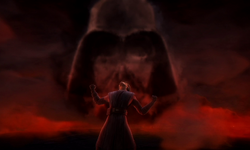
Anakin Skywalker despairs over his future as the apprentice and slave of the Sith Lord Darth Sidious.
The revelation of his dark future, as well as the fact that Palpatine and Darth Sidious were one and the same, left Anakin Skywalker in a state of utter shock and fear over the atrocities he would eventually commit as a Sith Lord. The Son capitalized on his opportunity and assured the Jedi Knight that the visions did not have to come to pass. With the knowledge of things that had not happened yet, they could change the course of history by preventing Darth Sidious from ever becoming Emperor. But to do so, the Son implored, Skywalker had to submit himself to the dark side in order to gain the power he needed to destroy Sidious and save the Galaxy from its apocalyptic future. With the last of his resistance broken by his desire to save the ones he loved, Skywalker willingly pledged himself to the teachings of the Son and through him, the dark side of the Force.[76]
But before Skywalker could ever return to Coruscant and act upon the knowledge he had gained by slaying Sidious, the Father erased the young Jedi's memories of the visions that the Son had shown him. The Father had no intention of allowing the Son to alter the future through Skywalker. Without the information of what was to come, Skywalker swiftly reverted to his previous state and awoke with absolutely no memory of his future. Thus, he continued to view the Chancellor as a good man whom he could confide in. Until the end of the Clone Wars, Skywalker operated under the belief that Chancellor Palpatine and Darth Sidious were two separate individuals.[76]
Failed abduction plot
- "One shudders to think where the galaxy would be without the Jedi."
- ―Palpatine, shortly after his second rescue

Skywalker fights Dooku while trying to prevent Palpatine's abduction.
Shortly before Chancellor Palpatine's scheduled visit to Naboo, the Jedi Order discovered that Count Dooku was planning to abduct the Republic head of state. Although Moralo Eval—the criminal mastermind behind the plot—was incarcerated on Coruscant, the Jedi High Council felt that there was insufficient time for interrogation, especially since Palpatine decided to proceed with his planned arrival on Naboo despite the Council's warnings. To ensure the Chancellor's safety, the Council dispatched Obi-Wan Kenobi to infiltrate the Republic Judiciary Central Detention Center; his main objective to uncover the plot before it could be executed. After staging his own death, Kenobi entered the prison as Rako Hardeen, the mercenary who had been hired to kill him. With the exception of the Council members, the plan was kept a secret from everyone, including Palpatine and Anakin Skywalker.[77]
Kenobi was forced to alter his plan after an unexpected prison riot broke out, allowing him to escape Coruscant with Eval and Cad Bane.[77] Skywalker was livid that the Jedi Council did not move to recapture "Hardeen," whom he believed to be the killer of his former Master. With Palpatine's encouragement, the Jedi Knight and his apprentice, Ahsoka Tano, left the capital to track the escaped inmates without the Council's knowledge.[78]
Later, the Chancellor arrived on Naboo to host the Festival of Light, although he was also accompanied by a large force of clone troopers, including several Jedi such as Skywalker, Tano and Mace Windu. Dooku's mercenaries, including Kenobi—still disguised as Rako Hardeen—were also on Naboo, preparing to kidnap the Chancellor. The plot was ultimately undermined by Kenobi, who prevented the bounty hunters from taking Palpatine off of Naboo.[79]
After his rescue, Palpatine dismissed most of the military units that had accompanied him to Naboo since the plot had apparently been foiled. Later, however, he and Anakin Skywalker were ambushed by Count Dooku and several IG-100 MagnaGuards. Skywalker destroyed a few of the droids and dueled with Dooku while Palpatine watched with satisfaction as the young Jedi gave in to his anger, thus drawing him closer to the dark side of the Force. Skywalker's attacks nearly overwhelmed Dooku, but the Sith Lord temporarily subdued him with Force lightning. Kenobi arrived and prevented the Chancellor's abduction for a second time, forcing Dooku to retreat in a shuttle as Senator Padmé Amidala arrived with a squad of Naboo guards.[79]
Resurfacing of Darth Maul
- "Remember, the first and only reality of the Sith: there can only be two. And you are no longer my apprentice. You have been replaced."
- ―Darth Sidious taunting Darth Maul
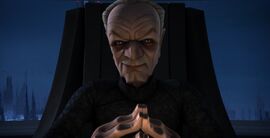
Palpatine smiles at the news of Darth Maul's survival.
Shortly after his murder of Darth Plagueis on the eve of his election as Supreme Chancellor, Sidious had been led to believe that his Sith apprentice, Darth Maul, had been slain. He eventually discovered Maul's survival after Anakin Skywalker mentioned the Zabrak's name, which at first startled Palpatine.[80] Later, he heard a report of a skirmish on Florrum between Maul, his brother Savage Opress, as well as Jedi Masters Obi-Wan Kenobi and Adi Gallia, and a band of Weequay pirates on the planet. Upon being briefed of the skirmish in the aftermath, Palpatine advised Obi-Wan to ignore the Sith brothers, as they were ultimately unimportant in the greater crisis. Palpatine continued and said that he was of no direct threat to the Republic, and that he should focus on defeating Count Dooku and the Separatists. Kenobi persisted that they would pose great threats, but Palpatine dismissed this and dismissed the Jedi from his office. Yoda reluctantly agreed with Palpatine, as he feared that Obi-Wan was taking the matter too personally. As the Jedi left, however, the Chancellor smirked, indicating that he had plans for Maul and Opress in the future.[81]
Later, as Palpatine meditated in his office, he sensed the increasing power of Maul and Opress on the planet Mandalore, and when Mas Amedda entered the room at his request, he simply requested that Amedda prepare his shuttle for immediate takeoff. Palpatine then took the shuttle to the Sith brothers' new headquarters on Mandalore, in order to confront them as his Sith persona of Darth Sidious.[82][83]
Upon disembarking from his ship, Sidious Force-choked two members of the Shadow Collective, the criminal organization founded by Maul and Opress. He then rode a speeder to the Royal Palace of Sundari, and proceeded to confront the Dathomirian brothers in the throne room. Maul sensed his former master just before two of his guards were lifted into the air and Force-choked to death, and then master and apprentice found themselves face to face after twelve years. Sidious exchanged a few brief words with his former student, declaring Maul a rival Sith—as he had taken his own apprentice and was attempting to carve out his own galactic territory. Sidious then pushed the brothers into a wall using the Force.[82][83]
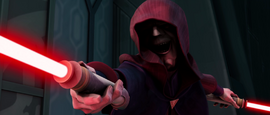
Sidious seemed to find his duel with Maul and Opress entertaining.
After he released the brothers from his telekinetic grip, Sidious summoned two of his lightsabers to combat them. Although the Sith brothers briefly managed to overwhelm Sidious by having Savage push him off the platform, it was only temporary as Sidious Force pulled them over as well. Gaining the upper hand, Sidious drove his opponents back, and the duel ended in the plaza outside the palace. After using the Force to temporarily incapacitate Maul, Sidious dueled Opress alone, but in mere seconds Sidious impaled Savage in the chest with his two lightsabers, killing him. After Maul witnessed the death of his brother, Sidious explained to him that there could only be two Sith at one time, and that Maul had been replaced.[82][83]
Maul angrily ignited both his lightsaber and Pre Vizla's darksaber, and charged at Sidious. After a brief duel between the two, Sidious disarmed Maul and brutally battered him against the floor and walls with telekinesis. Defeated, a frightened Maul begged for mercy. Sidious replied that "there is no mercy" and launched a barrage of Force lightning into his former apprentice. Nonetheless, Sidious stated to Maul that he had no plans to deprive him of his life, indicating that he still had some use for the Dathomirian.[82][83]
Trial of Ahsoka Tano
After the Jedi Padawan Ahsoka Tano was arrested for allegedly killing a suspect in the Bombing of the Jedi Temple Hangar and being the conspirator in the bombing, Palpatine presided over the trial for Tano. He was about to pronounce her guilty when Skywalker intervened, unveiling the actual culprit: Barriss Offee.
Hitches in the Grand Plan
During the late stages of the Clone Wars, Palpatine, or rather, Sidious had several endangering obstacles occur in regards to his Grand Plan:
In 20 BBY, his secret contingency plan for Jedi rebellions was nearly exposed due to a malfunction in one of the clone trooper's biochips, resulting in an incident during one of the Republic's battles where the clone trooper, Tup, ended up shooting a Jedi commander while in a trance-like state. He alongside Dooku attempted to have Tup abducted by Separatists while he was sent to Kamino to silence the clone trooper. The abduction failed, and it resulted in the ARC trooper Fives learning of the conspiracy when trying to save his friend's life. Palpatine eventually learned of this when Shaak Ti, unaware of Palpatine's connection to the conspiracy, informed the Supreme Chancellor of Five's discovery and demanded a meeting. After making the meeting private, Palpatine then framed Fives for attempting to assassinate him in order to issue a manhunt against Fives. Fives eventually ended up killed shortly thereafter after a failed attempt at warning Rex and Anakin Skywalker, ensuring the conspiracy was kept secret.
Later, Sifo-Dyas' vessel was uncovered on Felucia. As the vessel potentially contained evidence to Palpatine and Dooku's involvement in Sifo-Dyas' murder, Sidious ordered Dooku and the Separatists to "clean up" the site.
The Sector Governance Decree
Throughout the war, Palpatine appointed governors answerable to him every time a Separatist world was freed. A few instances speak for many others. After a local uprising liberated Esseles, Palpatine appointed Griff Takel to serve as governor (21 BBY) instead of restoring Senator Gabrial Atanna. That same month, he did the same on Brentaal IV, which had languished under the provisional authority of Jerrod Maclain since its liberation the year before. Rather than restore Senator Arcel Mosbree, Palpatine arrested Mosbree for his role in allowing the Separatists to take Brentaal in the first place, and Maclain became the permanent governor. Even then, his critics speculated that it was only a matter of time before he did so everywhere. In the closing days of the war (19 BBY), Palpatine issued the Sector Governance Decree, which installed governors on all Republic member worlds.
|
Palpatine: I assure you that the Republic governors are intended only to make your systems safer—by coordinating planetary defense forces, and ensuring that neighboring systems mesh into cooperative units, and bringing production facilities up to speed in service to the war effort. That's all. They will in no way compete with the duties and prerogatives—with the power—of the Senate. |
That was the reason he gave to his critics, and most felt it was the right approach. Increased coordination at the system and sector level seemed a sensible move in wartime. Palpatine now controlled those systems directly. With the rubber-stamp approval of his Senate supermajority in his hand, he wasted no time in sending his handpicked governors to their respective systems. They arrived practically before the ink had even dried on the decree. And to ensure that the planetary populations would accept the governors without too much complaint, he sent with each of them a full regiment of clones—security forces, he called them—more than enough to keep the locals quiet.
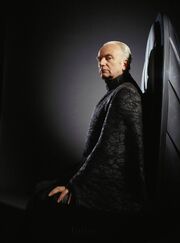
Palpatine during the Battle of Coruscant.
The search for Darth Sidious
- "Sidious. I know the name…"
- ―Palpatine's reaction to Mace Windu's revelation that the Jedi are attempting to expose Darth Sidious
Because of the clouded post-war future, the Jedi Council started to suspect somebody from his Inner Circle, most notably Sate Pestage, to be the "Darth Sidious" that Count Dooku had revealed to Master Kenobi on Geonosis. They started to suspect this after the Battle of Cato Neimoidia in 19 BBY, three years into the war. Republic forces under Captain Jan Dodonna captured Viceroy Gunray's mechno-chair, which led them to Sidious' hideout, the LiMerge Power building, in the Works on Coruscant, in turn leading to Palpatine and his advisor's apartment at 500 Republica. Facts became invaluable. This suspicion was later fuelled further when Mace Windu admitted to the Supreme Chancellor that he was searching for Darth Sidious, when Palpatine reacted with some recognition to the name.[84]
Palpatine knew that the end was near, and assigned the majority of the galactic capital defense fleet to take down what he dubbed the "Triad of Evil." At the same time, his alter-ego commanded the cyborg General Grievous to use a secret hyperlane through the Deep Core to attack Coruscant itself. The endgame for his decades long plan had begun.[84]
"Kidnapped"
- "All the players are now in place. It is time to initiate the end moves. The plan of many long years shall bear fruit at last!"
- ―Darth Sidious
Palpatine is taken by Grievous.
Palpatine then gave his state of the union address to the public after secretly commanding General Grievous to commence the attack during this ceremony. During the address, he also supplied medals to X1 and X2 for their heroism during the Invasion of Tatooine, although he also mixed up the two, and also hinted that something other than the time of their births separated them.[84]
During the chaos of the battle, he also arranged for an ambush by Geonosians just outside his apartment under his alter ego of Darth Sidious for Valiant and Dyne, having anticipated that they were very close to discovering his true identity in their investigation. Dyne ultimately deduced in his last breath that Palpatine and Sidious were the same person after getting a brief glimpse of the Sith Lord, although Palpatine figured it was inconsequential, as the clone trooper had a few seconds left of life anyway. Afterwards, using his public persona, Palpatine was spirited away to his bunker with General Grievous, the Supreme Commander of the Droid Armies, in close pursuit, killing many of his bodyguards and Jedi on the way.[84] However, thanks to his own planning, he was "abducted." Obi-Wan Kenobi and Anakin Skywalker were ordered to Coruscant from the ruined world of Tythe where their hunt for Count Dooku had led them to rescue the Chancellor. They eventually found Palpatine, bound to a chair in the General's quarters of Grievous's flagship, Invisible Hand. Before they could rescue him, however, Tyranus appeared and the three of them dueled. In reality, this was merely a test of Anakin's vulnerability to the dark side in a confrontation with Darth Tyranus.[10]
Tyranus was aware that this duel was meant to lead Anakin to the dark side, but he was unaware that he would be sacrificed to achieve this. Sidious led him to believe that after he let Anakin subdue him, he and Sidious would together convince Skywalker to switch to the dark side. Tyranus would then surrender, pretend to having been unaware of the atrocities committed by General Grievous, and then emerge as the venerable leader of a new Sith army and the right hand of Sidious.[23]
However, Tyranus had forgotten Darth Bane's dictum—there could be only two.[23] As they dueled, Palpatine silently rooted for Anakin. Obi-Wan was rendered unconscious while battling Tyranus, but Anakin continued to fight. When Anakin sliced off the Sith Lord's hands and had him down on his knees with both Tyranus' lightsaber and his own crossed at his neck, Palpatine was ecstatic and broke his silence, urging the young Jedi to kill Tyranus.[10] The Count realized he had been nothing more than a pawn in Sidious's schemes,[23] while Anakin argued that he should not murder a defenseless prisoner in cold blood. Palpatine continued to goad Anakin to finish Tyranus off, and he finally gave into his hatred of his nemesis and sliced off the Count's head, his body falling lifelessly to the floor.[10] This was another victory for Sidious. The only event he had not expected was that Dooku failed to kill Kenobi and that Anakin refused to leave him behind.[23] It was of little concern, however. By defeating Tyranus in combat, Anakin had proven that he was now powerful enough to take his place at Sidious's side, something that the Sith Lord felt he would have little trouble in orchestrating. Palpatine nearly ended up killed when the Invisible Hand sunk into the atmosphere of Coruscant, with only Anakin's quick and improvised piloting skills of the doomed vessel saving him.[10]
Shortly after the battle, Palpatine, as Sidious, contacted Grievous informing him that the Separatist council needs to be relocated to Mustafar, and informed him that the war's conclusion drew closer. When Grievous protested that the loss of Count Dooku would mean the end of the Separatists, Sidious informed him that his loss was necessary to cement a new apprentice who was both "far younger and more powerful."[10]
The day after the Battle of Coruscant, the Security Act amendment was passed by the Galactic Senate by a wide margin. The amendment was personally written by Palpatine but given to a loyal senator to introduce, in order to maintain the facade of the Senate forcing power on him against his will. It nominally transferred command of the Jedi High Council from the Senate directly to the Chancellor, thus providing him with the Constitutional authority to disband the Jedi Order. It also removed Jedi and Senatorial oversight of the Republic's military, placing the Chancellor in direct command and naming him Supreme Commander of the Republic Military.[23]
Endgame (19 BBY)
Jedi suspicion
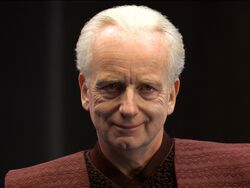
Palpatine reveals his Sith identity to Anakin Skywalker, predicting Padmé's certain death.
- "The Chancellor is not a bad man, Obi-Wan. He befriended me. He's watched out for me ever since I arrived here."
"That is why you must help us. Anakin, our allegiance is to the Senate, not to its leader, who has managed to stay in office long after his term has expired."
"The Senate demanded that he stay longer!"
"Yes, but use your feelings, Anakin. Something is out of place!"
"You're asking me to do something against the Jedi Code! Against the Republic! Against a mentor and a friend! That's what's out of place here! Why are you asking this of me?!"
"The Council is asking you." - ―Anakin Skywalker and Obi-Wan Kenobi about spying on Palpatine.
Over time though, the Jedi began to grow distrustful of Palpatine, fearing what this ever-increasing power might mean for the Republic. Not long after Palpatine became Supreme Commander, the High Council wanted Anakin to use his relationship with the Supreme Chancellor as an excuse to spy on him and report his activities to the Council. Shocked by this assignment, Anakin argued that the Senate had, supposedly, voted unanimously to give the extra powers to Palpatine, and that he was only doing it in the name of preserving democracy in the Republic. However, Obi-Wan was less sure and tried to convince Anakin that something had to be out of place for the Chancellor to accumulate so much power and for him to remain in office far longer than was usually allowed. But Anakin was convinced that Palpatine's intentions were good and adamantly refused to spy on the man who had acted as a mentor and father figure to him. With this new development, Anakin's loyalties became tremendously conflicted.[10]
Mace Windu, in particular, became wary of the relationship between Anakin and Palpatine, going so far as to say that he did not trust him and that it was "dangerous" seeing them together. Even in the last days of the war, Windu claimed to sense that the dark side of the Force surrounded the Chancellor, and suspected a plot to destroy the Jedi.[10]
At the same time, Sidious was sowing similar seeds of doubt into the mind of Anakin. Young Skywalker saw a vision of his wife, Padmé Amidala, dying after giving birth to their child. Palpatine, who probably planted this vision of the future in Anakin's mind himself, promised the young Jedi to open his mind to the Sith knowledge of sustaining or creating life, which—as he claimed—was the only way to avoid Padmé's death (he had known of Padmé and Anakin's marriage after the head of the Royal Naboo Security Forces, Captain Quarsh Panaka, informed him). Sidious was able to secretly lure Anakin by making him his representative on the Jedi High Council. The Council reluctantly agreed to permit Anakin's seat on the Council, but he did not receive the rank of Master, angering him. Eventually, the inevitable confrontation emerged, and Palpatine revealed that he was Darth Sidious, the Sith Master for which they had been searching for thirteen years. Anakin nearly killed Palpatine on the spot. However, after Palpatine implied that such an action would result in Anakin's fall to the Dark Side, Anakin instead returned to the Temple and notified Master Windu.[10]
Confrontation in the Chancellor's Suite
- "In the name of the Galactic Senate of the Republic, you are under arrest, Chancellor. "
"Are you threatening me, Master Jedi?"
"The Senate will decide your fate."
"I AM the Senate!"
"Not yet!"
"It's treason, then." - ―Mace Windu and Palpatine in the Chancellor's office.
Mace ordered Anakin to remain in the High Council chamber to try and calm his raging emotions, while he, along with Masters Saesee Tiin, Agen Kolar, and Kit Fisto, went to arrest the Chancellor. Palpatine greeted the Masters cordially, as though nothing had changed, though he knew that the endgame had begun. The four Masters boldly ignited their lightsabers, and Mace declared that Palpatine was under arrest and that the Senate would decide his fate. "I am the Senate," Palpatine proclaimed, revealing an electrum saber of his own design hidden in his sleeve. A crimson blade ignited, and within seconds the Jedi Masters realized they had been tricked, that they were pawns that had been manipulated for the last thirteen years. Shrieking a bestial Sith war cry, Darth Sidious lunged forward and killed Masters Kolar and Tiin before they could defend themselves. Master Fisto held against Sidious for a few seconds before he was slain by the Sith Lord's blade. Left alone with Mace Windu, the Dark Lord fought him in a one-on-one lightsaber duel.[10]
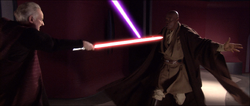
Palpatine battles with Mace Windu in the Chancellor's Office.
After several minutes of dueling, despite Sidious' formidable lightsaber style and technique, the Jedi Master managed to disarm the Sith with a kick to the head, causing him to drop his lightsaber out of the office window only moments before Anakin Skywalker entered the room.[10]
Sidious tried to even the odds by firing Force lightning at Windu. However, this proved futile, as Windu used his lightsaber to reflect it back at the Sith Lord, revealing his true form.[85]Cite error: Invalid <ref> tag; invalid names, e.g. too many[86] However Palpatine defined this event as assassin attempt of the jedi and claimed jedi gave this scar to him. His face began to sag and turn pale, his eyes, fingernails and teeth turned yellow as his voice grew ragged and deep. He pleaded with Anakin, convincing him his grotesque visage was the result of Windu's attack, and that he was too weak to hold off the attacks any longer. Windu proclaimed that he would put an end to Sidious, but Anakin argued that it was not the Jedi way and that he must stand trial. Mace deemed Palpatine too dangerous to be left alive, as he had complete control over both the Senate and the Courts, but Skywalker had decided that only Sidious could save his wife from the death he had seen in his visions. He had to choose between the Jedi that appeared to abuse their power and the seemingly helpless and weak old man. As Windu raised his lightsaber to deliver the killing blow, the young Jedi Knight chose Sidious, severing Mace's sword hand. Sidious then sprang back to life and assaulted Windu with a devastating blast of Force lightning and hurled the Jedi Master from the building to his death far below.[10]
The birth of Darth Vader
- "To cheat death is the power only one has achieved, but if we work together, I know we can discover the secret."
- ―Darth Sidious
Palpatine kills Mace as Anakin looks on.
With Windu eliminated, Sidious regarded Skywalker. At last the boy was where the Sith Lord needed him to be; isolated and unable ever to go back to the Jedi Order now that he was an accomplice—no matter how unwittingly—in the revered Master Windu's murder. Desperate to save his wife's life, Skywalker had effectively sacrificed an ally and compatriot, perfectly fulfilling the Sith covenant that commanded the slaughter of one who was close. With no other place to turn, he finally yielded to Sidious's temptations, asking only that a way be found for Padmé to live. To smooth the transition, Sidious soothed his fears, and his conscience.[10]
So for the second time he openly promised Skywalker that Padmé could be saved from death. This was strictly a deception, meant to turn Skywalker away from the Jedi fold.[24] In the end, whether or not there truly was a way to save Amidala was unimportant. Anakin Skywalker went down on bended knee before Sidious and pledged himself to the Sith. Sidious gave his new apprentice the Sith name Darth Vader.[10]
The fall of the Jedi Temple
- "First, I want you to go to the Jedi Temple. We will catch them off balance… Do what must be done, Lord Vader. Do not hesitate; show no mercy."
- ―Darth Sidious
Like Maul and Tyranus, Vader had to demonstrate his allegiance through decisive action. Sidious had already convinced him that the Jedi were conspiring to take power, so it was easy to nudge him into the right frame of mind, reminding him that the Jedi would not stop until Sidious was dead, and if he were gone, what hope did Padmé have? For her sake, the Jedi had to die to the last being. He ordered, "Do what must be done, Lord Vader. Do not hesitate. Show no mercy. Only then will you be strong enough with the dark side to save Padmé." To this end, he placed under Vader's command the 501st Legion, a special clone trooper unit he had long ago set aside for just such tasks, and sent them off to the Temple. Operation: Knightfall would prove successful, and the Temple would soon be ablaze.[10]
In cutting down the most vulnerable members of the Order to whom he had once sworn allegiance, Vader would tie himself firmly to the Sith cause. The slight chance that he could try to return to his old life would become nonexistent. It would especially serve to sever Skywalker's ties to his wife; no matter how much she loved him, there would be no way Amidala could understand, much less forgive, his actions. She might even lose the will to live, and could then be dealt with effortlessly at a time of his choosing.[23]
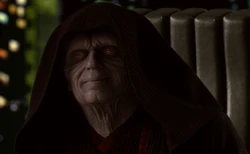
Darth Sidious savors his victory over the Jedi.
Sidious' new apprentice performed splendidly; through the night and into the early morning Vader led his troops through the Temple corridors in an orgy of carnage.[10] Before leaving the Temple on his futile charge to the Senate Office Building, Master Windu had instructed one of the few Council members present, Shaak Ti, to prepare the Temple for a possible counterattack, but her best efforts were hardly enough to repel an entire legion of his handpicked troops. So many Jedi were away that only a token force remained behind to defend the younglings. Almost unopposed, Vader's blade and the clones butchered the Temple's younglings and their masters.[10]
When Vader and the 501st—which would soon earn the name of "Vader's Fist"—completed their errand, the Jedi Temple, repository of twenty-five thousand years of the Order's history, was but a smoking ruin.[10] Originally, the building was to be destroyed; however, for some reason, Palpatine decided not to raze the old edifice to the ground. Some rumors hinted that he would be converting it into his new official residence, but the monument of self-glorification that was the Imperial Palace would be erected elsewhere. Perhaps he simply wanted to be able to gloat over the ruin, to let it remain as a permanent reminder of the arrogance of the Jedi Order, and of just how far, through his cunning, it had fallen.
Order 66
- "What about the other Jedi spread across the galaxy?"
"Their betrayal will be dealt with." - ―Darth Vader and Darth Sidious
While Vader "sterilized" the Temple, Sidious saw to the other Jedi. After a thousand years of planning, the time for revenge had come. His instrument was, of course, his Grand Army.[10] The clones had been issued a list of orders on actions to take during specific emergency situations. One of these was Order 66: should the Jedi become involved in sedition against the Republic, the clones were to deal with them.[87] Order 66 was not hardwired into the clones by the Kaminoans. The "rebellion" allowed this order to be given plausibly. The Jedi would not see it coming; they had forged a bond with their troops, but the Jedi forgot that the clones served the Republic, not them. He—not the Council—was the supreme commander of the Grand Army, and its troops had been made to follow his orders without question, even if they were ordered to kill their own field commanders.
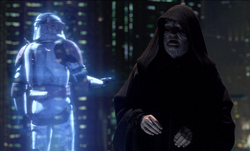
Returning to the sanctity of his private office, Sidious reached out to key a special frequency into his holocomm. He contacted the various clone trooper commanders to issue a single command: Execute Order 66.[10] With each repetition of the order, his satisfaction grew. He could sense what was happening—not in detail, but he felt the dark side growing stronger with each Jedi death.[88]
On a thousand fronts, spread over some two hundred worlds, Jedi commanders suddenly found themselves facing the guns of their own troops. Almost to a man, the clones performed spectacularly; an official estimate indicated that out of nearly ten thousand Jedi, fewer than one hundred survived the initial wave—99% of the Order had been eliminated at a stroke.[89] Only in one known instance, on Murkhana, did troops refuse out of conscience to carry out his order and allow their targets to flee—obviously their service alongside Jedi had contaminated them. The Emperor later sent Lord Vader to make a proper example of them, and for the rest of their genetically-accelerated lives, no other clone trooper made the fatal mistake of forgetting who their master was.[24]
Aside from that singular surprising incident, Sidious had expected that a few dozen Jedi would have survived the slaughter, either by eluding or overpowering their assassins. But that was immaterial; they too would be erased eventually.[24] He would have done better to have been more concerned about those few humbled survivors than he was, for it was through the efforts of two of them—none other than High Council members Yoda and Kenobi—that he would finally be defeated.
So enthused was Sidious by this long-anticipated victory that after issuing Order 66, he went to the Temple site himself, to see the fruit of his labors in person. Indeed, he had no choice but to go, so long had he worked and waited for this moment. In the Room of a Thousand Fountains, he found Vader finishing off a small group of younglings and their protector, Cin Drallig. Vader knelt in obedience, and Sidious praised him. "You have done well, my new apprentice," Sidious told Vader. "Your skills are unmatched by any Sith before you. Now, Lord Vader, go and bring peace to the Empire." They separated again, leaving Vader to see to his second task. For there were still a few remaining loose ends: the leaders of the Separatist Council.[10][23]
The fall of the CIS
- "After you have killed all the Jedi in the Temple, go to the Mustafar system. Wipe out Viceroy Gunray and the other Separatist leaders."
- ―Darth Sidious
Following their withdrawal from Utapau, the Separatist leaders and their aides had holed themselves up in their heavily-defended redoubt on Mustafar and waited for further instructions from Sidious. To pacify them until the blade fell, Sidious offered soothing words and the implication of a handsome reward. But as always, they needed further reinforcement. In his Senate holding office on Coruscant, he noted an incoming message from Mustafar. Initially he wondered if something had gone wrong; he had not expected a transmission from there yet. When he pressed the response button, and an image of Nute Gunray, with the rest of the Separatist Council behind him, appeared on the projector built into his desk, Sidious realized that Vader simply had not reached them yet.[10]
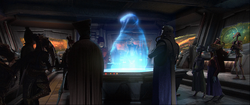
Sidious listening to Nute Gunray's last report.
Sidious endured Gunray making yet another report—the last, he hoped—about how the plan was proceeding. Sidious answered almost by rote, congratulating the Viceroy, and promising his new apprentice to 'take care of them', hiding the euphemism in his words. Sidious was pleased by the ambiguity in his words. Vader would not exactly be presenting them with cases filled with credits; he had a better reward in mind. Sidious had reached for the controls to end the transmission, but thought better of it and surreptitiously kept the channel to Mustafar open, to observe the carnage as it happened. Vader soon arrived. Equipped with the installation's deactivation codes by Sidious, his fighter landed without its automated defenses even noticing.[10][23]
From his desk, it excited Sidious to see the Council members turn to face Vader as he arrived, offering him a fawning welcome. Vader was outside the range of the hologram pickup, but the expressions of the Separatists, changing from surprise to bewilderment and finally to fear, were clearly visible. Then, Vader's blue blade flashed through the pickup field, and parts of Poggle the Lesser were sent aloft. He saw the rest of the Council rouse themselves and desperately try to run, screaming, until the transmission cut off from their end.[10][88]
There was a reason for his satisfaction; thirteen years before, Sidious had remarked to Darth Maul how happy a day it would be when he no longer needed the Neimoidians and their ilk.[29] One by one, Vader killed the Council members, until only Viceroy Nute Gunray was left alive. Pleading with the Sith Lord, Gunray tried to convince him that the war was over and all that they wanted was peace, but like all the others, the Viceroy was slain by Vader's blade.[10]
Sidious gave new instructions to Vader, telling him to deactivate the droid armies. Vader did as instructed, and a coded signal was sent out over every HoloNet repeater in the galaxy. When received, every battle droid simply turned itself off. The manufactured threat of the Confederacy of Independent Systems, having served its purpose, was deactivated, and the Clone Wars, the most destructive conflict in the last thousand years, had ended.[10]
The inauguration of the Galactic Empire
- "So this is how liberty dies—with thunderous applause."
- ―Padmé Amidala
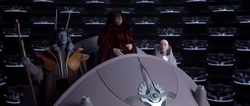
It remained only for Palpatine to win the Senate's support, so he called for a special session to inform them of the "Jedi rebellion." For the sake of his audience, he covered the damage to his face. He could have appeared in his usual black robes and hood, but for this triumphant day, something more eye-catching was needed. He chose a robe of burgundy material, with a matching velvet mantle and hood in the Sith style. As a coronation robe, it sufficed. He also donned it despite it containing several Sith symbols as he knew full well that none in the rotunda would ever recognize them.
The Senate saw his face twisted and distorted, his blue eyes, penetrating but friendly, replaced by harsh yellow ones, far more penetrating and anything but friendly. For the rest of his life that face would be seen, appropriately enough, only in shadow, shrouded by a hood, those piercing yellow eyes its most visible feature. The galaxy eventually reconciled itself to this new face; portraits and statues of him incorporated it without shame. As he intended, that countenance was seen as a mark of pride, a wound suffered in the service of the people.
The Senators were informed of the Jedi plan not just to kill him, but to overthrow the Senate as well. As evidence, they heard recordings from his private office, and the voice of the late Master Windu accusing the Chancellor, in whom the galaxy had placed its trust, of being a Sith. And while the emphasis was always on the "treacherous plot against the Republic," never did Palpatine deny the accusation. Instead, he blamed the Jedi Order for everything he had done for the past three decades: they had manipulated the galaxy. Through their "puppet" Senators (conveniently, all members of the opposition), they were blamed for fostering corruption in the government to undermine the Republic. Through Dooku, they were blamed for manufacturing the Separatist movement to push the Republic into war. Through Sifo-Dyas, they were blamed for commissioning the clone army. Between these two proxies and the armies they commanded, he insisted, the Jedi had presided over a sham war, all to weaken the Republic so that the Council could take power openly:
|
Palpatine: The Jedi, and some within our own Senate, had conspired to create the shadow of separatism using one of their own as the enemy's leader… The Jedi hoped to unleash their destructive power against the Republic by assassinating the head of government and usurping control of the clone army. But the aims of would-be tyrants were valiantly opposed by those without elitist, dangerous powers. Our loyal clone troopers contained the insurrection within the Jedi Temple and quelled uprisings on a thousand worlds… The remaining Jedi will be hunted down and defeated. Any collaborators will suffer the same fate.[90] |
Thus he played on the long-accumulating mistrust and resentment of the Jedi, much of which he had fostered, to confirm what for some had become a firm conviction: that the war was nothing more than a Jedi plot. In the face of anti-Jedi biases, it was easy for Palpatine to depict Order 66 as a just and necessary measure.
Those who knew the Jedi in a better and clearer light and could have defended them, including much of the Senate opposition, were in no position to argue; the mood in the hall was clearly against them. In any case, they could see armed shock troopers stationed throughout the chamber, allegedly for the Chancellor's "protection."
|
Palpatine: These have been trying times, but we have passed the test. The attempt on my life has left me scarred and deformed, but I assure you my resolve has never been stronger. The war is over. The Separatists have been defeated, and the Jedi rebellion has been foiled. We stand on the threshold of a new beginning.[90] |
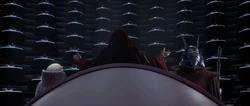
Palpatine becomes Emperor of the galaxy.
Here the opposition held its collective breath. It had been assumed that with the end of the war, and with the destruction of the alleged "hidden powers" behind the war, Palpatine would keep his promise to relinquish his emergency powers, step down from office and go into retirement on Naboo. But he had other plans, and when he announced them, the opposition was sent reeling:
|
Palpatine: In order to ensure our security and continuing stability, the Republic will be reorganized into the first Galactic Empire, for a safe and secure society, which I assure you will last for ten thousand years. An Empire that will continue to be ruled by this august body and a sovereign ruler chosen for life. An Empire ruled by the majority, ruled by a new constitution.[90] |
So he had confirmed their worst fears—there would be more changes to the Constitution, if that document was not to be scrapped entirely. It soon became frightfully clear that there would be more direction to the Senate, than ruling by the Senate. Many just did not care; they knew where the power lay, and their support would gain them influence later. Those who did care remembered that there were blasters in the room. Palpatine continued, skillfully evoking the glories of empires past for a galaxy tired of disorder:
|
Palpatine: By bringing the entire galaxy under one law, one language, and the enlightened guidance of one individual, the corruption that plagued the Republic in its later years will never take root. Regional governors will eliminate the bureaucracy that allowed the Separatist movement to grow unchecked. A strong and growing military will ensure the rule of law… Under the Empire's New Order, our most cherished beliefs will be safeguarded. We will defend our ideals by force of arms. We will give no ground to our enemies and will stand together against attacks from within or without. Let the enemies of the Empire take heed: Those who challenge Imperial resolve will be destroyed.[90] |
The next 25 years saw the violent suppression of all opposition, including intimidation, arrests, executions, the destruction of cities, even the destruction of entire planets. He would have gone further, and destroyed entire star systems, had his rule remained unchallenged. But the Rebel Alliance was years in the future. For the present, its future founders, Bail Organa and Mon Mothma, had no choice but to feign support for their new Emperor; they could do more good alive than dead. Seduced by promises of safety, security, justice and peace, or perhaps just intimidated into silence, the Senate unanimously voted "yes." The Galactic Empire was an established fact.[91]
The last stand of the Jedi Order
- "I have waited a long time for this moment, my little green friend. At last, the Jedi are no more."
"Not if anything to say about it, I have." - ―Palpatine and Yoda
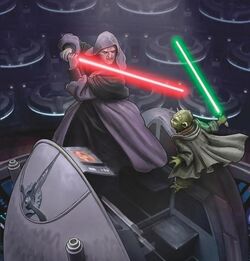
Obi-Wan Kenobi and Yoda eventually caught up with the betrayal and deceit, realizing that Anakin, now Vader, and his troops had slain everyone in the Jedi Temple, Masters, Knights, Padawans and younglings alike. Obi-Wan begged the old master not to send him to battle his former Padawan and friend, but there was no choice; Yoda knew the new Emperor would be far too powerful for Obi-Wan. Obi-Wan was sent to confront Anakin on Mustafar, while Yoda met with Sidious in the Senate Building on Coruscant. There, the Dark Lord of the Sith and the Grand Master of the Jedi Order dueled in a battle that destroyed a good portion of the Grand Convocation Chamber. Sidious also expressed his confidence that his apprentice, Darth Vader, "will become more powerful than either [Yoda or Sidious]", although Yoda retorts that his faith will eventually become misplaced like his faith in the dark side of the Force.[10]
The two combatants demonstrated amazing strength and skill in the Force, as well as lightsaber prowess. The battle ended in a draw after Palpatine's Force lightning was returned to him in a blast so powerful that it pushed the two masters apart. Sidious managed to grab onto a Senate pod, but Yoda fell several stories. Yoda had realized during the duel that he could not defeat Sidious, and decided that re-engaging him would only result in failure.[23] Outmatched, Yoda fled.[92] "Into exile, I must go. Failed, I have," he remarked to Bail Organa, who hurried him away in his speeder. Emperor Palpatine waited for a time while shock troopers searched for Yoda's body, but when they learned that Yoda was still alive, Sidious gave it little more thought. He commanded them to double the search, and gave them permission to blow up the Senate Building, but took no further action himself, as he sensed that Vader may have fallen into mortal danger and demanded that his shuttle be dispatched immediately. It was a mistake that would eventually destroy him.[10]
The transformation of Vader
- "Rise, Lord Vader."
- ―Palpatine
The battle between Kenobi and Vader had ended much differently. Kenobi had succeeded in grievously wounding his former apprentice, leaving him for dead. Hurrying to Mustafar with speed only the Emperor of the galaxy could afford (and with vigor that surprised even himself), Sidious found his apprentice badly burned but alive.[10]
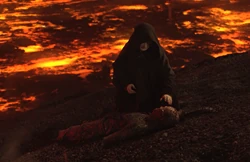
Sidious finds Vader's body scorched by lava after losing to Obi-Wan Kenobi on Mustafar.
Even as he made his way to the body, Sidious wrestled with anger and indecision. Part of him wanted to leave what was left of Vader to burn to ashes in the rising lava for his failure. As he walked however, he reasoned that, after having spent almost twenty years in preparation for turning Vader, to let him die would be a waste. So Sidious kept walking and, finally reaching his apprentice, placed a hand on Vader's forehead, using the dark side to keep him stable, while his shock troopers prepared a medical capsule for the return to Coruscant.[88]
- "Live, Lord Vader. Live, my apprentice. Live."
- ―Palpatine's thoughts upon saving Vader
In the shuttle's rear compartment, Vader lay in his capsule as if in state, flanked by Red Guards.[52] Sidious sat before him, using all his powers, every potion and device his medkit contained, to keep Vader stabilized, and wrestled with his own feelings. What if Anakin should die? he thought. Though he had nearly left Vader to die back on Mustafar, Sidious held, perhaps, the merest sliver of affection for him that he had never held for Maul or Tyranus. The reason for this may lie in Vader's one-of-a-kind potential. To find another being even half as powerful could take many years, and even then it would probably never happen. Sidious would have to really discover a way to bend the midi-chlorians to his will, to conceive a being as powerful as Skywalker had been, and that too promised to be impossible. It would be miracle enough if Vader was restored to life, which was far removed from actually returning someone from death.[24] Another potential reason for this may have been due to his role in creating Vader in the Grand Experiment years ago.[20]

Darth Sidious arrives at the Emperor Palpatine Surgical Reconstruction Center with a barely-living Darth Vader.
Back in the capital, at the Emperor Palpatine Surgical Reconstruction Center, Palpatine commanded that Vader be rebuilt using prosthetic replacements, a long and painful process that Palpatine made sure Vader would be kept conscious for, in order to make him stronger through pain. Upon being completely rebuilt and outfitted in a life-supporting suit of armor, Vader asked his master what had become of Padmé. How much of the story Palpatine knew is unknown, but he apparently believed Vader himself had killed his wife in his anger, which worked to his own advantage by breaking Anakin Skywalker's spirit once and for all; Anakin's transformation to Vader was now fully complete. Vader fell into a rage and destroyed the operating theater,[10] and even attempted to reach out and kill Sidious. However, he proved unable to do so; his injuries had reduced his power in the Force as they had his physical capabilities, and would need to be similarly rebuilt. His knee-jerk reaction having failed to destroy Palpatine, Vader quickly ceased his efforts, realizing that Palpatine was all he had left; the only one who would accept him. Palpatine was pleased: one of the most powerful Sith Lords of all time was born in pain and suffering, and it was his apprentice.[23]
Meanwhile, Yoda and Obi-Wan fled into exile. Anakin's offspring were also separated; Leia went with Bail Organa to Alderaan, while Luke would be taken by Obi-Wan to Anakin's stepbrother Owen Lars on Tatooine, their existence hidden from Palpatine.[10]
The Emperor's reign (19 BBY–4 ABY)
Imperialization
- "Once more, the Sith will rule the galaxy… And we shall have peace."
- ―Palpatine
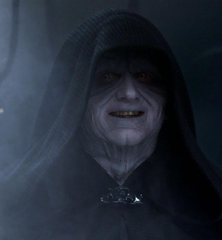
Palpatine grins as he witnesses his apprentice's anger.
With the rise of the Empire, all the institutions of the old Republic were either dismantled or changed beyond recognition through the process of Imperialization. There was a riot of renaming all things "Imperial" to glorify the new Emperor: overnight, the Coruscant sector was renamed the Imperial sector, Coruscant itself was renamed Imperial Center, and Galactic City was renamed Imperial City. The Galactic Senate became the Imperial Senate. The Republic's clone troopers had already been rechristened the Imperial stormtroopers and formed into the Stormtrooper Corps; now the remaining surface-based and space-based forces of the Grand Army of the Republic became the Imperial Army and the Imperial Navy, respectively. The four decrepit intelligence agencies of the Republic were merged into Imperial Intelligence, with former SBI director Armand Isard at its head. The old Palace of the Republic, or Presidential Palace, was rebuilt and expanded, becoming the Imperial Palace, eclipsing all other buildings on Imperial Center. The former Commission for the Protection of the Republic (COMPOR) was renamed the Commission for the Preservation of the New Order (COMPNOR).[90] Within days, there were few names left to remind the people that there had ever been a Republic. In the first months of Imperial rule, a series of spectacles designed to showcase the military might of the Empire and unify its citizens were arranged.[93]
Under the leadership of Palpatine's advisors, Crueya Vandron and Ishin-Il-Raz, COMPNOR gained a powerful hold over the Empire, and its organs insinuated themselves into every corner of society. The Imperial Security Bureau (ISB) was established as a branch of COMPNOR to act as a counterweight to Imperial Intelligence, and it became the Emperor's all-pervasive secret police organization. The Coalition for Progress established monitoring agencies to keep track of all aspects of life. The fleet would prove somewhat insubordinate, and a tension between the Coruscant government and the fleet admirals existed throughout this period, creating the need for the ISB to install political officers throughout the military as minders.
Palpatine's totalitarian regime was continually strengthening in its first years. Examples of its broad scope include an Imperially promoted aesthetic style of military-inspired simplicity, in contrast to the opulence and ornamentation Galactic Republic-era. Non-Humans and women were excluded from much of this New Order, and atrocities committed by powerful regional governors were common. Palpatine's first purge of the Imperial Navy occurred within just two weeks into the Empire's rule.[94] He had placed Admiral Mulleen to the task of carrying out the deaths of all officers suspected of holding anti-Imperial sentiments, and also promoted Gahg to Finance Minister and ordered for him to completely annex the holdings of defeated Separatist worlds for Imperial usage.
Great Jedi Purge actions
- "Of course he knew what we would do... What we must do... and he laughed. I have never seen such skill, such speed. He gave us hope, then took it away."
- ―Beyghor Sahdett
In addition to his actions of solidifying his power base, Palpatine also orchestrated the Great Jedi Purge, an extended campaign of trying to eliminating Jedi.
The Emperor kills three Jedi survivors.
At some point after the declaration of the Empire, Emperor Palpatine ordered five captured Jedi to be brought before him. Though exhausted after severe beatings and starvation, and surrounded by Red Guards and stormtroopers, the Jedi were not bound. Palpatine in fact handed each of them a lightsaber, and told them that the survivor would win their freedom. Instead of turning on each other, four of the Jedi attacked him; he cut three of them down simultaneously, leaving only a female Human and the Verpine Beyghor Sahdett. The latter chose to turn against the former in order to save his own life, and, in awe of Palpatine's unparalleled mastery of the Force, became the Emperor's servant. Sahdett was employed as a spy to entrap other Jedi survivors.[95]
In the first month of Imperial rule, Vader, against Palpatine's orders, went to attack a Conclave of Order 66 survivors. Still recovering and rebuilding his skill set, Vader only narrowly defeated the Jedi with the help of the 501st legion. Nonetheless, despite Sidious' disappointment in his apprentice for letting his emotions get the better of him, the Emperor nonetheless viewed Vader's actions as useful in the long run: he anonymously passed a rumor that Vader tracked down and destroyed the conclave. In order to ensure his false rumor kept fear running in the galaxy, he also greatly exaggerated the event, claiming the conclave was composed of fifty Jedi and that Vader had single-handedly killed them, when only eight were involved and Vader struggled with them alongside the 501st legion.[96]
Palpatine soon began his tests for Vader's gradual descent to becoming a true Sith. He enlisted historian Fane Peturri to secretly assist Vader in learning more of Sith history.[14]
Days after the Conclave, the Emperor also ordered for a brigade within the 501st Legion to be deployed to New Plympto to deal with an uprising on the planet. He also had earlier promised the Pho Ph'eahian senator Braxis with dealing with a local political dispute on the planet, but backed away from the promise by citing that the Imperial throne will not deal with local politics. In addition, he also was informed by Pestage and Amedda the results of the purge he had earlier assigned Mulleen to, and the report from Gahg on near complete status of the annexation a short period later.[97] After the fighting on New Plympto was concluded with the near extermination of the fighting force on the planet, Palpatine redirected the 501st Legion brigade led by Commander Vill to transport captured Nosaurian women and children to a slave market on Orvax IV, without Vader's consent.[98]
Per Sith tradition, Sidious was fully aware of Vader's desire for an apprentice to help him overthrow the current regime.[99] Although the Emperor was left unaware of Vader's failure at retrieving the Muur Talisman, he nonetheless arranged for Vader to be sent to Bandomeer to crush a rebellion on the mining planet. The Emperor, sometime after his making Vader his apprentice, secretly issued a contingency order to the stormtroopers, according to which, should he give the order, they would turn their blasters on Vader. About three months and three weeks of Imperial rule, during the Battle of Bandomeer, Lord Vader asked Commander Vill of the 501st whether such an order had been issued. Receiving no reply, Vader killed the Commander.[100]
The Emperor instructs Lord Vader to locate Falco Sang.
In the fourth month of Imperial rule, Darth Vader was preoccupied by his personal Jedi hunt, despite his Master's warnings to ignore the Jedi survivors. Having turned his attention on fugitive Jedi Master Dass Jennir, Vader visited Imperial Prison ISO-L8 with the goal of interrogating Janks, one of Jennir's fellow crewmen aboard the Uhumele. Before the Dark Lord could get to him, however, Janks was assassinated by Falco Sang, a bounty hunter also on Jennir's trail,[101] who was working for the family of Dezono Qua, a cannibal Jennir had killed on Esseles. The Emperor, though frustrated by Vader's monomania over Jedi survivors, tasked his apprentice with finding the assassin.[101] Darth Vader followed Sang to Prine, where he captured the bounty hunter for interrogation.[101]
As he had promised in his Declaration of a New Order, the Emperor intended to bring the entire galaxy under his rule, and in the first year of the Empire the military focused on the series of campaigns in the Mid and Outer Rims that came to be called the Reconquest of the Rim.[102] Palpatine was directly involved in one of these campaigns, the Atoan insurgency; deducing that Moff Wilhuff Tarkin needed motivation to become a more efficient officer, the Emperor ordered Darth Vader to go to Atoa in the Ghost Nebula and rescue the Moff's son, Admiral Garoche Tarkin. The Emperor later secretly ordered Vader to kill the younger Tarkin, since he already knew he had defected to the Atoans. After Vader killed the younger Tarkin and his wife Saro in an attempted suicide to atone for his sins as Vader, Palpatine dug him out, and also fed a falsehood to Wilhuff Tarkin that implicated the Atoans with his son's death, leading Tarkin to commit genocide against the Atoans as revenge.[103] He also approved Tarkin's Death Star project, and had personally overseen the beginning stages of the construction of the battlestation.[10]
Apart from his public role as Emperor, Darth Sidious also took time to conduct Sith business. Shortly after the declaration of the Empire, he initiated large-scale construction works in the Deep Core planet Byss to turn it into a secret throne world. To do this, he utilized thousands of alien workers from countless conquered worlds including Utapau, Gamorr, and Toydaria. Byss was a dark side conduit, able to invigorate practitioners of the dark side by flooding them with Force energy. Along with the power of Byss, Palpatine slowly fed on the life energy of his workers in order to lengthen his own life.[104][105] In addition, Sidious secretly intended to replace the Galactic Empire with his shadow government known as the Dark Empire, a magocracy that had Force-Sensitives, more specifically those aligned with the Dark Side of the Force, running the Empire, as well as doing so without any need of superweapons.
He and Darth Vader also brought a number of captured Agricultural Corps survivors and other Padawans to the planet in order to train them into powerful servants. Vader was ordered to select worthy pupils, and dispose of the rest. He initially selected four of the best pupils including an Agricultural Corps member named Tremayne.[104]
At some point between 19 BBY and 18 BBY, Sidious uncovered vital Sith documents in their original form, mainly from the Archives of the ruined Jedi Archives, and from them assembled a compendium of dark side knowledge he called the Book of Sith. In his preface, he recorded that he had hoped to accomplish an Empire with limitless scope. He would later lament in a footnote that he would still rely on others to do his bidding, especially when those who carried out his orders were "foolish, flawed, and disappointing."[14]
The Gentis coup
Although the scope of the Imperialization plans were pangalactic and their implementation exceptionally aggressive, many Imperial officers resented his warmongering ways and longed for peace after the years of fighting the Separatists. A few months after the Declaration of a New Order, the first graduating class of Imperial cadets arrived on Imperial Center from the Imperial Academies of Carida, Corulag, Raithal, Arkanis and Prefsbelt IV, and were presented to the Emperor by Headmaster Gentis. That same night, during the celebration gala, Gentis led many of his graduates in a coup against Palpatine.[93]

Palpatine infected with Aorth-6 after surviving the attempted coup
Hundreds of explosives placed by the cadets destroyed 72 Imperial targets, killing hundreds. Fighting broke out in the Imperial Plaza between the putschists and loyal Imperial forces, including Lord Vader. Gentis himself, under the pretext of presenting his "future Moffs," the most decorated graduates, penetrated into the throne room, released the Aorth-6 virus, and detonated the explosives inside the Palace. The only survivors were the Emperor himself, who was infected but kept himself alive with the Force, and Moff Trachta, whose prosthesis protected him from the poisoned air. When Vader arrived with Raithal class valedictorian Lieutenant Laurita Tohm, one of the few graduates who did not join the coup, Trachta and Palpatine proposed that the latter should hide until cured.[93]
Meanwhile, Gentis assumed control of Imperial Center awaiting Grand Moff Tarkin's arrival. After scouring the Jedi Archives for a cure, Vader, Trachta and Tohm set out to find the Prism, hoping that the ancient fortress contained a cure for the Emperor. Vader, Trachta, Tohm, and the Emperor eventually arrived at the fortress, and Palpatine's condition was stabilized, although he still needed time to regain his strength and recover. Vader and Tohm used the opportunity to recruit the inmates in the Prism for their counterattack against Gentis.[93]
Eventually making a recovery, Palpatine returned to Coruscant, and managed to exact revenge on Gentis for his coup by attacking him with Force Lightning at such an intensity that it rendered both him and his recently deceased son, Caul, charred corpses. Afterwards, Palpatine had the surviving members of the coup executed, and he later promoted Tohm to Admiral as a reward for his loyalty. Though Tohm was not Force sensitive, Palpatine also implied a desire for Tohm to take Vader's place as his second in command should the latter die. This, however, resulted in Vader killing Tohm.[93] As a direct result of the near-assassination attempt, Palpatine attempted to hasten the completion of the Imperial Palace.[106]
Palpatine also secretly supplied Vader with information relating to Jedi, including the location of Dass Jennir at Kestavel, via Lieutenant Gregg, while also telling him to keep their communication anonymous. The latter intel was later revealed to be a trap meant for the Sith apprentice. Sahdett also ended up discovered and killed as a result.[95]
The dark times
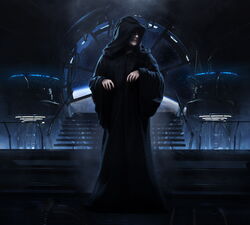
Emperor Palpatine aboard the under-construction Death Star.
- "Power! Unlimited power!"
- ―Palpatine
At some point during the Great Jedi Purge, Emperor Palpatine stole a Jedi Holocron from Jedi Master Ashka Boda, which also contained a prophecy that eventually led to his second death years later.
In 18 BBY, Palpatine invited former Jedi Ferus Olin to Coruscant,[107] to ask him a favor: find the saboteur of the computer system of the planet Samaria. Olin refused at first, but when Palpatine told him about the arrest of two of Olin's friends, he had to accept. As Olin later found out, Palpatine had been using the crisis as a way to gain complete control of the planet. Darth Vader also thought that the Emperor wanted Olin to turn to the dark side of the Force.[108] Palpatine would later taunt Olin with the same thing he had used to turn Anakin to the dark side: the ability to create and save lives, soon after Vader had killed Olin's friend.[109] Palpatine also promoted Olin in the Empire and provided him with a Sith holocron that would tempt him and urge him to use the dark side.[110][111][112]
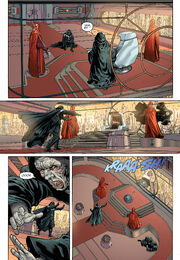
Darth Vader saves the Emperor from an assassination attempt in an unorthodox manner.
In 18.5 BBY, Palpatine suffered a second assassination attempt when his throne was rigged with a bomb underneath, an attempt only foiled by Vader Force-pushing the Emperor out of the way and then Force-pushing the throne out before the bomb detonated. This time, the ones responsible were the Heinsnake Cult, a cult of sorcerers who had been believed to have been long deceased. Palpatine, quickly realizing the threat posed by them to his rule, as well as to the Sith, dispatched Vader to locate the cult and wipe them out. In actuality, he had framed the Heinsnake Cult for the attack as a test for Vader.[113]
The same year, Palpatine, having learned of a enclave called the Children of the Jedi on the Plawal Rift of Belsavis, ordered for the construction of a dreadnaught superweapon with enough firepower to destroy the enclave. One of his specific requests for the dreadnought's development was to implement a hull that was virtually identical to a meteor, down to impact craters, as a form of camouflage. The Emperor publicly maintained that the hull choice was to deceive and/or baffle sensor scans from enemy vessels and worlds, although later historians speculated that the true reason for the camouflage was to ensure its development was kept secret from the Imperial Senate until he had consolidated enough power to not need the governmental body, due to his plans involving the knowing massacre of children. In order to further ensure its development and mission was kept a secret, he also had the dreadnought, christened Eye of Palpatine, pick up Stormtroopers stationed in various parts of the Outer and Mid Rim for the occasion. However, the Empire never got a chance to use the dreadnought as planned thanks to sabotage implemented by Jedi Knights Callista Ming and Geith Eris. Palpatine, upon discovering this, was infuriated and had the people responsible for losing the Eye imprisoned, with the Eye itself being forgotten for years.[114][115]
Sometime during the same year, as part of the ongoing Jedi Purge, the Emperor sent Vader to Kashyyyk to find and destroy Kento Marek, a Jedi survivor of Order 66. Vader's mission, however, became complicated by his unexpected discovery of the Jedi fugitive's son, Galen Marek. Vader was taken aback by the child's exceptional potential in the Force—a potential that rivaled the Emperor's power. After a moment of hesitation, Vader killed Kento and took Galen into his care, deciding not to waste the boy's potential by killing him. Hence, Vader began raising Galen as his secret apprentice in violation of what was technically the Rule of Two.[116] His brutal training regimen caused the boy to suppress the memories of his childhood until he had completely forgotten his Jedi past and heritage, including his birth name. Known only by the codename Starkiller, the apprentice was promised by his master that they would eventually combine their strengths to kill Emperor Palpatine in order to take control of the Galactic Empire.[117]
Also during the same year, Palpatine had ordered for the devastation of Caamas. The Emperor saw the respected Caamasi as a threat to his New Order. A group of Bothan infiltrators were responsible for sabotaging Caamas's shield generators, leaving the planet vulnerable to Imperial orbital bombardment. The once beautiful world was devastated during this attack, turned into a poisoned wasteland. The peaceful Caamasi were dispersed throughout the galaxy.[118]
In 17 BBY, after the Empire discovered a Separatist Holdout on the Outer Rim planet of Ostar, Palpatine had Imperial forces led by Vader dispatched to take control of the planet and drive out the Separatists. The resulting military operation, the Shrouded Offensive, turned out to be, at the time, one of the Empire's worst military disasters. After Palpatine learned of the operation's disastrous end, he, alongside Tarkin, Imperial Intelligence director Armand Isard, and Imperial Advisor Janus Greejatus, had Vader and the clone stormtrooper Hock Malsuum brought to his throne room and questioned about the failure.[119]
At some point during his rule, he had a mercenary, Qaga Lok, brought before him instead of executed for murdering several Imperial officers. He then challenged Lok to a duel: If Lok could defeat him, he's free to kill him, but if Lok himself was overpowered by the Emperor, Lok will have to swear fealty to him. Lok then accepted the terms, but Sidious then proceeded to effortlessly overpower him via the Force, tormenting the mercenary despite the latter's pleas that he will honor the code, until the man begged for mercy. He then had Lok trained extensively in the Dark Side, even having Lok choose a Sith name, of which Sedriss was ultimately chosen.[120]
On a number of occasions, Emperor Palpatine visited the ancient Sith graveyard world Korriban for advice from long dead Sith Lords. He also unlocked secrets of the Force from a captured Jedi holocron. His knowledge of the dark side was recorded in his monumental and unfinished Dark Side Compendium, a study of the nature of the dark side; he finished two books while in power, and began a third which was never completed.
The Secret Apprentice
- "You have forgotten your place, Lord Vader. By taking this boy as your apprentice, you have betrayed me. Now you will kill him, or I will destroy you both."
- ―Palpatine ordering Vader to "kill" Starkiller.
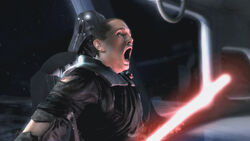
Darth Vader betrays Starkiller to prove his loyalty to Emperor Palpatine.
In time, the Emperor became aware of Vader's training of a secret apprentice: an exceptionally powerful Force-sensitive individual named Galen Marek, who, for much of his existence, was known by the code name "Starkiller", and whom Vader had recovered during a Wookiee rebellion on Kashyyyk after slaying his father, the reclusive Jedi Master Kento Marek, in 18 BBY. While initially angry at Vader for this, he used it to his advantage - in both uncovering the treacherous members of the Imperial Senate rumored to be trying to start rebellion against the Empire and as an opportunity to finally dispose of Vader. Ever since the setback on Mustafar, Palpatine was disappointed to see his apprentice wither away into a broken shell of the man he once was. Palpatine had spent years engineering Anakin Skywalker's fall to the dark side, only to see his life's work all but destroyed because of Vader's carelessness. But with Starkiller now in his plans, he sent his spies to follow him on his missions for Vader. With the reports he received, he was thrilled with the prospect of taking the young Sith hopeful as his own apprentice.
In 3 BBY, as Starkiller's training was on the verge of completion, Darth Vader dispatched his young apprentice on a final series of tests to determine the level of his strength before they could confront the Emperor. Starkiller pursued his objectives with great anticipation at the thought of fulfilling his primary purpose in life, from defeating Jedi fugitives to training in the ruins of the Jedi Temple. Due to the secret nature of his existence, Vader commanded Starkiller to execute anyone who saw him, with the exception of the holodroid PROXY and Captain Juno Eclipse, so as to not alert Palpatine of their plans to assassinate him. As such, his targets included Imperials who had the unfortunate accident of crossing his path.[116]
After completing his final mission by killing Shaak Ti of the former Jedi Council on Felucia, Starkiller returned to his master's flagship, the Executor where he believed they would assassinate the Emperor together. Unknown to Starkiller, however, Palpatine's spies had been tracking him since his victory over the exiled Aleena Jedi Master, Kazdan Paratus, on Raxus Prime. When Starkiller arrived on the incomplete Executor, the Emperor utilized a holodroid to project an image of himself to reprimand Vader, just in case Vader decided to go through with his plan. With the element of surprise lost to them, Vader was forced to "betray" his apprentice after the Emperor threatened to destroy them both unless Vader complied. As Starkiller stared at his master in shock, the Emperor angrily commanded Vader to kill the secret apprentice. Though he hesitated for a brief moment, Vader used the Force to assault Starkiller before launching him out of the bridge's observation window. Palpatine, likewise, expressed sadistic amusement at Vader's assault, even laughing to himself in private after the deed was done.[116]
When Starkiller awoke on the Empirical six months later, he learned that he had never truly died; Darth Vader staged the apprentice's execution and then nursed him back to full health aboard his secret medical starship. Vader convinced Starkiller that it was not too late to take revenge on the Emperor. But since Palpatine's spies tracked Vader's every move, a distraction was required to divert his attention elsewhere. Thus, Starkiller was ordered to organize an alliance of rebels and dissidents. With Palpatine distracted by a full-scale rebellion, Vader assured Starkiller that they would capitalize on their second chance to kill Palpatine as soon as the rebels served their purpose.[116]
But Starkiller was deceived once more. Emperor Palpatine was fully aware of the apprentice's survival and even ordered Vader to continue the charade by manipulating the young man into believing that the Rebel Alliance was part of their assassination plot. In truth, however, the real goal was to gather all of the Empire's enemies to one location where they could be rounded up and summarily executed in one swift stroke. When Starkiller completed his task to perfection, the Emperor dispatched Darth Vader and a large Imperial force to capture the Rebel leaders on Corellia.[116]
Thanks to Starkiller's efforts, the Emperor's greatest political enemies, Senators Bail Organa, Mon Mothma and Garm Bel Iblis were brought to the incomplete Death Star by Vader. Palpatine took satisfaction in describing how they would all be interrogated, tortured and executed as traitors to the Empire. Before he could carry out his threats, Vader's former apprentice revealed that not only had he survived his master's second betrayal on Corellia, but that he had also infiltrated the battlestation with the intention of rescuing the Rebel leaders.[116] After rediscovering his birth name and certain memories of his past, Galen Marek dropped his codename and abandoned his Sith identity in favor of the Jedi and the Rebellion.[117]
Emperor Palpatine ordered Darth Vader to eliminate Marek once and for all, but much to his surprise, the former apprentice emerged victorious in a duel that left Vader in a severely damaged state. However, Palpatine was actually delighted to witness Vader's defeat. Enthralled by Starkiller's power, Palpatine's goal to replace Vader with Starkiller was now within his reach. Thus, the Emperor seized the chance to rid himself of his hobbled disciple's dead weight by joyfully encouraging Marek to slay the cyborg Sith, hoping that the young man's hatred for his traitorous Master was strong enough to make the killing blow. He promised Marek that the reward would be great; Vader's death would allow the young man to finally become a true apprentice at the Emperor's side.[116]
Galen Marek confronts Emperor Palpatine on the incomplete Death Star.
But when the Jedi Rahm Kota, who had also been taken prisoner along with the senators, sensed Palpatine's intentions, he used the Force to snatch the Emperor's lightsaber. He then charged at Palpatine with the goal of striking the Dark Lord down with his own weapon. In a rage, Palpatine unleashed a barrage of Force lightning on the Jedi General. Caught off-guard for a few moments, Marek could only stand and watch as Kota was tortured by Palpatine's deadly lightning, unresponsive to Senator Organa desperately pleading that he help him. Marek was torn between aiding his Jedi mentor and taking his revenge on Vader. In the end, he drove away the dark thoughts of vengeance and chose the path of a Jedi by coming to the defense of his allies by standing against the Emperor.[116]
Through the Force, Marek hurled bits of broken transparisteel and debris at the Emperor, who was forced to break off his attack on Kota to defend himself. As they engaged in a vicious telekinetic battle, Marek came to the conclusion that Palpatine was behind Vader's every move ever since his discovery on Kashyyyk. Palpatine confirmed this, telling Marek that Vader never plotted alone.[121] As their battle progressed, Marek gained the upper hand by using the Force to pummel the Emperor around the throne room before apparently subduing him. Cackling, Palpatine abruptly dropped to his knees and goaded Marek into striking a death blow. With Kota's urging, however, Marek resisted the seduction back to the Sith way and spared the Emperor's life.[116]
Palpatine's failure to secure Marek as his new apprentice caused him to lose all control of his anger. As Marek turned to leave, Palpatine rose to his feet in an uncontrollable rage and unleashed his Force lightning on Kota once again, declaring that he would never allow the Jedi to have someone as powerful as Galen Marek. But the reformed Jedi used his own body to block the Emperor's attack to provide Kota and the Rebel leaders with enough time to escape. While his allies made their way to the Rogue Shadow piloted by Eclipse, the full strength of the Emperor's power pushed Marek to the brink of desperation. In comparison to his years of suffering under Vader's tutelage, nothing that Vader ever did to Marek was as excruciating as the pain that he felt from Palpatine's lightning. Before succumbing to oblivion, Marek compared the pain to an imploding star within his chest. Despite his desire to live, Marek knew that there was no escape or hope for survival. As such, he used all of his energy to create a massive Force explosion that all but destroyed the throne room, as well as nearly killing both Sith Lords.[117] Marek's sacrifice had cost him his own life, but had also turned him into a martyr. His actions also enabled the Rebel leaders to escape from the Death Star, thus ensuring the survival of the fledgling Rebel Alliance. As Vader regained his senses and limped towards the fallen corpse of Galen Marek, the Emperor also recovered and inspected the dead apprentice with a look of shock and disappointment on his face.[116]
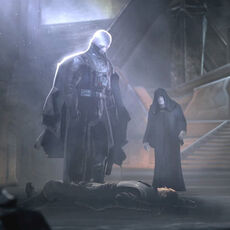
Emperor Palpatine and Darth Vader both confirm the death of Galen Marek shortly after the escape of the Rebel leaders.
Palpatine took no joy in the death of Galen Marek. He had envisioned a far different future for the boy, as he once had with Anakin Skywalker. Marek was meant to root out the rebels so that they could all be revealed and destroyed, yet Palpatine bitterly admitted that Marek's sacrifice would only inspire them to fight a full-scale war against the Galactic Empire. On a more personal note, the Emperor lost what was supposed to be Vader's successor; a new apprentice who was worthy to stand at the Emperor's side. The loss of someone of Marek's caliber was a major setback in his plans. But the fact that he still had to make due with an imperfect apprentice like Vader was also frustrating to Palpatine. Overall, the death of Galen Marek and the survival of the Rebel leaders bought Palpatine to a wise conclusion; all of the rebels had to be exterminated or the two Sith Lords would suffer the bitter irony of being destroyed by the very rebellion that they created.[116]
The Emperor, left with no alternative at the moment after Marek's death, was forced to keep Darth Vader as his slave for the time being. The loss of Marek did not stop him from seeking out other candidates as he fully intended to cast Vader aside one day, just as he had done so with Darth Tyranus years ago. The incident with Galen Marek also served to drive Palpatine and Vader even further apart than they already were. Like Tyranus before him, Vader had been betrayed by his master in favor of an apprentice far younger and more powerful.[116] With the Emperor's treacherous intentions finally revealed, Vader truly committed himself to overthrowing his master before it was too late. But to do so, he needed someone of Marek's potential to aid him in such a daunting task.[122]
Marek's untimely death, however, forced Vader to take a desperate course of action. He preserved his fallen apprentice's corpse on Kamino where he used it as a template in the hopes of creating a more powerful and obedient version of Marek. The cloning project was initially flawed, resulting in various genetic failures in the early trials of the experiment, including a renegade clone who escaped from the Kaminoan homeworld.[122] Despite the constant rate of failures and disappointments, the project ultimately produced a single perfect clone who emerged as Darth Vader's new apprentice.[123]
Dark Side Adepts and Trachta's insurrection
At some point during his reign, Palpatine communicated with the Shreeftut of the distant Ssi-ruuvi Imperium through the use of the dark side. He appeared in the Shreeftut's dreams and claimed that he was the ruler of an Empire in the Galactic Core. Palpatine traded with the Shreeftut for some battle drones in exchange that a large number of "subjects" be present for entechment by the Imperium. This would result in the Ssi-ruuvi invasion of Bakura in 4 ABY.
Emperor Palpatine also employed a large number of Force-sensitive agents. These people, the Dark Side Adepts, were outside the Empire's official organization, but reported directly to Emperor Palpatine or—when necessary—Lord Vader. Palpatine intended to replace key officials with the Adepts, though their number was too limited.
In 1 BBY, Palpatine and Vader were the targets of a group of treacherous Imperial officers led by Grand Moff Trachta. Trachta saw the Sith as foolish and archaic, and believed that the Empire should not be ruled by a two-man cult. They planned to use a batch of altered stormtroopers loyal only to them to destroy the two Sith Lords. Palpatine at that time was to depart to oversee the finalizations of the then-nearly finished Death Star, with his own shuttle being prepped for launch. Skosef, alongside a contingent of Trachta clone stormtroopers, snuck a bomb aboard the shuttle. Palpatine, however, discovered the threat via the Force and ordered for the procession to his shuttle to halt, moments before detonation. Although he himself survived, several stormtroopers as well as half of his own royal guardsmen were killed in the blast, which Trachta had intended, offering his stormtrooper squad to replace the ones lost, knowing full well that they were programmed to kill Palpatine when the opportunity presented itself. However, their plot failed in part because of internal fighting between the co-conspirators. The sole remaining conspirator, Moff Kadir, then brashly led his contingent of clones to attack Palpatine, also killing several of the Imperial officers in the process. However, Palpatine had anticipated their arrival and attack, and had his guardsmen attack the guards before he personally disposed of the surviving men with Force lighting. He then let Kadir long enough to witness the full failure of the attempted coup, after denying him the chance to become his apprentice due to his lack of Force-sensitivity as well as Vader surviving the coup, before electrocuting him to death.[15]
Moff Kalast's defection and the subjection of Bothawui
Palpatine kills treacherous Bothans.
In 0 BBY, Moff Kalast aided the Rebel Alliance in secret by supplying secret information about the recently-completed Death Star. After the identity of the traitor was discovered, the Emperor dispatched Darth Vader to hunt down Kalast's flagship, the Star Destroyer Avenger. Vader's forces clashed with Kalast's on Thyferra and Atzerri, until eventually defeating him and capturing the Avenger as it was preparing to jump to lightspeed. Kalast was interrogated, revealing that Bothan members of the Spynet had supplied him with the top secret information concerning the Death Star. The Emperor considered this treason on the part of the entire Bothan species, and decided to deal with the situation himself. He traveled to Bothawui in his personal shuttle, accompanied by two of his Royal Guards, and slaughtered hundreds of Bothans. He gathered information that Tantive IV was headed to Tatooine, and informed Lord Vader, who had already learned the same thing in a separate mission.[124]
The New Order in practice (0 BBY)
- "We were establishing a new era: an era of order and peace."
- ―Entry from the Journal of the 501st.
The dissolution of the Senate
- "The Imperial Senate will no longer be of any concern to us. I have just received word that the Emperor has dissolved the council permanently. The last remnants of the Old Republic have been swept away. "
"That's impossible! How will the Emperor maintain control without the bureaucracy?"
"The regional governors now have direct control over their territories. Fear will keep the local systems in line. Fear of this battle station." - ―Grand Moff Wilhuff Tarkin and General Cassio Tagge discussing the dissolution of the Senate.
From the beginning, Palpatine sought to remove the Senate. The first reason was symbolic: he could not leave a reminder of the Republic lying about. The second was political: some Senators still opposed him. His obedient majority tried keeping them in check; they understood they were only there to prop up the illusion of democracy. He dealt with the outspoken ones when they appeared, but others sprouted in their place. Worse, some of them, he suspected, were providing the Rebels with funds, information, and resources.[125]
Sidious and Vader
He had waited until the time was right, all the while sapping their power. Finally, in the third month of the year 35 after the Great ReSynchronization,[105] with the governmental infrastructure in place (the governors, Moffs, and Grand Moffs), with the military, as always, obeying him without question, and with the Death Star, the Tarkin Doctrine's ultimate tool, finally complete and tested, he was ready.
Warrants were issued for the arrest of all suspected Rebels. Stormtroopers burst into the Senate, and hundreds were detained. Some—those learned to have had Rebel affiliations—were never seen again.[126] The following morning, the remaining Senators, unaware of what had happened, came to work only to find themselves locked out of their offices and chambers. Some tried to appeal to Palpatine directly, but were told that their diplomatic access to the Palace had been suspended "for the duration of the emergency."[127]
Many of them had been present when the Senate gave power to him. They too were arrested and interrogated. Many who were released left Coruscant for their homeworlds, and a peaceful—and isolated—retirement. The small number of Senators that remained, the ones who had most voraciously upheld the party line, were generously rewarded with their lives and new positions. Many of them donned ornate jeweled robes and joined the swelling ranks of Imperial advisors.
Palpatine had killed what was left of the Constitution. A new pyramidal structure was imposed, with himself at its summit, then the Grand Moffs who ruled Oversectors, then the Moffs who ruled sectors, then the governors of individual worlds. All of them owed their careers to the Emperor and gave him their allegiance. But even here, he had extra guarantees. He had long since inserted COMPNOR into every level of the bureaucracy, to insure that each one followed his dictates. For all the power of the Moffs and Grand Moffs, COMPNOR stood behind them, more powerful still.[33] And behind them all stood the Death Star, enforcing his will at gunpoint.
An example is made
Palpatine was equally thorough in dealing with Senators who were off Coruscant at the time, or had escaped. One was Senator Canna Omonda, Mon Mothma's successor as representative from Chandrila. Many Senators had hoped Omonda would intercede for them. But Omonda, seeing no point, did not try to gain an audience, instead becoming one of the few Senators, perhaps the only one, to leave Coruscant before the noose tightened. But she made a parting shot in her remarks to the press as she boarded a transport bound for Chandrila:
Omonda left the capital; just in time, as her colleagues were arrested. But Palpatine could not let her remain at large; he dispatched an "honor escort" of three Imperial Star Destroyers to Chandrila, to bring her back to Coruscant for a "short interview" with High Inquisitor Halmere. The Chandrilans took the hint that the "escort" would devastate Chandrila if they refused to release her; Omonda was turned over to the Inquisitorius. Omonda soon confessed to acts of treason, giving her interrogators the names of people she had passed classified information to. The night of the confession, in his before-dinner remarks at the Palace, Palpatine again donned his well-worn mask of firm benevolence for the sake of the press.
Omonda's public execution was scheduled as part of the traditional New Year Fete Week celebrations (1 ABY), but this was canceled in light of "security concerns." No specific reason was given, but the government likely feared that Rebels or their sympathizers might disrupt the event. Even without the executions, the awesome power of the New Order was displayed to full effect. The traditional parade passed before the Palatial Balcony, where Palpatine occasionally appeared, flanked by Vader and numerous lieutenants. Since Palpatine was not on the balcony throughout the entire parade, it is possible that he went to visit her before her death—or to watch her die.[128] Palpatine was also heard remarking that if sending up two traitors in a row was how Chandrila rewarded him for his favor, it might benefit from more direct supervision.[129] Chandrila duly received its direct supervision, and its legal government soon vanished. In its place, Grandon Holleck was installed as governor.[130]
At some point, with the growing rebellion, Palpatine had one of his ranking advisor, Ars Dangor, issue two versions of a speech regarding dealing with the Rebel Alliance: One, where the Rebel Alliance was treated as if they were the latest incarnation of the Separatists from the Clone Wars, was released to the general public of the Empire. The other, intended to be issued specifically to the various moffs and governors, making clear that they should adopt a policy of terror.[33] The latter speech ended up leaked by Rebel sympathizers.[129]
Death Star rising

Emperor Palpatine at the time of Trachta's coup.
- "These people have lost a homeworld through no fault of their own. Offering them a new homeworld is the least I can do to compensate them for their loss."
- ―Palpatine
The exemplar and symbol of the New Order was no longer to be the stormtrooper, or the fleet, or even, to an extent, Palpatine himself. It was to be an armored space station he and his lieutenants had spent some two decades in the building, enduring a seeming eternity of research and development, accident, sabotage, great leaps forward and disappointing steps backward. He did not know, or did not care, that in the end, it would make the Rebellion even more emboldened than before.
The destruction of Alderaan
In the absence of the Senate, Palpatine had established an environment where even his subordinates were capable of terrible atrocities against sentients. From the very beginning of its design, it was intended that the Death Star be capable of destroying entire planets. But most Imperial strategists were certain that the threat alone would be enough to keep most worlds in line. Tarkin felt differently; as he saw it, the Rebels were growing bolder, and only a very public demonstration of the battlestation's power against a Rebel target would succeed in giving them pause. His argument convinced Palpatine.
So Palpatine approved in advance the destruction of a planet—and thereby the mass murder of its entire population. He knew it would be used on an inhabited world. But he did not know in advance that it was to be Alderaan. Tarkin alone made this decision, facing down even Vader to do so. If Palpatine knew about Tarkin's intent from that point onward, it would only be because Vader made a report to him after the decision was made, but before the station entered the Alderaan system and carried out its mission, an act that, by current estimates, caused the deaths of 1,999,940,000 sentient beings.[45]
Palpatine's private feelings on the tragedy were a mystery, but publicly he adopted his benevolent persona, announcing that he was saddened by the loss of such a noble world, and adding that had Alderaan entrusted itself to Imperial protection, it would still be thriving. In other words, the destruction of Alderaan might not have been necessary had Bail Organa simply bowed under as he was supposed to. But he made a "magnanimous" offer to resettle the sixty thousand remaining Alderaanians, those who were away when their homeworld was destroyed, on his "private resort world."
It was later announced by Palpatine's proxies that he himself had ordered the destruction of Alderaan after the Empire had obtained "irrefutable evidence" that this planet of pacifists, which had not even possessed a standing armed force, had supposedly been creating bioweapons. The possibility that some of these bioweapons had been taken off-world to Rebel cells was dangled in front of the compliant press, to keep the terrified Core Worlds in line and justify a permanent state of emergency. As a result, the Empire put more time and resources than ever before into crushing the Rebellion, flushing out Rebel strongholds throughout the galaxy and conquering worlds that had allied themselves with the Alliance.
Tarkin, with his Doctrine, had promulgated a fear-driven principle of governance. But shortly after the destruction of Alderaan, the Death Star itself was destroyed by the Rebel Alliance in the Battle of Yavin. Palpatine ordered the creation of a second Death Star at Endor, ironically shortly before Luke Skywalker had destroyed the first Death Star.[102] Grand Moff Tarkin, who was aboard the battle station at the time and refused to evacuate, was killed in the station's destruction.[26] But while this was a great loss for the Empire, Palpatine nonetheless found ways to turn the situation to his advantage. Even so, he punished Darth Vader for this failure by severing his already-mechanical right hand. Likewise, Palpatine later had Coh Veshiv relocated in anger after the latter had inadvertently uncovered information relating to illegally diverted funds by one of the Grand Admirals for a secret starfighter project that was ordered by Palpatine himself. Afterwards, Palpatine later ordered Grand Admiral Osvald Teshik to rescue Coh Veshiv from Esseles with the threat of death should he fail. Teshik failed to rescue Veshiv or kill the one responsible, Captain Dhas Fenoep Vedij, and thus Palpatine made good of his threat by arranging him to be sent to Andalia on a suicide battle to fight the Hapes Consortium fleet with insufficient materiel or manpower as a demonstration of how even the Grand Admirals are not beyond reproach, also sending a snoopship to survey the battle. After Teshik was revealed to have survived the battle, Palpatine then had 3/4ths of Teshik's body replaced with cybernetics, and then had him resume command. He also suspected that Vader was searching for the force-sensitive pilot in order to betray him. The Emperor deduced the name of the pilot and dropped a hint to Vader about the pilot's identity to indicate his knowledge of his apprentice's intentions.[131] In various points of the war, Palpatine was briefed by Darth Vader on the progress of their fights against the Rebellion. In particular, Palpatine expressed some disappointment at the setback to the Blockade of Yavin, although Vader assured him that it was only temporary. Shortly thereafter, Palpatine also ordered for an attack on Ralltiir after it became apparent that the scientists on the planet were creating weapons for the rebellion. In spite of one of his Imperial officers, Tycho Celchu's defection to the Rebel Alliance, and thus potentially supplied them with valuable information, Palpatine was not concerned about this, as he was fully confident that Ralltiir being fully blockaded by the Imperial Navy would be more than enough to prevent the Rebel Alliance from saving the scientists.[132]
Others would have to answer for their incompetence, most notably the Death Star's principal engineer, Bevel Lemelisk. Upon hearing of the Yavin fiasco, Lemelisk, correctly fearing for his life, went into hiding. It did not take long for Imperial Intelligence to track the engineer to his remote retreat on Hefi, and "summon" him to an audience with his Emperor.[133] When he entered Palpatine's audience chamber, he made the tragic mistake of trying to bluff his way through, believing that Palpatine did not know what had really happened. The Emperor set him straight at once. Palpatine used the Force to trap Lemelisk within a wire-mesh cage, and then released into the cage a swarm of winged insects, piranha beetles he had long ago "rescued" from Yavin 4. Palpatine was greatly amused as the insects made shreds of his engineer. But he still needed Lemelisk, so he used the Jedi Holocron taken from the late Ashka Boda, transferring Lemelisk's unwitting essence to a clone body. The exercise properly expressed his disappointment to Lemelisk, but it made for a trial run of the process he himself might yet have to endure, should his own body at last fail him.[134]
Inevitably, as Lemelisk sought to rectify the failures of the Death Star's design, Palpatine did have to conceive even more excruciating deaths for every subsequent failure, seven executions in all, ranging from the horrid to the whimsical, each time reviving him and letting the lesson of his latest execution press him onward. The engineer was launched out an airlock, his organs destroyed by the pressure and cold. He was locked in a vault filled with thickening acid mist that ate into him with even bloodier vigor than the piranha beetles had. He was once slowly lowered into a vat of molten copper which burned his body away a centimeter at a time. When, a month later, Lemelisk felt bold enough to ask why copper, Palpatine simply told him that that was what the smelter had used that day. These were not mere acts of sadism; they had an underlying purpose, employing pain to encourage progress.[134]
He also had Lyn locate and train Force-sensitive students in the art of Teräs Käsi, in order to hunt down and kill the Heroes of Yavin as retaliation for their destruction of the Death Star.[135] However, he eventually learned from Jade that Lyn had an ulterior motive of trying to instigate a coup, although he wasn't able to punish her for her treachery due to her and her three students going into hiding.[136]
After discovering that Vader had gained a second secret apprentice, Tao, Palpatine managed to abduct the boy just as Vader released the boy from his apprenticeship, and forced Vader to mortally wound the boy. This act caused Vader a great amount of grief.
Plotting against Luke Skywalker (3–4 ABY)
- "We have a new enemy. The young Rebel who destroyed the Death Star. I have no doubt this boy is the offspring of Anakin Skywalker."
- ―Palpatine
Despite his unintended role in creating the Rebellion five years earlier, and telling Vader to be ruthless in his attempts to crush the rebellion and kill them all, Palpatine was unconcerned about the Rebellion. For the present, it was useful, to accustom his subjects to a state of permanent martial law. He could accept some interference from the Rebels if it helped him in the long run. Without the Force on their side, they could never truly hurt him. Palpatine also believed that the Rebels were not fully aware of the scope of his plans to ultimately defeat them, due to the Rebel defector, Sarkli's resourcefulness, especially in regards to the latter successfully retrieving scientists that the Rebels were attempting to rescue at Bakura.[132]
- "The Force is strong with him. The son of Skywalker must not become a Jedi."
"If he could be turned, he would become a powerful ally." - ―Emperor Palpatine and Darth Vader
Following a major victory in capturing a Rebel base on Hoth (3 ABY), Palpatine demanded to the de jure head of Death Squadron, Admiral Firmus Piett, to tell Vader to make contact with him. After getting out of Hoth's asteroid field, Palpatine, after delaying his communicating with Vader due to a foul mood, then told Vader that his son, Luke Skywalker, was becoming a grave threat to the Sith due to his growing Force potential and training, and that he must not become a Jedi, also informing him that he is Vader's son. Vader convinced Palpatine that it would be beneficial for both of them if Luke was converted to the dark side.[137] In actuality, Vader already knew by that point that Skywalker was Force-sensitive as well as alive, and had been actively searching for him, secretly planning to use Luke to help him overthrow his master.
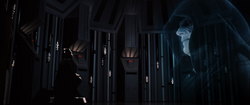
Vader and Palpatine discuss the threat of Skywalker.
Shortly after the duel at Bespin, Palpatine chastised Vader's failure to convert Luke to the dark side, and also implied suspicions of Vader not even wanting to turn Luke, although Vader replied that he did nonetheless manage to sow the seeds of ambition into him, and reminded him that turning Luke to the dark side was Vader's idea. The Emperor also sent Vader over to escort supplies shipped by Prince Xizor's merchant fleet to the second Death Star. In actuality, the escort mission was a miser's bargain to distract him while he arranged for Prince Xizor to assassinate Luke Skywalker. However, this plan failed when Xizor and his Skyhook were destroyed by Darth Vader.[138] In addition, he also had Vader supply him with Luke's severed hand and lightsaber for one of his storehouses at Wayland.
Sometime afterwards, around the same time Vader and then-Vice Admiral Thrawn tracked down and destroyed a Rebel stronghold near a planet in the Outer Rim, Palpatine ordered for virtually all of the Imperial Naval forces (and presumably the other Imperial Military branches) to head to the Imperial Center for his announcement on the progress of the war. From his Audience Chamber at the Imperial Palace, he announced that the war was nearly over with the Galactic Empire soon to experience final victory over the Rebel forces, citing Vader's attacks on Rebel strongholds as testament to this.[139]
Around the same time, Palpatine dispatched his Hand, Mara Jade, to Tatooine, certain that, at some point, Skywalker would go there to rescue his friend, Han Solo. When he did, she was ordered to kill him. At the same time, he ordered Vader to Endor, to oversee the construction of the new Death Star. His apprentice would be useful in speeding up the workers, but it also put him well out of the way. By the time he joined Vader at Endor, he would have heard the comforting mind-touch of Jade, assuring him that Skywalker was dead. Let Vader suspect all he wanted; even if he did learn the truth, it would only encourage him to remember where his loyalties lay.
But when Jade's mind-touch was heard, he was distressed to learn that she had failed him, a rare event indeed. Skywalker had eluded her by sheer chance, and by Jabba's personal strength of will. The Hutt had refused to let her on the barge that was to take Skywalker to his death, and so she could not be there to make sure he died. And there was little hope that Jabba's thugs could accomplish it themselves.[140] Killing Skywalker was not an option now; converting him to the dark side was the last hope Palpatine had. It could be done; Skywalker had learned of his father's true identity, and would risk it all to try to steal him back from Palpatine's grasp. The Emperor counted on this to lure the boy into his trap. First, he would destroy Skywalker's friends and loved ones. Then, he would force him to kill his father, the man he loved as much as he hated.[133] Like his father before him, it would be slow, and perhaps harder this time around. But at the end, Skywalker would accept the dark side of the Force.
With the approval of Emperor Palpatine, the scientist Doctor Raygar went to Endor aboard a ship commanded by Admiral Kazz to seize the powerful artifact called the "Sunstar" from the native Ewoks. His mission was successful; meanwhile, Palpatine traveled to the system to retrieve the Sunstar. But when Raygar analyzed the gem and recognized the power it held, he decided to use it to kill Palpatine upon arrival and make himself the new Emperor. Raygar constructed a powerful weapon to use against Palpatine's shuttle, but as he prepared to test the weapon, Raygar was attacked by the Ewok Wicket Wystri Warrick who had infiltrated the ship. As Palpatine's shuttle approached, the scuffle between Warrick and Raygar resulted in the misfiring of the weapon; it hit the starboard wing of Palpatine's shuttle, forcing a retreat until all was clear. The Ewoks reclaimed their Sunstar, while Raygar was accused with fabricating the gem's existence. He was charged with high treason, and Palpatine personally saw to Raygar's punishment.[141]
During this time, Palpatine also had extensive involvement with Xizor, the leader of the Black Sun crime cartel. Xizor saw himself as a rival to Darth Vader and worked hard to ingratiate himself to Palpatine and alienate Vader from his master. According to Xizor, Palpatine seemed to enjoy goading the two rivals, ordering Vader to express gratitude after Xizor revealed the location of a Rebel shipyard.[138] Palpatine also approved a plan of Xizor's to eliminate the Bounty Hunters' Guild, again over Vader's objections.[40] While Vader desired to capture Luke Skywalker, Xizor made repeated attempts to kill the aspiring Jedi. Palpatine observed this power struggle and planted the Second Death Star plans on a freighter of Xizor's—which was intercepted and captured by the Rebels. However, when Vader destroyed Xizor's skyhook and fleet, Palpatine showed little concern over the loss. To him, Xizor was merely another in a long line of expendable servants.[138]
The ambitious Imperial officer Grand Admiral Demetrius Zaarin, dissatisfied with his status, led a coup d'état against Palpatine while the Emperor was aboard his ship, the Imperial-class Star Destroyer Majestic. Zaarin's forces boarded the ship and, with the aid of treacherous ex-Emperor's Hand Arden Lyn and her Teräs Käsi students, the Gamorrean Thok and Nial Declann's offspring, Stormtrooper Corps member 17786, captured the Emperor by overpowering his Force abilities,[136] putting him on a transport to be delivered to Zaarin himself aboard the Imperial-class Star Destroyer Glory. Refusing to make the mistake of the Republic in 19 BBY, the Imperial forces, led by Darth Vader, Admiral Thrawn, and Maarek Stele rushed quickly to the scene and battled Zaarin's forces. Vader and Stele fought their way through Zaarin's forces in their TIE/D Defenders to reach and "rescue" Palpatine much in the same way that Vader had, as Skywalker, done almost twenty five years ago at the Battle of Coruscant. Zaarin escaped Coruscant, however; Thrawn, having been secretly promoted to Grand Admiral by Palpatine in person, was tasked with hunting him down. After his rescue, Palpatine awarded the Emperor's Will medal to Stele for his heroic efforts in rescuing the Emperor.[139] Because of Stele's Force-capabilities, Palpatine also took interest in the lad, and released his father from imprisonment in exchange for his devotion to the Emperor. Upon learning from Vader that any possible chance of the trap being exposed by the Rebel Alliance has been removed, Palpatine decided to head over to Endor personally. He initially took his personal C-3 passenger liner, the Excalibur, to enter hyperspace and rendezvous with his Super Star Destroyer to take him the rest of the way, although an ambush from two Alpha-class Xg-1 Star Wings and the Assassin-class corvette Ram, which Stele quelled, forced him to return to Coruscant. In addition, it became clear that Zaarin had his forces deep within the Imperial hierarchy when Imperial Intelligence confirmed that the two Assault Gunboats that ambushed the Excalibur were formerly part of the Emperor's special reserve forces. He then met with Thrawn in private and demanded that he bring the hunt for Zaarin to its conclusion, with Thrawn informing him that he has devised a plan that is guaranteed success in stopping Zaarin for good. This plan revealed itself when Thrawn ensured that Zaarin stole the cloaking device and tried to escape, knowing that it would explode when attempting to use it in conjunction with entering hyperspace.[139]
Palpatine with two Emperor's Royal Guards.
As Palpatine made the last preparations for his trap over Endor, he received his Supreme Prophet, the diminutive Kadann. For decades he had consulted the Prophets nearly as often as he looked into the dark side himself, to be sure nothing happened that he hadn't foreseen. But this time, Kadann saw the return of balance to the Force, and the end of the Empire. Palpatine laughed at him; he hadn't seen this in his meditations. But Kadann trusted his visions, so he gathered the Prophets and left Coruscant.[120] Only Cronal remained. They were the first of Sidious's paladins to desert him and strike out on their own. Palpatine could not let their defection go unanswered, so he sent his Inquisitors to Dromund Kaas to "reeducate" them. To escape his wrath, they fled to a more secure temple on Bosthirda, where they could watch events unfold in safety.
The downfall of the Galactic Empire (4 ABY)
The trap at Endor
- "Everything that has transpired has done so, according to my design. Your friends, out there on the sanctuary moon, are walking into a trap, as is your Rebel fleet. It was I who allowed the Alliance to know the location of the shield generator - it is quite safe from your pitiful little band. An entire legion of my best troops awaits them. Oh, I'm afraid the deflector shield will be quite operational when your friends arrive."
- ―Palpatine explains his plan to Luke.
Hoping to put an end to the Galactic Civil War and solidify his rule once and for all, Palpatine crafted an intricate plan to lure the entirety of the Rebel Alliance into an inescapable death trap. A second, more powerful Death Star was being built over Endor, a forest moon orbiting a gas giant of the same name, protected by a shield generator on the moon's surface.[3] During this time, he also orchestrated various Rebel victories to get them to become overconfident enough to walk into his trap when the time is right, including an assault on the Fondor Shipyards that resulted in the destruction of a prototype Super Star Destroyer with cloaking abilities.[132]
In 4 ABY, Palpatine undertook a pilgrimage to the Sith tomb world of Korriban, accompanied by a large number of stormtroopers. Although he sensed the presence of the Rebel Renegade Squadron on Korriban, he dismissed them as an insignificant threat and allowed his stormtroopers to deal with them. However, after the squadron not only captured a Sith tomb close to the Emperor's shuttle but also began destroying valuable Sith artifacts and a large statue, the enraged Palpatine entered the chamber and began slaughtering the members of Renegade Squadron. The squadron managed to flee, and as they left, they blew explosives that closed all three of the tomb's entrances, trapping Palpatine inside the tomb. While he was trapped, Renegade Squadron stole his personal datapad from his shuttle and learned he would be on the Death Star at the time of their attack.
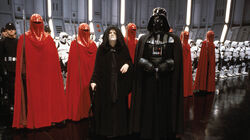
Emperor Palpatine with his Royal Guards and Vader on the second Death Star.
Palpatine turned this temporary setback to his advantage and allowed other Rebel spies to learn of the Death Star's location while planting disinformation which suggested the superweapon was not yet operational. In reality, the station's prime weapon was complete and fully functional, and an enormous contingent of the Imperial Navy was there to protect it. Darth Vader and later Palpatine himself went on board the battle station, believing that if the Rebels thought they had a chance to destroy the Empire's new superweapon and kill the Emperor himself in the process, they wouldn't pass up an opportunity to launch an all-out attack, and they were correct. In addition, as he was completely confident of the Empire's victory against the Rebel Alliance, he also dismissed reports of the Rebel Fleet massing near Sullust as being of no concern when Vader inquired if he was to respond to that information. Despite this, however, he failed to sense Luke Skywalker on board the shuttle Tydirium. When Darth Vader, disobeying his prior orders to remain on the Executor, returned to the Death Star in order to tell him about Luke being on the vessel—although he was aware of Tydirium managing to land on Endor—he was genuinely surprised that Vader sensed Luke on the vessel whereas he himself had not. However, when making sure Vader's thoughts were clear on the matter, Palpatine assigned him to capture Skywalker, stating that he would come to Vader.
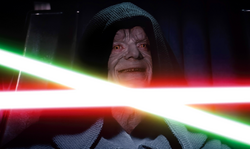
Palpatine watches as Darth Vader and Luke Skywalker battle.
Subsequently, Luke Skywalker, who was convinced that his father could be turned back to the light side, allowed himself to be captured and brought to the Death Star—just as Palpatine had foreseen. Upon meeting Luke, Palpatine learned about Yoda's recent death from probing Luke's mind, and proceeded to mock the late Jedi master.[142] In addition, as a demonstration of his power, he also removed Luke's binders by barely lifting his finger, citing that he no longer needed them, before dismissing his royal guard, before making it clear that he intends to make Luke his Sith apprentice. When Luke insinuated the imminent death of all on board the Death Star, Palpatine revealed how he was well aware of the Alliance's plans, both to Luke's surprise and his own amusement. The Emperor further taunted the Jedi aspirant with the revelation that he had manipulated the Rebels into a trap of his own design; the Rebels had been allowed to discover the location of the new battlestation, and thus Palpatine anticipated their infiltration of Endor. Palpatine had also ordered Fleet Admiral Firmus Piett to not have the Star Destroyer fleet attack the Alliance Fleet when they arrive, as he intended to unveil a surprise for the Rebels, and only wanted the Star Destroyers to prevent them from escaping. When the Alliance Fleet arrived, Palpatine unveiled his surprise: the Death Star's superlaser was operational, contrary to what the Rebels had expected. As Luke's frustration grew with the Alliance's desperate situation, the Emperor manipulated him into a duel with Darth Vader. Palpatine also ordered for Jerjerrod to blow up Endor if the shield is taken down by the rebels, regardless of who got caught in the crossfire.[142]Luke initially restrained himself at first, until Vader probed his mind and learned that Leia was his own daughter. With this knowledge, Vader speculated that he could corrupt her instead, but the threat enraged the young Jedi and drove him to attack Vader in a frenzy.
Although he nearly killed Vader and cut off his mechanical right hand, Luke controlled his anger at the last minute; realizing that he was dangerously close to suffering his father's fate, he discarded his lightsaber and turned to face the Emperor, stating that he was a Jedi, like his father before him.
Enraged, but still using a portion of his powers to monitor the battle,[143] he was aware that the Rebel fleet, though bloodied, was now holding its own against his most powerful armada, and that, worse still, the Rebels on Endor had somehow cut off the shields protecting the Death Star; the station was now vulnerable to attack. None of these problems were insurmountable: He already had a contingency plan of blowing up Endor issued in case the Rebels did such an action,[142] and regardless, as long as he had Skywalker in his grasp, he felt he'd ultimately succeed.[133] However, as with Galen Marek,[116] he had failed once again.[3]
The balance of the Force
- "So be it…Jedi. If you will not be turned, you will be destroyed! Young fool. Only now, at the end, do you understand. Your feeble skills are no match for the power of the dark side. You have paid the price for your lack of vision! Now, young Skywalker…you will die."
- ―Palpatine to Luke Skywalker
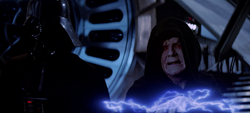
Emperor Palpatine during his torture of Luke Skywalker.
Palpatine had one concern left: the venting of his awesome rage. He knew that it would not be enough to simply kill Skywalker; he had to suffer for his defiance. Raising his arms, Palpatine released a withering barrage of Force lightning that tore through the boy and brought him to his knees. Skywalker had never been trained to repel such an assault, nor could he call on his saber to block it. In addition, although Skywalker attempted to deflect his barrages with his hands via the Force, the intensity of the lightning, combined with his aforementioned lack on training on repelling it, left him overwhelmed.[142] Palpatine taunted the Jedi without pause, calling him weak, feeble and a fool. Although the first barrage was intensely painful, it was not lethal, and the Emperor gradually increased its intensity.
Palpatine intended that Vader also pay for seeking to use Skywalker against him; Vader would be forced to carry his son's dead body to the core shaft and throw it into the chasm.[144] If Palpatine had any doubts, they were answered when he saw Vader dragging himself to his feet and resuming his place at his master's side. However, Palpatine had forgotten what had first enabled him to convert Anakin Skywalker—his desperate need to keep those he cared for from dying—and he had never expected that Vader would refuse to watch his son die, and act to prevent it.[142]
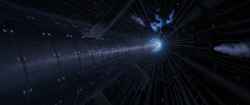
Emperor Palpatine's first death at the hands of Anakin Skywalker on the second Death Star.
Without warning, Anakin grabbed Palpatine from behind, pinning his upper arms to his torso. The Emperor struggled against Anakin's grip, his hands forced high into the air, shooting bolts in all directions, electrocuting himself and damaging Anakin's life-support systems beyond repair. Palpatine also screamed upon being lifted up, both out of shock at Vader's sudden action, and out of pain for being hit by his own bolts due to no longer being completely in control as a consequence. Anakin carried him to the edge of the shaft, lifted him high over his head, and, with the last of his strength, hurled the Emperor into the abyss. He plummeted four hundred kilometers down the shaft,[31] and even as he fell, he refused to admit defeat.[145] Shortly after hitting the reactor, still discharging his force lightning, he then exploded into dark side energy, with it encompassing the throne room before eventually falling back down the shaft.[3]
Emperor Palpatine was dead. Minutes later, his former apprentice Anakin Skywalker also died. With them ended the lineage of Sith Lords that had existed unchanged since the time of Darth Bane. It was this that brought about the long-awaited restoration of balance to the Force. But the Rebel Alliance—and later the New Republic it established—still had much work to do on its own before the era of peace foretold by the ancient Jedi prophets came to pass. The Empire would not surrender its holdings without pitched struggle, and the Emperor himself was loathe to cast off his power, or his life.
Palpatine's Battle Meditation
- "You must have wondered how a few dozen Rebel ships could possibly rout an Imperial force that outgunned it by at least ten to one… The Rebels did indeed fight better, but not because of any special abilities or training. They fought better than the fleet because the Emperor was dead… you must have noticed it. The sudden loss of coordination between crew members and ships; the loss of efficiency and discipline. The loss, in short, of that elusive quality we call fighting spirit… You had no real fighting spirit of your own anymore—none of you in the Imperial fleet did. It was the Emperor's will that drove you; the Emperor's mind that provided you with strength and resolve and efficiency. You were as dependent on that presence as if you were all borg-implanted into a combat computer."
- ―Thrawn to Pellaeon
In Palpatine's absence, the Battle of Endor continued for several hours, but despite its best efforts, his fleet was losing. His death, it was later commented, seemed to trigger a significant demoralization in the Imperial forces. This has caused some to ask if his death played an even more significant role in the Empire's defeat at Endor than has been assumed.
Though four of Palpatine's Grand Admirals—Nial Declann, Makati, Takel, and Teshik—were present at Endor, the one who was, perhaps, his greatest, Grand Admiral Thrawn, was not—he was still on Nirauan, overseeing the pacification of the Unknown Regions. But by the time he returned to the Empire proper nearly five years later, his suspicions—aroused by his insider's knowledge of the Emperor's methods—had crystallized into a working theory, which he related to one of Endor's most pivotal participants, Captain Gilad Pellaeon, the man who had ultimately sounded the Imperial retreat:
Thrawn was speculating that the Emperor's forces were all guided by Palpatine's own indomitable will. While essentially correct, Thrawn was wrong on the part of Palpatine using battle meditation at Endor. During the battle, Palpatine was quite busy trying to turn Luke Skywalker over to the Dark Side. It was actually Thrawn's colleague, Grand Admiral Declann, who was improving the coordination and efficiency of the fleet. (Declann had been trained by Palpatine himself in the use of dark side battle meditation just for such occasions where Palpatine cannot do it in person or to support him.)
It was within Palpatine's power to use the dark side to control his forces, even across great distances. And then, without warning, that control was cut off. The fleet was scattered, and the Rebels were able to lead a successful assault against the Death Star, which was finally destroyed in a risky attack on the station's reactor core. Without its leader and its ultimate weapon, the fragile foundation of the Empire crumbled, bringing all above it crashing down at a stroke. The Empire itself soon fell apart, plagued by warlordism and eventually shrinking to the small and insignificant Imperial Remnant.
Post-first death
Ultimately, the Empire was devastated with the death of their leader, which ultimately resulted in the splintering of the Empire into several factions. This was largely because Palpatine, having intended to rule the galaxy for all eternity, had not left a formal line of succession of Galactic Emperor. The Empire also was even less believing that Darth Vader was responsible for the Emperor's death, believing that he had died trying to protect the Emperor.
The Galactic Empire's attempts of covering up Palpatine's death from the general public were also foiled by the various pro-Rebel groups, who transmitted the footage of the second Death Star's destruction (and thus Palpatine's death) to every personal and official holoprojector throughout the galaxy. This led to various uprisings against the Empire at Bespin, Tatooine, Naboo, and even Imperial Center, which experienced at least initial success.[3][146] However, in the cases of Naboo[147][105] and Imperial Center,[148] the victories were short-lived as the Empire managed to suppress the insurrections, the latter at the behest of the Director of Imperial Intelligence, Ysanne Isard.[149]
Sometime prior to 6 ABY, Lord Cronal, also known as Blackhole, had created an adaptation of the Duel on Death Star II with a pro-Imperial slant near its ending. Its depiction of Palpatine was as a tragic figure who was manipulated by Darth Vader, and then killed mercilessly by Vader before Skywalker killed Vader to avenge the fallen Emperor. Skywalker expressed disgust for the holothriller in question, Luke Skywalker and the Jedi's Revenge.[150]
In addition, the Galactic Museum, due to Imperial influence at the time, tried to portray an alternate version of the Battle of Endor since at least 7 ABY, claiming the Death Star II was actually a Rebel Alliance weapon, and had Palpatine and Vader sacrificing themselves to destroy the weapon. Wedge Antilles, during a mission at the museum, remarked that the story is as compelling as the true history, despite the obvious propaganda.[151]
Palpatine reborn (4–11 ABY)
- "Flesh does not easily support this great power."
- ―Palpatine
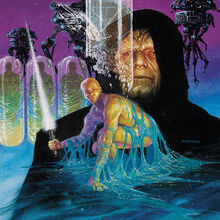
The Emperor reborn.
But even death was not the end for Palpatine. Unlike his Sith predecessors, Palpatine had never intended to be replaced by an apprentice, expecting his Empire to rule the galaxy eternally, with only himself as its true leader. Unable to fully master his former Master's secret, Palpatine had to find a different way to cheat death. During the Clone Wars he tasked Jedi Arligan Zey to capture rogue Kaminoan Chief Scientist Ko Sai following her defection to the Separatists a year and a half into the war. Palpatine hoped Ko Sai would be able to engineer him a longer life span. However, he was denied the chance when Ko Sai showed up dead in 21 BBY.[87]
At an unknown point in time prior to his death at the Battle of Endor Palpatine had found a different way to cheat death by preserving his spirit after the death of his body, by the method of spirit transference. He arranged for a series of clones of himself to be created for his spirit to possess, in the event that he would perish. His primary supply of clones was kept on Byss, guarded by loyal Dark Jedi and immense genetically-altered guards and maintained by a trusted private physician. Unfortunately, the clones were heavily ravaged by the dark side and not sustained by the Force. Each body he took would age and deteriorate more quickly than the last. But the Dark Lord was not concerned; he had an endless supply of clones which he could use to rule the Empire.
After the destruction of the second Death Star, Palpatine's spirit was forced to journey in the maddening, bodiless existence of the void, with both Sate Pestage and various deceased Sith spirits aiding him in his journey back to the living plane of existence,[152] eventually taking possession of the body of Emperor's Hand Jeng Droga. Palpatine called out to Sate Pestage, who rescued the broken body from Kaal and returned it to Byss. Though Droga went mad in the process, he was able to journey to Byss, where Palpatine was able to take possession of a clone of himself. There, on Byss, he would remain for years and would rebuild his strength and Empire. Resurrected, Palpatine accelerated his plan to replace the Galactic Empire with a "Dark Empire", a universe-spanning magocracy ruled through the dark side of the Force alone, without the need for regional governors or technological domination. Around 5 ABY, shortly after his revival, Palpatine had Sate Pestage leak the existence of one of the few remaining pieces of the then-recently deceased Darth Vader's armor: the Glove of Darth Vader, to the false Kadann, real name Rajah Ubooki, with the intention of using it to restore his weakened Force Powers quickly, although the false prophet desired to keep it as part of his own collection. The resulting leak resulted in the Trioculus crisis, a minor conflict between the New Republic and one of the factions of the fragmented Galactic Empire, Trioculus' Empire led by Palpatine's "son," Trioculus.[153]
Following Palpatine's death, a year-long period of mourning was instituted throughout the Empire.[154]
Palpatine's rule was so absolute that his apparent death at the Battle of Endor fragmented the Galactic Empire. Without an heir, opportunistic Moffs and other officers turned into warlords and set out to carve their own kingdoms wherever they could. This worked to the advantage of the New Republic, which succeeded in reclaiming much of the galaxy. Palpatine himself also exploited the various infighting between various Imperial officers to call in various forces with the title of Omnipotent Battle Leader, which also ensured his revival remained a secret to the New Republic.[155]
While Palpatine was still recovering in his Deep Core stronghold, his former advisors received word (8 ABY) of the arrival, from deep in the Unknown Regions, of the last surviving Grand Admiral. This was the Chiss strategic mastermind Grand Admiral Thrawn, who was armed with a plan he outlined to them that would defeat the New Republic. Heartened by the possibility of wresting back their power from the Rebels, they managed to set aside their differences and grant him overall command of their forces, with an eye toward making him their figurehead emperor once they had a throne back to give him.[156] When Palpatine learned of this, he was genuinely devastated. He had liked Thrawn, as much as he was capable of liking anyone. He had entrusted much to Thrawn's genius, even as he had used that genius for his own ends.[156]
Palpatine's reaction may have to do with whatever role he was planning for Thrawn in his own upcoming offensive, Operation Shadow Hand. If anyone knew all there was to know about Thrawn's activities in the Unknown Regions, Palpatine knew. He had to have known what resources Thrawn commanded. Possibly he was only waiting for the right moment to reveal himself to Thrawn and offer him a place in his revived Empire, as he would soon do with many others, but never did. Instead, he let Thrawn make his bid to defeat the New Republic and, in secret, made every attempt to undermine that campaign.[156] This terrible example of Palpatine's pettiness may have cost him everything. A combined offensive, consisting of his own forces launched from Byss, and Thrawn's launched from Nirauan, would have meant the quick and painful death of the New Republic.
The Empire in resurgence (10–11 ABY)
- "You've grown very strong in the Force since we last met… But then, so have I!"
- ―Palpatine to Luke Skywalker
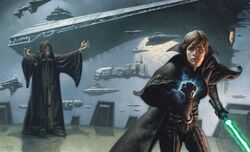
Emperor Palpatine with the Eclipse and his new Imperial Navy behind him.
Thrawn's cunning tactics and unerring strategies brought the Empire to the brink of victory in 10 ABY, and he would have had complete victory had it not been for betrayal by his Noghri bodyguard Rukh. Encouraged by Thrawn's successes, the remaining Inner Circle of Imperial warlords staged a devastating attack on the galactic capital Coruscant. Much of Imperial City was laid to waste as a result, and the New Republic was forced to evacuate. Once on the surface, the Imperials splintered again, and skirmishes dragged on in the devastated cityscape. Palpatine himself stayed his hand in quelling the ensuing mutiny when it started, being motivated by revenge and referring to the carnage as "culling the weak."[105]
It was then that the resurrected Emperor struck. Using his dark powers to create a powerful Force storm, he swept Luke Skywalker to Byss. There, he revealed himself to Luke, and revealed the power of the dark side. Faced with an immortal foe, Skywalker did the unthinkable—in order to defeat the dark side from within, he knelt before Sidious, and submitted himself as the Emperor's new Sith apprentice.[157]
Skywalker's subterfuge
- "I expected to take some damage from him. Any worthy opponent is going to inflict injury. If he doesn't, he's not worth troubling with. Let a few Devastators be destroyed. Let Skywalker think he's getting the best of me. As long as he believes he's succeeding, I have him in my grasp. And as long as I hold him, the more vulnerable he becomes to the unfathomable power of the dark side. Think what he'll do when he is fully mine, when he is working for the Empire, working to help us win!"
- ―Palpatine regarding Luke Skywalker
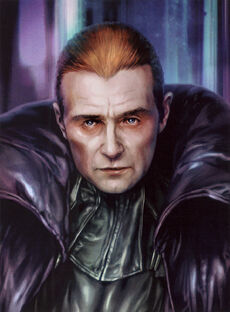
Palpatine in a clone body.
Unfortunately for the Empire, Skywalker stubbornly clung to his old loyalties. Immediately after being appointed Supreme Commander of the Imperial forces, Skywalker accessed the top-secret codes that remotely controlled the World Devastators, and transmitted improper signals. It was this abuse of his new authority that enabled Skywalker to scuttle the Devastator Silencer-7, for instance, and in other ways, both large and small, sabotage Palpatine's work.[157]
Skywalker's treachery obviously could not go unnoticed for long. From the beginning, Palpatine and his most trusted officers were aware of it. Behind the scenes they began expressing their concerns to him about Skywalker's actions. Palpatine reassured them, at the same time reminding them that military considerations were not the only considerations. Quietly, Sidious countered Skywalker's moves, maximizing his gains and cutting his losses. Ultimately, victory or defeat in a single battle, or even an entire campaign, was less important than acquiring an apprentice as powerful as Skywalker promised to be. It was not without precedent; during the Clone Wars he had planned entire campaigns in such a way as to ensnare Anakin Skywalker.[157]
- "One day soon Skywalker will wake up and find that he can no longer go back to his friends. He will look in a mirror and he will see his true face, the face of power… the face of the dark side."
- ―Palpatine
When Leia Organa Solo arrived on Byss attempting to rescue Luke, she only succeeded in getting herself captured, along with her husband, Han Solo. Sidious quickly attempted to turn her to the dark side, tempting her with the Jedi holocron he had stolen long ago from Jedi Master Ashka Boda, and stirring her anger by revealing that he planned to transfer his mind into the body of her unborn child once he was born. Unfortunately, his attempt backfired and she flipped over the bed he was lying on and fled. Initially Sidious was pleased, but his glee quickly turned to rage when he discovered she had stolen Boda's Holocron in the process. Luke Skywalker aided her and Han's escape before attempting to rebel against Palpatine.[157]
In the end, Skywalker was too enmeshed in the dark side to successfully rebel against his new master, despite marching into the cloning lab and smashing all of Palpatine's cloning tanks. Before he could finish the job, Sidious transferred his spirit into one of the last clones. Luke then attempted to subdue Sidious, citing that his time as the Sith Lord's apprentice had given him knowledge of Sidious' weaknesses. Sidious scoffed at this and seized one of the lightsabers he kept in the lab. He then engaged Luke in a spectacular lightsaber duel. However, even Luke's skills with Djem So were not enough, and he fell before Palpatine's brutally intense swordplay.[157] After defeating Luke, Palpatine then inserted himself into Luke's mind and proceeded to break Luke's spirit to the extent that the latter even disavowed his own name.[158] It was only from his sister, Leia Organa Solo, that he gained the strength that he needed to fight back.[157]
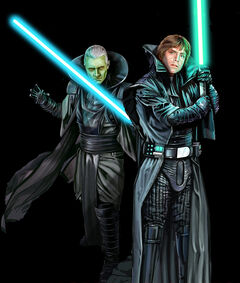
The clone Darth Sidious, with Luke Skywalker as his Sith apprentice.
Appearing in his Eclipse-class dreadnought Eclipse above Pinnacle Base, Palpatine demanded the return of his stolen holocron and the presence of Leia, who complied, in exchange for a possible truce with the New Republic. When Leia arrived aboard Eclipse, she implored Luke for help—as foretold by Bodo Baas's Master a thousand years earlier. Skywalker managed to cast off the veil of the dark side that cloaked his mind and turned on Palpatine. Enraged at this latest development, Palpatine brandished a blue-bladed lightsaber and struck at Luke. Despite Palpatine's viciousness, Luke managed to defeat the Sith Lord in a brief but intense lightsaber duel, slicing off his hand.[157]
Palpatine was hardly finished, summoning a Force storm against the New Republic fleet. However, the siblings banded together and, with the aid of the unborn Anakin Solo, were able to use the light side of the Force to temporarily sever Palpatine's connection to the Force. The Force storm, no longer under Palpatine's control, destroyed Eclipse, killing Palpatine again while the pair fled, ending the Battle of Pinnacle Base.[157] His spirit survived and found its way into another clone body.[159]
The last clone
After the Battle of Balmorra, two Dark Side Adepts Nefta and Sa-Di began to slaughter the secret auxiliary clones Skywalker did not kill. Executor Sedriss killed them for their defiance, as the last clone of Palpatine emerged, planning to resume conquest of the galaxy.
Having returned in yet another clone, Palpatine continued his scourge against the New Republic. Armed with the deadly superweapons, the Galaxy Gun, and his second Eclipse-class Star Dreadnought, Eclipse II, Palpatine forced many New Republic worlds to submit to Imperial rule. But, despite his growing Empire, Palpatine was again deteriorating and becoming frail and weak.
Even worse, the Emperor began to succumb to genetic tampering done to his clones by the treacherous Imperial Sovereign Protector Carnor Jax. He tried to clone other bodies so that he could resurrect himself, but Jax had succeeded in tainting even the genetic source material. With his body wasting away rapidly, he went to the Sith world Korriban to consult the ancient spirits of his forebears in the Great Temple. The spirits initially wondered whether Palpatine was going to take Vader's place on his tomb, as he was not placed there, but Palpatine declined and instead demanded to be healed.[152] They advised that he use Leia's newborn son, Anakin Solo to house his spirit. The Dark Side Adepts escorting him vowed to be his watchmen until his new body would grow up. Sidious, though he deeply distrusted his tools, especially after Nefta and Sa-Di's betrayal, had no other choice; he ordered Eclipse II to make course for the Onderon system, where the Solos had relocated their children.
While the New Republic engaged the Imperials, a team of Jedi, led by Luke, sought out the Emperor. They did not find him aboard his ship since he had slipped down to Onderon to find Leia. During the battle, Lando Calrissian and R2-D2 had infiltrated the flagship. R2-D2 then sabotaged the vehicle's automated hyperdrive engines and set the coordinates to match the location of the Galaxy Gun, which was over Byss. The flagship fled into hyperspace, despite the efforts of the crew to regain control of the vessel. There above Byss, both superweapons collided with each other. The Galaxy Gun's final missile was pulled into the planet's gravity and exploded, destroying the reborn Emperor's throne world.
Palpatine's final death
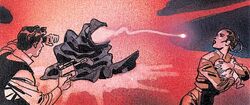
Palpatine's spirit departs the last clone body he occupied.
Meanwhile, the Emperor faced Leia and demanded that her newest child be his to possess. She fought back, but was no match for the Emperor. Before he could complete his plot, Luke Skywalker and two other Jedi, Rayf Ysanna and Empatojayos Brand, arrived. Palpatine killed Ysanna instantly and fatally wounded Brand, but was shot in the back by an enraged Han Solo during the conflict.
His last body destroyed, the Emperor's cackling spirit flew toward young Anakin Solo, but was intercepted by the dying Brand, who threw himself in the way. The Jedi Knight bound the Emperor's soul to his own departing life force, taking it with him as he became one with the Force. Railing and cursing against the Skywalker family, Emperor Palpatine's spirit was dragged into the depths of the Force, where every deceased Jedi would ensure his dark essence would never again return to wreak havoc upon the galaxy. There he would experience disembodiment in darkness, perpetual madness as if to always live with an open wound; terror without respite.
Darth Sidious was finally, and permanently, dead.
Legacy
- "After all, you are full of life, and I… well, because the Holocron is now in your hands, I must assume that I am but a whisper from the past."
- ―Darth Sidious, a gatekeeper of the Telos Holocron
Even though Palpatine's final death prevented his spirit from returning to the mortal plane, his legacy would endure long after his ultimate defeat. His entire reign as the Dark Lord of the Sith led to the galaxy's ruin and the deaths of trillions. The loss of the Emperor did not stop the remnants of the Empire from continuing the Galactic Civil War for almost another decade, and the Sith continued to persevere through several incarnations that were separate from Bane's Order. The New Order also managed to survive despite the Empire's defeat, even though it was largely amended to exclude many of Palpatine's tyrannical policies. There were even people who craved for yet another one of his returns.
The Second Imperium scam (23–24 ABY)
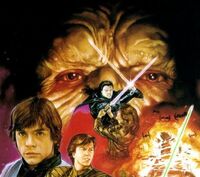
Leader of the Second Imperium.
Some nineteen years after the Battle of Endor, and more than a decade after the last of the clone bodies of Emperor Palpatine were destroyed, it seemed that he had arisen in another and become head of a coalition seeking to reestablish the Empire. The Great Leader of the Second Imperium was supposedly the Emperor reborn yet again. The Emperor's image was transmitted regularly to the Shadow Academy. Although the academy leader, Brakiss, found it difficult to imagine how the Emperor had survived, he knew that with the Force, many things were possible.
The Great Leader was transported to the Shadow Academy sealed within a room-sized containment unit. Brakiss eventually discovered that the Great Leader was not Palpatine after all, but a series of recordings and props used by four Emperor's Royal Guards to trick the galaxy into thinking that the Emperor had returned to rule the Second Imperium.
Book of Sith's rediscovery (24 ABY)
At some point prior to his final death, Palpatine had placed the Book of Sith, which he had updated to include his manifesto, Absolute Power, into one of his storehouses on Mount Tantiss at Wayland. The book survived the destruction of the storehouses, and was later discovered by Skywalker in 24 ABY after he stumbled upon a chamber that had not been known before then. Skywalker proceeded to investigate the book to make sure its knowledge wasn't dangerous upon its discovery before supplying it to the Historical Council, with only his wife and sister being aware of its existence.[14]
Telos Holocron
- "Although these insights from the mind of Darth Sidious are nearly priceless in their historical value, it is important to point out the fact that Palpatine's numerous clones were indeed just that—clones. The possibility remains that the former Emperor's clones only believed themselves to be the real Palpatine."
- ―Tionne Solusar
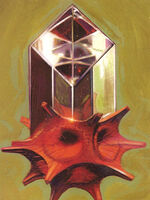
The Telos Holocron, a reservoir of the knowledge and experience of many Sith Lords, including Darth Sidious.
Sometime between his first death and his final death, Palpatine compiled his knowledge into the Telos Holocron, acting as one of the Holocron's gatekeepers and offering his knowledge to future aspiring Sith. He detailed the importance of an apprentice, his rise to power, the cloning techniques he used to cheat death, and more about the Sith in general. It was unknown to Tionne Solusar how Palpatine came upon the Telos Holocron or when he did. The Holocron was eventually obtained by the Jedi in 40 ABY, preventing its dark knowledge from corrupting curious Jedi. As the researcher of the Telos Holocron, Master Solusar studied and included many of its teachings in her written study of the Jedi and the Sith.[20]
Although Palpatine's spirit had in fact managed to stave off damnation by inhabiting the bodies of his clones one by one, there was still some skepticism regarding his achievement. Master Solusar was not necessarily convinced that Palpatine's spirit was able to persist in this way. Her speculation led her to believe that the fallen Emperor's clones merely believed themselves to be the real Palpatine, but were ultimately just clones that possessed the memories and Force potential of the Emperor. As such, Solusar viewed the clones as not only separate individuals from each other, but also from their genetic template as well.[20]
Ironically, Solusar appreciated the historical value of Palpatine's mindset as recorded by the Telos Holocron, but could not dismiss the chance that many of the recordings were made by the Dark Lord's clones rather than the true Palpatine himself.[20] While Solusar's belief was shared by the Jedi Master Mara Jade Skywalker,[18] it was not shared by Grand Master Luke Skywalker, who personally served the reborn Emperor for a brief time after his resurgence.[20]
Lumiya's Sith
- "You're… as vile as he was."
"Who?"
"Palpatine." - ―Mara Jade Skywalker and Jacen Solo

Darth Caedus, arguably the first active Sith Lord since the time of Darth Sidious and Darth Vader.
Despite Anakin Skywalker's ultimate sacrifice and the final death of Emperor Palpatine, Darth Bane's Sith Order was preserved by Lumiya, a Force-sensitive Human female who received some training under the instruction of Darth Vader and the Emperor. Due to the untimely deaths of both Sith Lords, the mantle defaulted to her and she took it upon herself to ensure the survival of the Sith and its traditions, including the Rule of Two. Thus, she formed her own Sith Order that closely resembled the Order of Bane.[160] After a few failed apprentices, Lumiya all but disappeared from the galactic stage, until resurfacing in 40 ABY with the intention of seducing Darth Vader's grandson, Jacen Solo to the dark side of the Force.[15]
Though she was once fiercely loyal to Emperor Palpatine and Darth Vader, Lumiya developed a strong sense of disdain for Palpatine and viewed Vader with pity. Regarding Palpatine, she informed her future apprentice, Jacen Solo, that Palpatine/Darth Sidious was "a psychopath consumed with power", and that Vader had been "a sad man....whose one anchor to the world of the living was, yes, a galaxy-conquering madman." Like Tionne Solusar, Lumiya was skeptical about considering the Emperor's clones as the true Emperor himself. She even resented the clones and was not entirely convinced that they could be counted amongst the Sith. In her eyes, the clones never earned the knowledge and power of the Sith through struggle and sacrifice; they simply inherited the Sith legacy through the memory imprints of their progenitor. Thus, Lumiya believed that the last true Sith were destroyed when the Emperor and Solo's grandfather died at the Battle of Endor.[15]
As Lumiya'a apprentice, Jacen Solo gradually embraced his destiny as a Sith Lord by freeing himself from his former persona and life as a Jedi. He justified his transformation by convincing himself that his preoccupation was different from those of Sidious and Vader. Unlike Sidious, he was not motivated by self-serving ambitions or an insatiable lust for power; he did not fall to the dark side for selfish reasons like Vader. Solo genuinely sought to bring about an everlasting age of peace and order to the galaxy.[15] After sacrificing his aunt Mara Jade Skywalker to fulfill his training, Jacen Solo renamed himself as Darth Caedus,[161] thus fulfilling Lumiya's dream of creating the first true Sith Lord since the deaths of Darth Sidious and Darth Vader.[15] When Lumiya sacrificed her life in a final confrontation with Luke Skywalker,[161] Lord Caedus eventually anointed the Jedi Tahiri Veila as his apprentice, thus continuing the Sith legacy in accordance with Darth Bane's Rule of Two.[162] Shortly before the end of the Second Galactic Civil War, however, Veila severed her ties to Caedus and surrendered to the Jedi. Combined with her former Master's demise, Veila's rejection of the Sith legacy brought an end to the Rule of Two.[163]
Palpatine's groundwork
In 123 ABY, the Jedi Knight Kol Skywalker, surprised at how very few in either the New Jedi Order or the Galactic Alliance were able to comprehend the complexity of Sidious' plot to destroy the Jedi and the Old Republic, wrote in his journal the explanation on how he managed to pull it off.[102]
One Sith
Over a century after Palpatine's fall, a new Sith Order known as the One Sith had been founded by one of the few survivors of his Jedi Purge, Darth Krayt, the former Jedi Master A'Sharad Hett. With thousands of Sith servants at his disposal, Krayt swore that they would never repeat Palpatine's mistakes such as letting scattered Jedi live. However, unlike Palpatine, Krayt did not adhere to the Rule of Two at all, which caused the architect and founder of the Order of the Sith Lords, Darth Bane, and even ancient Sith Lords predating Bane and his dictum, such as Darth Andeddu and Darth Nihilus (all via their respective holocrons), to consider him a heretic and pretender. Darth Krayt devised the Rule of One, a concept entirely different from Sidious's Rule of One. Whereas for Sidious the One was his own self, who would rule the universe forever, for Krayt the One was the Sith Order itself, united under his leadership in order to bring order to the galaxy.
Works
Works written by Palpatine
Books
- The Paths to Power (30 BBY)[90]
- Absolute Power (19 — 18 BBY[14])
- Book of Sith (ed.)[14]
- Principles of Power[165]
Legislation
Works about Palpatine
Holofilms
- The Clone Wars (c. 7 ABY)[151]
Personality and traits
- "You're heartless, ambitious, arrogant, insidious, and without shame or empathy. More, you're a murderer."
- ―Darth Plagueis to Palpatine

Palpatine, Galactic Emperor
Through his own nature, Palpatine, alias Darth Sidious, was evil incarnate.[166] He insistently made clear to Anakin Skywalker, however, that he did not believe himself to be evil, but simply beyond common morality, calling evil "a label we all put on those who threaten us."[23] Aside from his opinion on morality, he believed himself to be the embodiment of darkness and the living incarnation of the dark side of the Force, and, after the death of his body, he saw himself as pure energy, or simply the dark side itself.[157] He was instinctively treacherous, betraying and killing numerous beings who trusted him, such as Vidar Kim, Darth Plagueis[1] and nearly, Darth Vader.[3] Ever since his youth, Palpatine's main goal had always been nothing less than the acquisition of absolute power. In this personal quest, he showed that he was also patient, arrogant, vastly intelligent, and an incredible actor. Despite his innate nature, he was able to play the part of a good and honest politician for decades; even the Jedi Council was taken in by his facade. His skill at subterfuge was sufficient to even convince Darth Plagueis, upon the latter's revelation that he was a Sith, that he knew little of that Order,[1] when he in fact had sought to join the Sith long before he met the Dark Lord.[14] As both Senator of Naboo and Supreme Chancellor of the Galactic Republic, he appeared as an unassuming, tea-drinking[167] old man, almost grandfatherly, with elegant robes. With his cheery demeanor, trademark smile, and a reputation for being a kind and modest man from Naboo, he won the hearts of billions during the Clone Wars, promising to bring justice to a government mired in corruption and chaos. This served to hide his true motives behind a perfect disguise in order to gain acceptance for his new Empire.[168]
After Mace Windu's attack on him, he created a new image of himself; that of a pitiful victim of a random act of violence. He had been left after the attack with the appearance of a gnarled, ancient man with pale skin, and searing, sickly yellow eyes. He wore a heavy dark cloak, which gave him the appearance of being a simple individual to hide his force abilities, and carried a glossy black cane, leaning heavily on it to create an illusion of weakness.[169]
His acts as a loving politician and later a helpless victim served only to bolster his true persona, that of Sidious. The Dark Lord was a highly manipulative, Machiavellian, exploitative and seductive megalomaniac, easily bending others to his will in his quest for Sith supremacy and ultimate power.[13][157] A narcissist, Sidious identified his own essence with the very blackness of space,[170] even going so far as to declare himself the ultimate personification of the dark side.[157] Sidious also displayed traits of psychopathy, including extreme sadism and cruelty, taking considerable pleasure in the suffering and deaths of others. One of his more prominent demonstrations of this trait was when he ordered Vader to execute Galen Marek, breaking into a fit of hysterical laughter as Marek was telekinetically pummeled by Vader, and continuing to chuckle quietly for several moments after Vader apparently killed Marek.[116] In fact, he was known to cultivate life-forms for the sole purpose of eventually killing them.[20] His sadism was such that, when murdering his Master, Darth Plagueis in his sleep, he paused occasionally to mock Plagueis for being manipulated by him and revel in Plagueis's pain before continuing.[1] He later demonstrated similar behavior immediately before his death at the hands of Vader while torturing Luke Skywalker, smiling at the young Jedi as he prepared to kill him.[3] His inherent sadism apparently had its roots with his father, Cosinga Palpatine—a penchant for violence was one of the few things the two men had in common.[1] Regarding his views on failure, he was once noted by Darth Vader to be "not as forgiving as [Vader was]" when telling Moff Tiaan Jerjerrod that Palpatine is arriving at the Second Death Star to inspect it; the implied warning being that he might be executed by the Emperor due to the project being behind schedule.[3] He once claimed himself to be the "King of Beasts" to his father, after the latter deduced that Palpatine always had murder on his mind and desired permission to carry it out, if he even needed permission to do so.[1] Likewise, he also holds absolutely no qualms with destroying a huge amount of his own forces in order to get rid of his enemies. This trait was especially evident during the Battle of Endor, where he ordered Moff Jerjerrod to fire the Death Star's superlaser at Endor in the event that the Endor Task Force somehow managed to capture or destroy the shield generator, also making it very clear that he did not care about how many of his own troops were killed as a result.[142] Vader also mentioned on one occasion, while comparing himself to the Emperor, that while he himself killed only when necessary, Sidious did it to amuse himself [171] Enough of his psychopathic nature had been unveiled to the subjects of the Empire that several members of the Imperial hierarchy viewed him as having delusions of grandeur.[172] Some of his officers such as Stormtrooper Corps Commander Nahdonnis Praji dismissed these claims as figures of speech, although in Praji's case, he reassessed his original views on the matter when meeting the reborn Emperor face-to-face in 10 ABY.[173] Some also believed him to have been simply installed as a puppet ruler.[172]

Palpatine's Sith signature and seal
Even as a child, Palpatine was demonstrated to be manipulative, psychopathic, and self-centered. This is especially evident by his frequent breaking of various rules and social norms, knowing full well that his father, whom he hated, would simply pay off the authorities to make the problem disappear, and his declaration upon causing an accident that killed two pedestrians while using a speeder that he'd like to become a professional racer.[1]
By the time of his first death in 4 ABY, Sidious' features had taken an even more extensive toll, due to his extensive usage of the dark side, enough to have ensured his being pushed beyond his natural age limit.[169]
Although possessed of an insatiable hunger for power, he honestly believed a Sith government would be best for the galaxy, and in time came to regard himself as something of a savior.[168] He also viewed all sentient beings bereft of the Force as inferiors, likening them to children floundering about aimlessly, ignorant of their own shortcomings and incapable of fulfilling their aspirations. As articulated in The Weakness of Inferiors, Sidious considered the wise and powerful—specifically Force-sensitives—as responsible for providing guidance for such lesser entities in order to allow for a thriving civilization. Seeing no one wiser nor more powerful than himself, he deemed only himself as worthy of realizing this philosophy, and thus endeavored to control the galaxy forever.[20]
In addition, despite his narcissistic nature, Sidious was capable of acknowledging his mistakes: shortly after he was revived from his first death, he stated in his entry of the Telos Holocron that Anakin's redemption and turning against him, resulting in his first death, was largely his own fault rather than Vader's. In addition, his entry in the Telos Holocron also indicated that he took into account the possibility that he might fail in his quest for immortality and made provisions for this event.[20]
Palpatine was a prolific author; his notes on political and military sciences became popular texts, and his theories on these subjects were taught at universities throughout the galaxy. One of his texts in particular, The Paths to Power, was noted in the last Republic Holonet News Edition as one of the new Emperor's notable achievements,[90] while another, the Principles of Power, was mandatory reading for Imperial Moffs at the height of the Empire.[165] After his ascension to Emperor,[14] Sidious, largely free from the work of governance due to the system of governorship he had set up during the war, began devoting some effort towards writing what he intended to be the seminal work on the dark side of the Force—the Dark Side Compendium, which was comprised of volumes one, two and three, entitled The Book of Anger, The Weakness of Inferiors, and The Creation of Monsters respectively. However, he had left the work unfinished when he died above Endor, and he failed to finish the third volume after his resurrection, leaving the work incomplete in 11 ABY. Besides the Compendium, Sidious also wrote two manifestos, The False War, detailing the Clone Wars' role in fulfilling Darth Bane's Grand Plan, and The Useful Bureaucrats, detailing his manipulation of various important people and events to ensure his rise to power. The three volumes of the Compendium, The False War, and The Useful Bureaucrats were likewise placed in a manifesto known as Absolute Power. He also edited the Book of Sith.[14]
Palpatine was a known patron of the arts, attending the opera whenever able and surrounding himself with unique statuary and decorative antiques.[10] Many of these statues served as convenient hiding places to stash Sidious' various Sith artifacts and lightsabers.[168]
Palpatine was also a skilled manipulator and strategist, having orchestrated countless events in the galaxy, including the Naboo and Separatist Crises, as well as the Clone Wars, in order to secure a position of power which largely went according to plan. Even in the rare times that something occurred during those events that he did not initially plan for, he usually takes into account of this setback and reworks it so he succeeds in his plans regardless. This trait of improvisation is especially evident with Queen Amidala's successful arrival on Coruscant during the Naboo crisis, which forced him to rework his plan from using Amidala as a martyr and drawing out the crisis long enough to consolidate power to instead having Amidala act as a witness to the events of the Trade Federation occupation to dethrone then-Supreme Chancellor Finis Valorum.[1][11][13]
Upon his ascension to Galactic Emperor, he modified his transmissions via hologram to appear several times bigger than himself, to the extent that the only part of him that actually appears in his transmissions was his head. This was done for two reasons: The first was to intimidate his subordinates, and the second was as a means to easily hide aspects occurring in the room from subordinates that he did not wish for them to know. The latter reason was especially evident in the aftermath of Occupation of Bespin, where his modified use of his hologram all but ensured that Vader did not see that Prince Xizor was in the same room as Palpatine. Prior to his ascension and reorganization of the Galactic Empire, however, Palpatine utilized holographic communications the standard way, both in his public persona and as Sidious.
Despite his exceptional skills in lightsaber combat and his mastery of the dark side, Sidious was no less susceptible to fear, one of the primary emotions of the dark side, than any other Sith. In an effort to gain Anakin Skywalker's sympathy, Palpatine appeared to cower before Mace Windu, which may have been out of both practicality and desperation due to such a calculated risk. Nevertheless, he only attacked Windu after the Jedi Master had been disarmed and rendered helpless by Skywalker; in fact, his cowering was just a trick to get Skywalker into striking at Windu.[23]
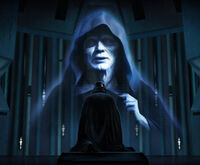
The Emperor's hologram towers over his apprentice
After his ascension as Emperor, Sidious displayed visible fear after being attacked by a powerful Force push from Yoda. He attempted to flee rather than fight, and only confronted Yoda when he appeared to have no other choice in the matter.[10] During the battle over Coruscant, General Grievous considered Palpatine a coward when deducing that the Chancellor was hiding under the consoles while Grievous's battle droids fought Anakin Skywalker and Obi-Wan Kenobi on the Invisible Hand. However, Grievous did not know that Palpatine was actually Darth Sidious.[23]
Since Palpatine was in no position to reveal his Sith identity until the right time, he was forced to refrain from using his Force powers to protect himself while in an extremely dangerous situation that presented considerable risk to his life. Before his death, Mace Windu incorrectly sensed fear in Sidious (it was actually Anakin Skywalker's fear that he sensed) and believed that it was the cause of the Sith Lord's defeat.[23] Many years later, Luke Skywalker also detected the same traces of fear that resided with Sidious, as it did inside all who adhered to the dark side of the Force. Fear ultimately proved to be the Emperor's Achilles' heel as it caused him to constantly plot and devise schemes against his enemies, which ultimately lead to the unexpected creation of the Rebel Alliance and the eventual downfall of his empire.
Palpatine also held some hatred and disgust for the Wookiee holiday Life Day, especially due to the Rebel Alliance being involved. He once had a publicist relay to Hol't Deb Orah of Corellia Times that he'll give those celebrating the holiday his official "Bah, humbug!", even though he refuses to acknowledge the efforts made by the Rebels.[174]
On a lesser note, Sidious did appear to fall short when it came to acquiring a truly worthy apprentice to the Sith mantle. After spending years preparing for Anakin Skywalker's fall to the dark side, and finally having him as his own, Sidious was robbed of his perfect apprentice when Skywalker's power was severely diminished due to his extensive injuries on Mustafar. Both his attempts to replace the hobbled Vader were failures, Galen Marek opting to sacrifice himself to save the Rebel Alliance, and Luke Skywalker devoting his efforts to redeeming Vader rather than killing and replacing him.[3][175] Sidious ultimately considered any other candidates invalid, as, while powerful in their own right, they simply were not in his league.[20] In addition, regarding his own apprentices, he usually betrayed them and engineered their deaths when they either proved weaker to another candidate or if they failed him: he considered Maul dead, but tortured him after discovering his survival and subsequently defeating him and his brother Savage Opress on Mandalore.[83] Later, he had Anakin Skywalker kill Darth Tyranus in order to ensure Skywalker's replacement of him as Sidious' apprentice. The Dark Lord eventually had Skywalker, rechristened as Darth Vader,[10] nearly suffer a similar fate at the hands of Galen Marek as well as his own son, Luke Skywalker. The new Emperor briefly considered leaving Vader to die on Mustafar due to his injuries and failure, but soon thought better of it. In fact, the closest Sidious ever came to actually valuing any of his apprentices was with Vader, having saved him largely because, despite his injuries, he was still powerful, and also because Vader was effectively his creation. Once, he stated that he would have zealously created Vader again if given the opportunity.[20]
After his first death and subsequent revival, Sidious frequently took to utilizing clone bodies to sustain himself. However, he decided to strike at new targets with his Galaxy Gun instead of fortifying his gains when he returned in a fresh clone body after his defeat at the Battle of Pinnacle Base. According to Crix Q5 Baobab, this alleged lapse in judgment was a result of Palpatine's madness having deepened from his second return.[105]
According to Mara Jade, the Emperor "would have been ashamed to use such tactics" as illusions calculated to break someone emotionally.[176]
Romances and children
It is unknown what, if any, romantic or physical relationships Palpatine had during his lifetime, and to what extent. Since his youth, Darth Sidious was focused only on the acquisition of power, and wore the identity of Palpatine like a mask in order to advance his career and reach a position of power in the Republic. As a young man and ambassador-at-large for Naboo, he evidently found it useful to make it appear that he was in an amorous mood when it suited him, for he was known to the people closest to him, such as Vidar Kim and Kinman Doriana, as a ladies' man. Always focused on the Grand Plan and the takeover of the Republic, Palpatine appeared, in his words, "always eager to make friends," using flirtation as a tool to advance his agenda of gaining political power.[1]
As Galactic Emperor, Palpatine surrounded himself with concubines at the Imperial Court,[19] and at least one of them, Roganda Ismaren, claimed to have been, at the very least, physically involved with him. Director of Intelligence Ysanne Isard also made the same claim; as she once told Corran Horn, she had loved the Emperor, but mostly for his power.[177] In fact, most who claimed intimacy with the Emperor did so out of a desire to position themselves as power-brokers. The legal details of a potential Emperor's wedding were specifically included in Imperial law, and in fact specified that the bride would forfeit her rights and become the groom's property—although that particular law may have been a Church of the Dark Side fabrication.[178]
Irek Ismaren
Even more chillingly, some of them, such as the Emperor's Hand Roganda Ismaren, sought to wield power in the name of the children they expected to assume the throne on Palpatine's death. In Ismaren's case, her son Irek Ismaren, sired by a fellow Emperor's Hand, Sarcev Quest, was put forth as the fruit of one of Palpatine's "dalliances" in a plot to gain the vacant throne. The plot failed, but there is a fair chance that it was but one of many such instances.[115]
Sly Moore
Rumors persisted that Palpatine had a sexual relationship with Sly Moore, and many went so far as to declare her the "Queen of the Empire."[179]
Triclops
During the height of the New Order, it was assumed that Palpatine had sired a son, named Triclops, by an alien woman who had three eyes. In fact, the truth of Triclops's parentage is more convoluted. Early in his first term of office as Chancellor, Palpatine commissioned two Shi'ido scientists, Mammon Hoole and Borborygmus Gog, to undertake experiments in the spontaneous generation of life, continuing the studies begun under Darth Plagueis.[14] Palpatine's aide, Sly Moore, supplied Gog and Hoole with a "volunteer" test subject, a certain Niobi, a gentle and meek female from Bordal. According to rumor, their first experiment went terribly wrong, resulting in the birth of a three-eyed mutant. Hoole and Gog blamed Niobi for the failure, and the Chancellor's confidant Sarcev Quest spirited Niobi and Triclops away.[180]
As Triclops grew, he was trained by the Prophets of the Dark Side to eventually become an Emperor's Eye, a far-seeing extension of Palpatine's own will,[41] but Triclops began spouting "insane and dangerous" views about peace and disarmament, views that were anathema to the Emperor. Palpatine could not permit Triclops to remain free, but he could not kill him either; his subconscious visions of war machines were most inspiring to his weapons manufacturers. As a third option, he banished Triclops to the spice mines of Kessel, to live as a common slave.[181]
Powers and abilities
- "The dark side of the Force is a pathway to many abilities some consider to be unnatural."
- ―Palpatine
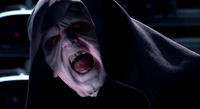
When angered, Sidious was a frightening sight to behold and an overpowering opponent.
Trained to perfection by Darth Plagueis, Darth Sidious was considered by many, including Darth Vader[164][182] and Luke Skywalker,[164] to be the most powerful Sith Lord in the entire history of the Sith Order—something he himself firmly believed.[1][23] His status as such had also been documented within the the second edition of an important historical chronicle.[26] Additionally, he was the only Sith Lord in a thousand years to achieve the ultimate goal of the Sith: to eradicate the Jedi Order and bring the galaxy under the rule of the Sith.[23] He was also considered the one Force user to have successfully tamed the Dark Side of the Force, exceeding even that of Ulic Qel-Droma.[156]
Lightsaber training
Darth Sidious with one of his lightsabers ignited.
Despite his frail appearance, Darth Sidious was incredibly skilled in lightsaber combat, one of the greatest duelists of all time. A Sith Swordmaster, Sidious was one of the very few who was the equal of Count Dooku, Mace Windu and Yoda. As a result of his tremendous skill, he killed Agen Kolar and Saesee Tiin—who were considered to be two of the finest lightsaber duelists of their time—each with a single blow, and while also engaged with Mace Windu, he slew the formidable Kit Fisto only moments later. He also held his own against Yoda in a lightsaber duel later on but in the end he forced the Grand Master to flee with his Force powers rather than his lightsaber.[10] Many years later, Sidious, in one of his clone bodies, engaged and defeated Luke Skywalker in a one-on-one lightsaber duel in his clone labs on Byss[157], despite losing to the latter in their second encounter. He was ambidextrous and could change his fighting style at a whim—keeping his opponents unsure of what his next move would be. A master of every form of lightsaber combat and stances, Sidious drew his opponents in, fighting less than his true capability, and then striking the fatal blow when his opponents thought they had the better of him. When fighting at full strength, the Sith Lord was a terrifying opponent. During his assassination of the Gran Protectorate, the speed and ferocity of his technique was so great that it appeared as though his victims were dispatched by a phantom.[1]
Sidious had an extremely aggressive dueling style and augmented his swordplay by using Force speed, which allowed him to defeat three experienced Jedi Masters at once with very little effort. His style was a combination of brutal aggression and lethal precision making him an almost unstoppable opponent. Sidious' brutal fighting style allowed him to overwhelm Luke Skywalker during their first duel and Skywalker only barely defeated him during their second. In fact, the only people known to have defeated him in lightsaber combat were Mace Windu and Luke Skywalker.[10][157]
Although Sidious usually used only one lightsaber, he was also a master of Jar'Kai, wielding both of his lightsabers against Darth Maul and Savage Opress. Utilizing a ferocious yet fluid fighting style, Sidious fended off both brothers simultaneously. Sidious effortlessly defeated them, killing Opress and disarming Maul.[83]
Ironically, despite Sidious's masterful dueling skills, he was fairly disdainful of lightsaber combat in general, believing the Sith to have grown beyond the need for lightsabers.[24]
Force powers
- "I've played along with your Jedi dueling games long enough! Now you will experience my full potency… I live as energy… I am the dark side!"
- ―Darth Sidious
Sidious demonstrates his prowess at telekinesis during his battle with Yoda.
In addition to his lightsaber combat skills, Darth Sidious was one of the most powerful Force users of all time, perceived in the Force by his apprentice, Darth Tyranus, as a "black hole of the dark side."[23] Both Luke Skywalker and Darth Vader, likewise, had viewed Sidious as having become the Dark Side's most powerful expression.[164] Sidious' relationship with the dark side was so deep to the point that he became a possession of the dark, and the dark became a possession of his. As an apprentice under Darth Plagueis' tutelage, he learned all the known dark side powers of his predecessors, until he considered himself the Sith'ari. Sidious' mastery of the Force was such that even he at times wondered if the Force had been so strong in anyone before him, feeling a monster rising from the core of his self, impatient to unleash itself. Shortly after the death of his master, Sidious received a most powerful vision from voices that proclaimed his reign. He himself considered that the simple act of glancing at him was tantamount to glimpsing the dark energy that bound and drove the galaxy. Even prior to his induction into the Sith, his Force potential was powerful enough to block out Darth Plagueis' (while adopting the public identity of Hego Damask) mind reading abilities when they first met, and later able to effortlessly and telekinetically murder his parents, siblings, and their personal guards.[1]
Sidious attacks Yoda with Force lightning.
Sidious was a master of Force lightning and was known to use this both as a lethal attack, and as a way of torturing his enemies.[3] If used to its full potency, he can instantly reduce one or more people into charred husks.[93] In addition, he could use this power to light up the surface of an entire planet.[183] He could also use this power in conjunction with telekinesis to electrify objects that he is levitating before hurling them at his opponents, thus increasing the damage potency of the attack, called lightning grenade.[116] He was also extremely skilled with telekinesis; during his battle with Yoda, he levitated several Senate pods simultaneously, including the one he was standing on, with incredible dexterity and precision.[10] Likewise, he was skilled enough with telekinesis that he was also able to remove Luke Skywalker's restraints while barely even lifting his finger when meeting face to face on the Second Death Star.[3] Sidious was a master of Force speed, implementing it into his fighting style and allowing him to move so quickly that his opponents would often find themselves unable to react in time.[23] Darth Sidious also possessed the power of Force Flight.[116] After the first decade of his apprenticeship under Darth Plagueis, Sidious possessed an exceedingly feral usage of Force rage, demonstrated when he assassinated the members of the Gran Protectorate that organized his and his master's failed assassination attempt.[1] He also utilized an ability similar to that of Static Barrier, which he utilized during his fight with Marek in conjunction with Force Flight to temporarily retreat from the battle in order to have his red guards and senate guards attack Marek.[116]
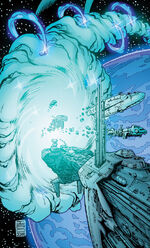
One of Sidious's Force storms decimates the New Republic Defense Fleet at the Battle of Pinnacle Base.
Sidious was also the only known being capable of producing a Force storm of his own power, a dark side technique which he himself discovered, and that had enough power to kill an entire world.[184] Using his anger and his will, he was able to rip the space-time continuum and create a hyperspace wormhole. It should be noted that even though he claimed to be able to conjure a storm simply by willing it, by his own admission he was not able to fully control it. By 10 ABY, however, the Emperor believed himself fully capable of controlling a Force storm, and it took the combined efforts of Luke, Leia, and the unborn Anakin Solo through the light side to turn his dark side creation against him.[164]
Another very dangerous and advanced Force technique utilized by the Emperor was the ability to use the Force to transfer his essence, as well as the essences of others, which he used to survive death on at least two occasions.[157] He had a supply of clone bodies ready to house his spirit until the last one succumbed to his own corrupting power and the sabotage of his subordinates.[159] He also, when taking over a host's body, overwrote the soul and personality of the being to fully dominate over it. He used this power not only as a pathway to immortality, but also as a particularly cruel and sadistic form of torture; it is known that he killed and resurrected Imperial engineer Bevel Lemelisk seven times as punishment for the destruction of the first Death Star.[18] Palpatine was also able to transfer his spirit into the bodies of individuals who were biologically unrelated to him. After his first death, his spirit was able to possess the body of Jeng Droga, though Palpatine's power drove Droga completely insane for a time. He also intended to possess the body of Anakin Solo after the genetic material for his clone bodies was sabotaged, though he never got the chance to do so.[185] He also possessed some knowledge on the manipulation of midi-chlorians, having done so with Darth Plagueis in a Grand Experiment taking place in 42 BBY that indirectly and unwittingly resulted in the birth of the Chosen One, Anakin Skywalker. He was unable to fully master the technique prior to murdering Plagueis, though he claimed to have a level of competence with the technique that would have enabled him to save Plagueis while he was suffocating.[1]
Among the Emperor's powers was the ability to channel the collective life essences of billions to sustain himself and his Dark Side Adepts; his victims would live in a dream-like state while his own power grew. The entire population of Byss lived under this spell until the planet's destruction by the Galaxy Gun.[105] It was mentioned by Luke Skywalker that the Emperor's very voice had a hypnotic lull to it whenever he was outwardly projecting his dark side Force powers. Darth Sidious was highly adept at foreseeing the future, often utilizing the power to see his plots to fruition, ensuring that all would proceed as he had envisioned.[3] Furthermore, Sidious was a master of Force stealth, able to hide his dark nature from the Jedi Order for many years before allowing himself to be discovered. Sidious was so powerful in the dark side that he was able to cloud the Jedi's vision, making it exceedingly difficult to predict future events.[13] This allowed him to bide his time and plot his rise to power while the Jedi were unable to sense him.[186]
Sidious was also capable of enhancing force sensitivity on other people through the use of rituals. He used several of these rituals to enhance his Dark Side Elite's force powers.
Upon spending decades immersing himself in the many facets of the Force, it was believed that Sidious had a mastery over all known powers, previously unknown powers, and could create new abilities on a whim.[156] By the time of his final death, he had become a nexus of the dark side capable of tearing apart the fabric of space.[164]
- "Conquer the temptation to create specimens that are superior in every way. The danger of such monstrosities being turned against you is too great."
- ―Palpatine, from The Creation of Monsters.
Sidious was a master of Sith alchemy, an ancient art he was taught by Darth Plagueis.[10][92] He wrote about alchemy in The Creation of Monsters, the unfinished last part of his Dark Side Compendium. He rediscovered the long-forgotten art of creating chrysalides, and used it to alchemically alter rancors into fearsome chrysalis beasts used as pets at his Citadel on Byss.[187] He also created Shadow Droids, hybrid mechanic/organic starfighters controlled by his own will, used against the Republic after his return in a clone body.[159] He may have also used alchemy to hide his true face from the Jedi and the rest of the galaxy as a senator and Chancellor of the Republic.[188] The Dark Lord also possessed knowledge of Sith magic, allowing him to use arcane rituals to detect poisons and drugs in food and drink.[1] He also could utter incantations in the Balc language.[161]
By the time of the Battle of Endor, even with his advanced age, the Emperor was still extremely potent in the usage of the Force. His usage of the Force sustained him beyond his natural lifespan, and derived his powers of persuasion and control from it.[169] Sidious' Force abilities were extensive and potent enough that even overpowering him in direct combat at full power required a large amount of Force-sensitives with each possessing a strong potential in the Force, as was best demonstrated when he was captured by Zaarin's forces with the aid of Lyn and her students aboard the Majestic[136] and when he was defeated over Pinnacle Base by the combined efforts of Luke Skywalker, Leia Skywalker, and then-unborn Anakin Solo.[164] His power was also such that even after death, it required every single deceased Jedi Knight to keep Sidious from escaping Chaos and wreaking havoc on the Galaxy.[189] In addition, the primary motivation behind Vader's search for a powerful apprentice was simply to aid him in killing the Emperor; Vader had no confidence in his ability to defeat Sidious, whom he considered to be the greatest Sith Lord in history, without aid.[182]
Behind the scenes
- "He's the great political manipulator of all time. I imagine he's evil from birth, which is a terrible thing to imagine."
- ―Ian McDiarmid, speaking about his character
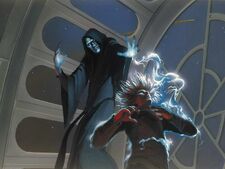
Palpatine concept art by Ralph McQuarrie.
From the very beginning of the writing process on Star Wars, George Lucas had in mind a character that would eventually develop into the Emperor as he is currently known. One of the earliest documents—perhaps the earliest—regarding the project is a paper dating to early 1973, a roster of names he compiled to potentially use in the story, many of which were not used. At the very top of this list is the name "Emperor Ford Xerxes XII" (Xerxes was a historical Persian king who was assassinated by his own son), soon after changed to "Alexander Xerxes XII," then "Emperor of Decarte."
Similar to the Ewoks in Return of the Jedi, Palpatine was never actually identified by name on-screen in the Original Trilogy, as he was referred to by his title of leadership (or in the case of Vader, "Master"). His name was supplied in supplementary materials such as the Star Wars Visual Dictionary, the novelization for Return of the Jedi, and the script for the film. It wasn't until The Phantom Menace that his name was identified on-screen.
Political, historical, and mythological allegory
- "You sort of see these recurring themes where a democracy turns itself into a dictatorship, and it always seems to happen kind of in the same way, with the same kinds of issues, and threats from the outside, needing more control."
- ―George Lucas
Like many personalities in the Star Wars universe, parallels can be drawn between Palpatine's character and certain historical figures. Dictators such as Julius Caesar, Napoleon Bonaparte, Adolf Hitler, Joseph Stalin, Ferdinand Marcos and Alberto Fujimori used methods similar to the Emperor's while turning their respective republics into personal dictatorships. Some commentators see similarities between Palpatine and Abraham Lincoln, who also centralized political power in response to a secessionist Confederacy. But, unlike Palpatine, Lincoln laid his powers down upon the southern Confederacy's defeat. Palpatine's method of implicating Senators in a false conspiracy during his Declaration of a New Order is similar to that of Joseph McCarthy during the Second Red Scare in 1950s America. But, unlike Palpatine, McCarthyism was based on actual acts of espionage by communist spies. Additionally, whereas Palpatine was not publicly exposed as fraudulent, McCarthy was eventually discredited in a Senate Committee hearing for his exaggeration of conspiracies extending to U.S. citizens whom, at that time, were believed to have little or no associations to the Communist Party or its members. On a related note, in the director's commentary for Return of the Jedi, George Lucas cited his inspiration of the scene where Palpatine landed on the Death Star as being the May Day parades within the Soviet Union.[190]
During the 2005 release of Revenge of the Sith, many viewers compared Palpatine to U.S. President George W. Bush (a parallel picked up by the Expanded Universe; such Bush parallels as the "Triad of Evil" and the "Homeworld Security Command" have been added to Star Wars continuity). George Lucas has denied writing Palpatine specifically as an allegory for Bush, pointing out to the Associated Press that he wrote the original drafts of the Star Wars films during the mid-1970s, inspired by then-US President Richard Nixon and the constitutional crisis he ignited that caused the fall of his administration. Lucas did, however, claim in an interview conducted by Maureen Dowd of the New York Times, regarding Vice President Dick Cheney's comparing himself as Darth Vader, that Cheney's actually closer to Palpatine.[191]
He also had some traits similar to the character Ebeneezer Scrooge from Charles Dickens' A Christmas Carol, such as a hatred for Christmas (or in this particular case, Life Day), as evidenced by an article for the Star Wars Galaxies website where the editor stated that, "The Emperor could not be reached for comment, but his publicist did have this to say: "While the Emperor refuses to acknowledge the efforts by the Rebel Alliance, he would like to issue an official 'Bah, humbug!' to those participating in the holiday.""[174] In addition, the backstory for Palpatine that was given in Darth Plagueis held several similarities to Lord Voldemort's backstory in the Harry Potter series, including dropping his full name out of spite for his father, and later killing off his entire family and changing his name. In addition, Film Critic Roger Ebert and Film Historian Robin Wood noted that Palpatine's appearance resembled Death from the 1957 Swedish film The Seventh Seal[192] and the wicked queen's witch form in the Disney adaptation of Snow White and the Seven Dwarves,[193] respectively. The latter of whom, coincidentally, gained her disfigurations in a similar manner to Palpatine regarding lightning that she summoned (in the Queen's case, she summoned it as an ingredient to create her peddler disguise to kill Snow White).
Thus, though the character's creator was inspired by certain real life figures, it is probable that it is Palpatine's nature as an archetypal dictator rather than deliberate, specific references which make him seem similar to any politician who a viewer sees as an actual or potential tyrant.
Emperor Palpatine and Vader escorted by several of the Emperor's Royal Guards.
In many ways, Palpatine is an archetypal villain, whose only motivation seems to be pursuing and maintaining power. Nonetheless, he relies on deception and manipulation to control and corrupt individuals throughout the films and Expanded Universe, and as a result is a classically diabolical character. As the Emperor, he appears to be a frail, weak old man, but is actually quite supernaturally powerful. Palpatine may be viewed as the quintessential wolf in sheep's clothing.
Emperor Palpatine also shares many similarities with the concept of a biblical Antichrist, who would be a person that would come during a time of turmoil; be a solitary, charismatic person who leads and unifies during a time of crisis, promising peace and prosperity; and be heralded as a savior. Of course, as his rule would grow longer, he would become less amiable and more sinister as his rule solidified and eventually lead to a time of tribulation and violence. The Antichrist would eventually be defeated by a Messiah- or Christ-like figure just as Palpatine was eventually defeated by Anakin Skywalker, the Chosen One.
Original version
Palpatine was originally conceived as a much different type of person. He was neither a user of the Force nor a great political strategist; instead, he was a weak-willed dullard with delusions of grandeur who had been elevated, first to President of the Republic and then Emperor, by his plotting ministers (such as Tarkin) who controlled the Republic/Empire by controlling Palpatine, a figurehead controlled by the Imperial bureaucracy.[46]
Although this version of Palpatine appeared (through descriptions and recollections) in the Episode IV novelization, it is obviously superseded by every other appearance since which revealed Palpatine to be the mastermind of the events of the Star Wars saga. However, this description was briefly alluded to in the in-universe history article Tinker, Tailor, Soldier, Praji on Hyperspace by the titular character.[173]
Aside from this, although after Episode V, it was clear Palpatine was a Force-user, it was not made explicitly clear that he was a Sith until the prequel trilogy; before that, several Expanded Universe sources had even implied that Palpatine was not a Sith for example, in the Shadows of the Empire Sourcebook, the character stats for Palpatine refer to him as a Jedi Master instead of a Sith while Vader is referred to as a Dark Lord of the Sith. Nonetheless, his connection to the Sith was implied, although not explicitly stated, as early as Empire's End, where he visited a Sith tomb on Korriban and also claimed that he had visited the planet ten years prior.
Portrayal
Ian McDiarmid played the elderly Emperor Palpatine of the original trilogy, the younger Palpatine of The Phantom Menace, and the middle-aged Palpatine of Attack of the Clones and Revenge of the Sith. The holographic image of the Emperor that briefly appeared in the original version of The Empire Strikes Back was played by Elaine Baker, then-wife of makeup designer Rick Baker. Her face was composited with the image of a chimpanzee for the eyes while the voice was provided by Clive Revill. One of the candidates to play the Emperor in Return of the Jedi was Ben Kingsley. When Kingsley, who had just finished shooting for the 1982 film Ghandi at the time, read the script, he considered Palpatine to "be 'very English.'"[194]
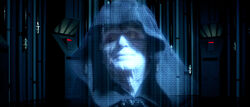
Ian McDiarmid as Emperor Palpatine in the The Empire Strikes Back DVD.
For the 2004 DVD release of the original trilogy, the scene in The Empire Strikes Back was re-shot with Ian McDiarmid replacing Revill as the Emperor, with new lines recorded for both McDiarmid and James Earl Jones (the voice of Darth Vader). The re-shoot was shot as part of the Revenge of the Sith production.
Elaine Baker as Emperor Palpatine in the pre-DVD version of The Empire Strikes Back.
His lightsaber sequences during Revenge of the Sith, especially his fight with Mace Windu, were done by Kyle Rowling (also the stunt double for Christopher Lee) and Bob Bowles. Much like Lee, his face would be replaced in post production by McDiarmid's. Sebastian Dickins performed Palpatine's acrobatics, but when the Emperor broke the laws of physics, a digital stunt double was used for his most inhuman and spectacular feats.
Nick Jameson voiced Palpatine in the Star Wars: Clone Wars cartoon series as well as different video games, including Star Wars: TIE Fighter, Star Wars: Galactic Battlegrounds, and Star Wars: Battlefront II, and in the Dark Empire audio adaptation by Time Warner Audio Publishing. Palpatine was voiced by Sam Witwer for the Star Wars: The Force Unleashed video game. In Star Wars: The Clone Wars film and TV series, Palpatine was voiced by Ian Abercrombie until his death on January 26, 2012, with famed British actor Tim Curry taking over the role.
For The Empire Strikes Back and Return of the Jedi National Public Radio dramatizations, Palpatine was voiced by Paul Hecht. Spanish actor Jordi Dauder dubbed the voice of Palpatine for the Spanish-language versions of the Prequel trilogy films.[195][196]
Emperor's "slugs"
The "Emperor's slugs," also called the "Emperor's black spot," refers to a solid black area on the edge of Emperor Palpatine's hood in Return of the Jedi. The dark spot is actually a bit of hand-drawn animation. Although no definitive answer exists, Pablo Hidalgo learned from someone at Lucasfilm Ltd. that the spot was likely added because the "particular low angle revealed a rather strange fold in the Emperor's temple that drew attention away from his eyes."[197]
Commentary
In a January 24, 2002 Star Wars Insider interview, Ian McDiarmid compared Palpatine's character to that of Shakespeare's Iago, the villain in the play Othello:
- "Everything he does is an act of pure hypocrisy, and that's interesting to play. I suppose it's rather like playing Iago. All the characters in the play—including Othello until the end—think that 'Honest Iago' is a decent guy doing his job, and he's quite liked. But at the same time there's a tremendous evil subconscious in operation. There's a moment in one scene of the new film where tears almost appear in his eye. These are crocodile tears, but for all those in the movie, and perhaps watching the movie itself, they'll see he is apparently moved—and of course, he is. He can just do it. He can, as it were, turn it on. And I suppose for him, it's also a bit of a turn-on; the pure exercise of power is what he's all about. That's the only thing he's interested in and the only thing that can satisfy him, which makes him completely fascinating to play, because it is an evil soul. He is more evil than the devil. At least Satan fell; he has a history, and it's one of revenge."
In a recent interview, McDiarmid commented on this complex character:
- "He has a black, irredeemable heart. There's nothing that can be said about him that's good. When we first saw Vader in the original trilogy, we thought he was the heart of darkness, and nobody could be darker. But now we understand what happened to him. And one of the exciting things about seeing this movie is that you can follow Vader through Anakin's journey every step of the way even if you don't agree with the choices he's making. In part his decisions stem from his traumatic childhood, and his impatient lust for power. And it's that which my character takes and then uses against him."
- ―Ian McDiarmid
Non-canon alternative death
- "Excellent work, my apprentice. There are none left to oppose us. The galaxy is ours now."
- ―Darth Sidious to Darth Vader
In the video game Star Wars Episode III: Revenge of the Sith, the final cutscene of the game, titled "The Ultimate Revenge of the Sith," features Emperor Palpatine dying by Darth Vader's hand. In this version, Vader defeated Obi-Wan Kenobi on Mustafar and returned to his master. The Emperor congratulated the fallen Skywalker, proclaiming that they could now rule the galaxy together. He then handed his apprentice a new red-bladed lightsaber, symbolizing his full transition into a Sith. Without warning, Lord Vader flipped the weapon into the air and ignited it after turning to catch it, stabbing it through Lord Sidious' chest. As the Emperor collapsed, the Dark Lord declared, "No. The galaxy belongs to me!"
The Ultimate Sith Edition
- "You had such promise. You could have been my successor. My equal. But now… But I may still have some small use for you. I still have enemies to find and destroy. You will do my bidding until I find a new apprentice. And then, like Vader, you will be cast aside. Finish him."
- ―Emperor Palpatine to Lord Starkiller
While Palpatine subdued Rahm Kota with Force lightning, Galen Marek gave in to his hatred for Darth Vader and chose to destroy his former Master rather than save the Jedi Master. After Vader's death at the hands of his own apprentice, Palpatine was pleased to be rid of Vader's "dead weight" and applauded Marek's actions with enthusiasm. He bitterly lamented to the apprentice on how Vader was nothing more than a broken shadow of the young man he once was, and how it was his intention to one day replace Vader with Marek. But before Palpatine could officially declare his apprentice as a true Sith Lord, the Emperor required Marek to complete a final test—forsake the Jedi forever by killing Kota. As the apprentice raised his blade to strike down the fallen Jedi General, Marek suddenly turned and attempted to kill the Emperor, only for his blade to be blocked by Palpatine's own lightsaber. Having anticipated Marek's treachery, the Emperor blasted the Sith assassin with lightning just before using the Force to crash the Rogue Shadow into Marek.[116]
When the apprentice awoke on an operating table, Palpatine was deeply disappointed in how similar Marek's fate was to Vader's condition. The Emperor declared that the apprentice would serve until a new candidate could be chosen, at which point Marek would be discarded as Vader was before him. As Palpatine turned to leave, Galen Marek was left in excruciating pain as the surgical droids recreated him into Lord Starkiller.[116]
As the Emperor's new apprentice and personal assassin, Lord Starkiller was charged with destroying the Rebel Alliance. While searching the planet Tatooine for the droids that possessed the Death Star's schematics, Starkiller was contacted by his Master. Palpatine was visibly displeased with his apprentice's lack of progress and commanded him to utilize the spy network of Jabba the Hutt in order to find the droids and the missing plans. Although Starkiller assured his Master that there would be no failure on his own part, the Emperor was less than optimistic. Even though Starkiller did succeed in locating the droids and killing Obi-Wan Kenobi in the process, he was unable to retrieve them due to Kenobi's intervention.[198]
After the destruction of the Death Star, Lord Starkiller led Emperor Palpatine's forces in the Battle of Hoth. Shortly after his first encounter with Luke Skywalker, Starkiller was reminded by his liaison that the Emperor wanted Skywalker taken alive, most likely to replace Starkiller as he once promised. Although he obeyed his Master's wishes and succeeded in turning the fallen Jedi to the dark side, Starkiller took Skywalker as his own apprentice after defeating him in battle.[198]
The Force Unleashed II: The Battle of Endor
- "A Great Day, Lord Vader. Today marks the death of the Rebellion and the birth of a new era of peace for the Empire. There is but one last detail to take care of. Do you take me for a fool? Your feeble schemes to overthrow me using that pathetic clone of your former apprentice were pitifully obvious from their inception. Now, Skywalker…you will die."
- ―Emperor Palpatine, to Darth Vader
In the year 4 ABY of an alternate timeline, Emperor Palpatine and Darth Vader surveyed the construction of the second Death Star during the Battle of Endor—just as they had done in the canon storyline. In this timeline, however, Luke Skywalker died on the planet Hoth. Skywalker's untimely death necessitated Leia Organa's secret training as a Jedi, thus forcing her to take the place of her late brother.[199]
As the fighting continued between Imperial and Alliance forces, the Dark Apprentice, Vader's personal assassin and the only perfect clone of the original Starkiller, traveled to the Forest Moon of Endor. After landing the Rogue Shadow near the Imperial shield generator bunker, the apprentice single-handedly annihilated everyone that stood in his way, Imperials and Rebels alike. His victims included the Rebel heroes Chewbacca, Han Solo and Leia Organa.[199]
Meanwhile, on the battle station, Emperor Palpatine gloatingly declared that the destruction of the Rebellion would usher in a new age of peace for the Galactic Empire. At that moment, however, the Emperor also revealed his awareness of Vader's treacherous intentions and the dark clone's existence. When he threatened to execute Vader for treason, Vader activated his lightsaber in an attempt to strike down his own master.[199]
Undaunted by his apprentice's sudden act of defiance, Palpatine easily subdued the cybernetic Sith Lord with Force lightning. He then ordered his Imperial forces to destroy the clone. But as the Imperials converged on the clone's location, the Dark Apprentice showed no signs of fear or apprehension.[199]
Clone Wars: Infinities: What if the Father never rescued Anakin from the Dark Side?
After Anakin fell under the influence of the Son and returned to the regular plane of the universe, Palpatine sensed the Son's presence with Anakin and was disturbed. Because of this, he was forced to unveil his Sith identity to Yoda and call a temporary truce between the Jedi and the Sith in order to stop Anakin and the Son. However, despite the team up between Darth Sidious and Yoda, Anakin proved far too strong for either of them and effortlessly defeated them.[200]
Star Tours Weekends 2014 Extended! (Thanks to Darth Sidious)
At some point during the Galactic Civil War, Emperor Palpatine, or rather, Darth Sidious, issued via HoloNet a new galactic decree to his Galactic Empire mandating that the Imperials create a demonstration of force and power above Disney's Hollywood Studios during Star Wars Weekends 2014. The Rebel Alliance intercepted the broadcast via an astromech droid and decided to extend the gala for one more weekend.[201]
Debates and discrepancies
Appearance
- "Palpatine, who has delved extensively into Sith lore, was using an almost-forgotten technique to hide his true self."
- ―Gary M. Sarli, Jedi Counseling 71

Two versions of Palpatine.
During his confrontation with Mace Windu, Palpatine's appearance changed as he was hit with his own Force lightning deflected from Windu's lightsaber.[23] Palpatine went from being a handsome middle-aged man to having a deeply lined face with burning yellow eyes, scarred grayed skin, and rotten teeth.[10] What caused this radical change of appearance has been the subject of much debate.
In Jedi Counseling 71, published in 2005 on the website for the Wizards of the Coast Star Wars Roleplaying Game, Star Wars roleplaying game author Gary M. Sarli was asked what exactly happened to Palpatine's face: is he scarred, or is he dropping a disguise?[188]
- "There are problems with both these ideas: The idea that he was physically damaged by the Force lightning doesn't match Return of the Jedi. Luke was being hit by Force lightning for some time, and he wasn't scarred like that. On the other hand, if Palpatine was using an Illusion-assisted Disguised check… he couldn't possibly keep it up continually. Moreover, Illusion is a mind-influencing Force power. It doesn't work on droids or recordings (in other words, someone might notice that he doesn't look the same in recorded speeches), nor would it work when projecting a holographic image across the galaxy. Finally, one would wonder why he maintained the illusion in his earlier holographic appearances as Darth Sidious. It would seem more prudent to "turn it off" to preserve the Palpatine identity."
- ―Gary M. Sarli, Jedi Counseling 71
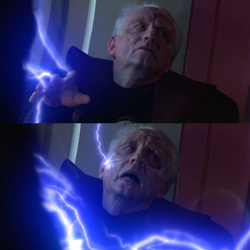
Two phases in Palpatine's transformation.
Sarli concluded that Palpatine was using Sith alchemy to hide his face under a younger-looking facade. The technique Sarli identified was given the name "mask," which used Sith alchemical techniques to alter the user's features, either to make them appear more horrific or to conceal them with a fairer appearance. According to the roleplaying game stats he presented in response to the question, this was considered different from a mundane disguise (which was temporary) or cosmetic surgery (which needed much more time to use). Instead, this alchemical mask altered the subject at the molecular level, rendering the subject's genuine appearance undetectable by sensors or even by a medical examination. The mask could be dispelled by another dark side power—in Palpatine's case, Force lightning—and should the subject fail to repel the dispelling power, the mask would be dropped and the subject's true face would appear. The sudden transformation would physically distort the subject with dark side energies, making any future attempt to use the "mask" ability, even to create a mundane disguise, far less successful. According to Sarli, Palpatine may have voluntarily failed the save and dropped the mask when it no longer served his purposes—he used the damage both to sway Skywalker into intervening on his side, and to convince the Senate and the galaxy at large that the Jedi had attempted to murder him. The consequence of this is that Darth Sidious's true face, whatever it was before this point, was distorted into the ruined countenance that would be seen for the remaining Star Wars films.[188]
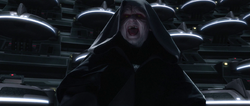
The frequent use of the dark side took its toll on Palpatine's features.
Sithisis depicts Sidious literally changing his face from pale and wizened into the benevolent countencance of Chancellor Palpatine with a Sith ritual,[202] and in The Unifying Force, Luke Skywalker muses that Palpatine had been "prematurely wizened by years of calling on dark power".[203] Star Wars: The Visual Dictionary also mentions that his usage of the dark side of the Force had kept him alive well beyond his natural lifespan, and that he was still powerful despite his aged and sickly appearance.[169] Moreover, Sidious's hands (and presumably his entire body) remained unchanged after the disfiguration of his face. The next time he was seen, he had pale, swollen hands with long, black fingernails.[10] Ian McDiarmid also stated in an interview that his healthy-looking appearance was in fact a disguise, and the disfigured visage was his true face.[85]
Name
There has been a great deal of speculation among fans concerning Palpatine's name. When Steve Sansweet, director of Lucasfilm's content management and a member of the corporation's inner circle, was asked about this issue as part of the "Ask the Lucasfilm Jedi Council" feature of StarWars.com in 2003, he responded that Palpatine's first name is unknown, and that may not even have one, citing the example of Indonesia as a real country where mononymous people are very common.[204]

The fact that Palpatine has no first name was revealed, among other details of his life, in James Luceno's Darth Plagueis.
The matter was settled in James Luceno's Darth Plagueis, which, though it did not go so far as to actually reveal Palpatine's full name, did reveal that Palpatine chose not to have a first name in order to spite his family, and in particular his father. The novel established that Palpatine was in fact a family name. In keeping with various sources that have described Palpatine as a noble, the book also established House Palpatine, the Emperor's family of origin, as one of many Naboo noble families, and placed it into the context of wider Naboo society.[1] Palpatine's Sith name, Darth Sidious, is believed to be derived from "insidious," a word with multiple meanings, such as "treacherous," "cunning," and "seductive".[205]
The real-world origin of the name "Palpatine" is not known, but the in-universe origins of the name were revealed to be obscure in Luceno's novel Plagueis—in Palpatine's own time, it was considered to be either an ancient name of state among noble families of Naboo, in accordance with the previously established Naboo custom of noms de règne (like "Amidala"), or perhaps borrowed from one of the ancient regions of the planet.[1] The name is not unique in Star Wars canon: Lieutenant Colonel Palpatine Essex Yerac of the Rebel Alliance shares it with the Emperor[206] (as well as the possibly pseudonymous editor and broadcaster for the Galactic Weekly NewsStack known as "Palpatine II").[207]
In his article Speak Like a Sith, published in the 134th issue of the Star Wars Insider magazine, Ben Grossblatt, the creator of the Sith language (of which the Emperor has been established as a master in both speech and writing)[37] for Book of Sith, remarked that, assuming that the name "Palpatine" had the same roots as the verb "palpitare," meaning "to throb," then one way it could be translated in Sith (by hypothetical "creative Sith scribes") would be Chirikyât ("chee-ree-kyatt"), meaning "He Who Causes Them to Throb and Tremble in Fear". In the same article, Grosblatt also established that a native Sith speaker with a heavy accent would be unable to properly pronounce "Palpatine" in its proper form, rendering it as "Marmûtin" ("mar-muh-tin") because of the limited phonetic palette of the language, which lacks a "p" sound, an "l" between consonants, and an "ee" sound in a closed syllable.[208]
First death
In the Dark Empire series, Palpatine tells Luke that the Battle of Endor was not his first death, and that he had started transferring his spirit into clone bodies years prior to that, when his original body had degenerated as a result of heavy use of the dark side.[209] However, Lucasfilm official Leland Chee has stated that Palpatine was lying to Luke about having died previously, and that Palpatine's demise on the second Death Star was definitely the first time he died.[210]
Appearances
Non-canon appearances
Sources
Notes and references
See also
External links
 Palpatine on Wikipedia
Palpatine on Wikipedia Chancellor Palpatine at the Internet Movie Database
Chancellor Palpatine at the Internet Movie Database Power Smile on StarWars.com (content now obsolete; backup link)
Power Smile on StarWars.com (content now obsolete; backup link)- Template:SWSB




